Organic Light Emitting Compound And Organic Electroluminescence Device Using Same
KIM; Hongsuk ; et al.
U.S. patent application number 16/462359 was filed with the patent office on 2019-12-05 for organic light emitting compound and organic electroluminescence device using same. This patent application is currently assigned to DOOSAN CORPORATION. The applicant listed for this patent is DOOSAN CORPORATION. Invention is credited to Hyungchan BAE, Hoe Moon KIM, Hongsuk KIM, Young Bae KIM, Ho Jun SON.
| Application Number | 20190367477 16/462359 |
| Document ID | / |
| Family ID | 62146583 |
| Filed Date | 2019-12-05 |


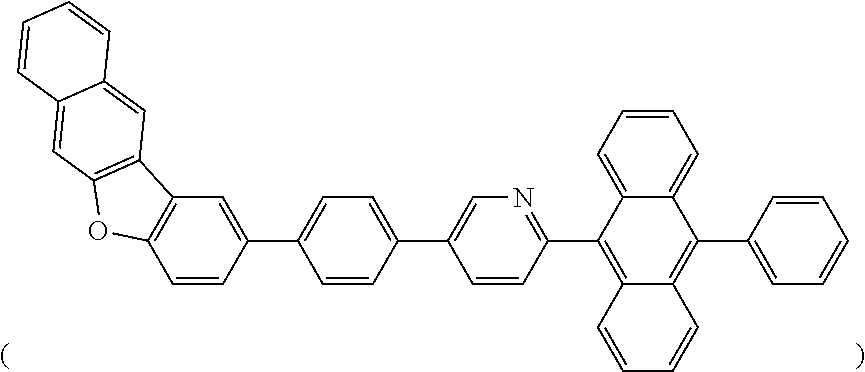





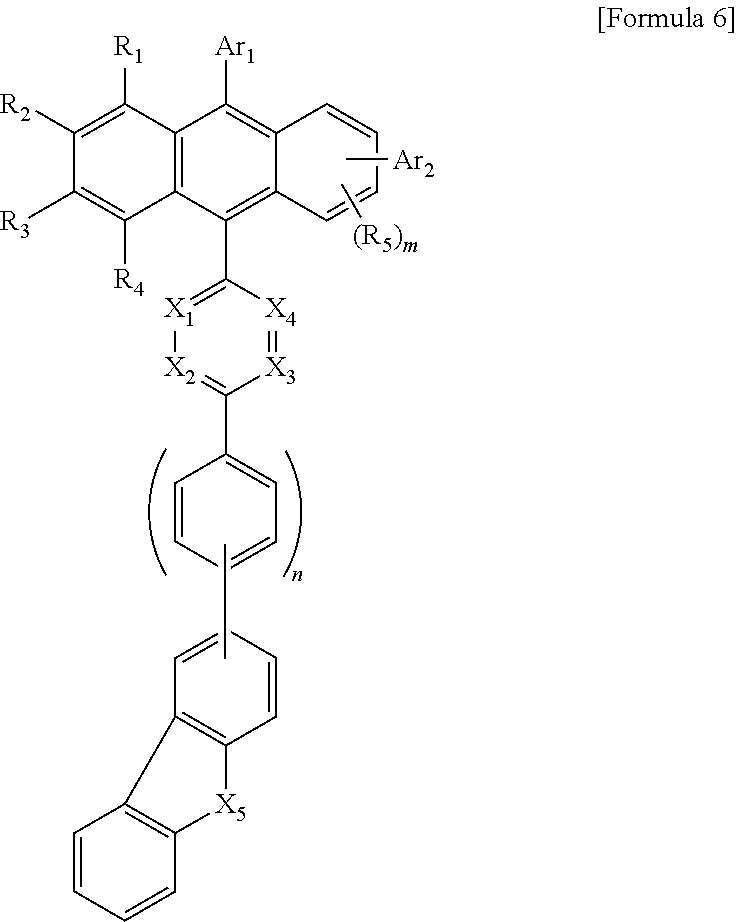



View All Diagrams
| United States Patent Application | 20190367477 |
| Kind Code | A1 |
| KIM; Hongsuk ; et al. | December 5, 2019 |
ORGANIC LIGHT EMITTING COMPOUND AND ORGANIC ELECTROLUMINESCENCE DEVICE USING SAME
Abstract
The present invention relates to a novel compound having excellent functions, such as electron injection and transport and light emission functions, and an organic electroluminescence device. By using the novel compound in an organic material layer of the organic electroluminescence device, properties of the device such a light emitting efficiency, driving voltage, and life can be improved.
| Inventors: | KIM; Hongsuk; (Yongin-si, KR) ; KIM; Young Bae; (Yongin-si, KR) ; KIM; Hoe Moon; (Yongin-si, KR) ; SON; Ho Jun; (Yongin-si, KR) ; BAE; Hyungchan; (Yongin-si, KR) | ||||||||||
| Applicant: |
|
||||||||||
|---|---|---|---|---|---|---|---|---|---|---|---|
| Assignee: | DOOSAN CORPORATION Seoul KR |
||||||||||
| Family ID: | 62146583 | ||||||||||
| Appl. No.: | 16/462359 | ||||||||||
| Filed: | November 21, 2017 | ||||||||||
| PCT Filed: | November 21, 2017 | ||||||||||
| PCT NO: | PCT/KR2017/013248 | ||||||||||
| 371 Date: | May 20, 2019 |
| Current U.S. Class: | 1/1 |
| Current CPC Class: | C07F 5/025 20130101; H01L 51/5056 20130101; C07D 405/14 20130101; H01L 51/5092 20130101; C07D 401/10 20130101; H01L 51/0056 20130101; H01L 51/5012 20130101; H01L 51/0067 20130101; H01L 51/0054 20130101; C07D 409/04 20130101; H01L 51/0074 20130101; H01L 51/0058 20130101; C09K 11/06 20130101; H01L 51/0073 20130101; C07D 409/10 20130101; H01L 51/5072 20130101; H01L 51/0052 20130101; H01L 51/0072 20130101; C07D 213/06 20130101; C07D 405/04 20130101; C07D 401/04 20130101 |
| International Class: | C07D 401/10 20060101 C07D401/10; C07D 405/14 20060101 C07D405/14; C07D 401/04 20060101 C07D401/04; C07D 409/04 20060101 C07D409/04; C07F 5/02 20060101 C07F005/02; C07D 409/10 20060101 C07D409/10; C07D 213/06 20060101 C07D213/06; C07D 405/04 20060101 C07D405/04; H01L 51/00 20060101 H01L051/00 |
Foreign Application Data
| Date | Code | Application Number |
|---|---|---|
| Nov 21, 2016 | KR | 10-2016-0155319 |
Claims
1. A compound represented by the following Formula 1: ##STR00258## wherein, X.sub.1 to X.sub.4, which are the same or different from each other from each other, are each independently C(Ar.sub.3) or N, with the proviso that at least one of X.sub.1 to X.sub.4 is N, wherein Ar.sub.3 is present in a plural number, the plural Ar.sub.3's are the same or different from each other; n is an integer of 0 to 3; X.sub.5 is selected from the group consisting of S, O, N(Ar.sub.4), and C(Ar.sub.5)(Ar.sub.6); X.sub.6 represents a single bond or is selected from the group consisting of S, O, N(Ar.sub.7), and C(Ar.sub.8)(Ar.sub.9); Ar.sub.1 is selected from the group consisting of a C.sub.6-C.sub.60 aryl group and a heteroaryl group having 5 to 60 nucleus atoms or optionally combines with an adjacent group to form a fused aromatic ring or fused heteroaromatic ring; Ar.sub.2 is selected from the group consisting of hydrogen, a C.sub.6-C.sub.60 aryl group, and a heteroaryl group having 5 to 60 nucleus atoms or combines with an adjacent group to form a fused aromatic ring or fused heteroaromatic ring; Ar.sub.3 to Ar.sub.9 are the same or different from each other, and are each independently selected from the group consisting of hydrogen, deuterium(D), halogen, a cyano group, a nitro group, a C.sub.1-C.sub.40 alkyl group, a C.sub.2-C.sub.40 alkenyl group, a C.sub.2-C.sub.40 alkynyl group, a C.sub.3-C.sub.40 cycloalkyl group, a heterocycloalkyl group having 3 to 40 nucleus atoms, a C.sub.6-C.sub.60 aryl group, a heteroaryl group having 5 to 60 nucleus atoms, a C.sub.1-C.sub.40 alkyloxy group, a C.sub.6-C.sub.60 aryloxy group, a C.sub.1-C.sub.40 alkylsilyl group, a C.sub.6-C.sub.60 arylsilyl group, a C.sub.1-C.sub.40 alkylbron group, a C.sub.6-C.sub.60 arylboron group, a C.sub.6-C.sub.60 mono- or diarylphosphinyl group, and a C.sub.6-C.sub.60 arylamine group or each independently combine with an adjacent group to form a fused aromatic ring or fused heteroaromatic ring; R.sub.1 to R.sub.9 are the same or different from each other, and are each independently selected from the group consisting of hydrogen, deuterium(D), halogen, a cyano group, a nitro group, a C.sub.1-C.sub.40 alkyl group, a C.sub.2-C.sub.40 alkenyl group, a C.sub.2-C.sub.40 alkynyl group, a C.sub.3-C.sub.40 cycloalkyl group, a heterocycloalkyl group having 3 to 40 nucleus atoms, a C.sub.6-C.sub.60 aryl group, a heteroaryl group having 5 to 60 nucleus atoms, a C.sub.1-C.sub.40 alkyloxy group, a C.sub.6-C.sub.60 aryloxy group, a C.sub.1-C.sub.40 alkylsilyl group, a C.sub.6-C.sub.60 arylsilyl group, a C.sub.1-C.sub.40 alkylbron group, a C.sub.6-C.sub.60 arylboron group, a C.sub.6-C.sub.60 arylphosphine group, a C.sub.6-C.sub.60 mono- or diarylphosphinyl group, and a C.sub.6-C.sub.60 arylamine group or each independently combine with an adjacent group to form a fused aromatic ring or fused heteroaromatic ring; and m is an integer of 1 to 3; wherein the aryl group and the heteroaryl group in Ar.sub.1 and Ar.sub.2 are each independently unsubstituted or substituted with one or more substituent selected from the group consisting of a C.sub.1-C.sub.40 alkyl group, a C.sub.6-C.sub.60 aryl group, and a heteroaryl group having 5 to 60 nucleus atoms wherein the two or more substituents, if present, are the same or different from each other.
2. The compound of claim 1, represented by one of the following Formulas 2 to 5: ##STR00259## ##STR00260## wherein, R.sub.1 to R.sub.5, X.sub.1 to X.sub.6, Ar.sub.1, Ar.sub.2, m, and n are each the same as those defined in claim 1.
3. The compound of claim 2, wherein the compound represented by Formula 2 is a compound represented by the following Formula 6: ##STR00261## wherein R.sub.1 to R.sub.5, X.sub.1 to X.sub.5, Ar.sub.1, Ar.sub.2, m, and n are each the same as those defined in claim 1.
4. The compound of claim 3, wherein the compound represented by Formula 6 is a compound represented by the following Formula 7: ##STR00262## wherein, R.sub.1 to R.sub.5, X.sub.1 to X.sub.4, Ar.sub.1, Ar.sub.2, m, and n are each the same as those defined in claim 1, X.sub.7 represents a single bond or is selected from the group consisting of S, O, N(Ar.sub.10), and C(Ar.sub.11)(Ar.sub.12), and Ar.sub.10 to Ar.sub.12 are the same or different from each other, and are each independently selected from the group consisting of hydrogen, deuterium(D), halogen, a cyano group, a nitro group, a C.sub.1-C.sub.40 alkyl group, a C.sub.2-C.sub.40 alkenyl group, a C.sub.2-C.sub.40 alkynyl group, a C.sub.3-C.sub.40 cycloalkyl group, a heterocycloalkyl group having 3 to 40 nucleus atoms, a C.sub.6-C.sub.60 aryl group, a heteroaryl group having 5 to 60 nucleus atoms, a C.sub.1-C.sub.40 alkyloxy group, a C.sub.6-C.sub.60 aryloxy group, a C.sub.1-C.sub.40 alkylsilyl group, a C.sub.6-C.sub.60 arylsilyl group, a C.sub.1-C.sub.40 alkylbron group, a C.sub.6-C.sub.60 arylboron group, a C.sub.6-C.sub.60 mono- or diarylphosphinyl group, and a C.sub.6-C.sub.60 arylamine group.
5. An organic electroluminescent device, comprising an anode, a cathode, and one or more organic material layers interposed between the anode and the cathode, wherein at least one of the one or more organic material layers comprises a compound represented by the following Formula 1: ##STR00263## wherein, X.sub.1 to X.sub.4, which are the same or different from each other from each other, are each independently C(Ar.sub.3) or N, with the proviso that at least one of X.sub.1 to X.sub.4 is N, wherein Ar.sub.3 is present in a plural number, the plural Ar.sub.3's are the same or different from each other; n is an integer of 0 to 3; X.sub.5 is selected from the group consisting of S, O, N(Ar.sub.4), and C(Ar.sub.5)(Ar.sub.6); X.sub.6 represents a single bond or is selected from the group consisting of S, O, N(Ar.sub.7), and C(Ar.sub.8)(Ar.sub.9); Ar.sub.1 is selected from the group consisting of a C.sub.6-C.sub.60 aryl group and a heteroaryl group having 5 to 60 nucleus atoms or optionally combines with an adjacent group to form a fused aromatic ring or fused heteroaromatic ring; Ar.sub.2 is selected from the group consisting of hydrogen, a C.sub.6-C.sub.60 aryl group, and a heteroaryl group having 5 to 60 nucleus atoms or combines with an adjacent group to form a fused aromatic ring or fused heteroaromatic ring; Ar.sub.3 to Ar.sub.9 are the same or different from each other, and are each independently selected from the group consisting of hydrogen, deuterium(D), halogen, a cyano group, a nitro group, a C.sub.1-C.sub.40 alkyl group, a C.sub.2-C.sub.40 alkenyl group, a C.sub.2-C.sub.40 alkynyl group, a C.sub.3-C.sub.40 cycloalkyl group, a heterocycloalkyl group having 3 to 40 nucleus atoms, a C.sub.6-C.sub.60 aryl group, a heteroaryl group having 5 to 60 nucleus atoms, a C.sub.1-C.sub.40 alkyloxy group, a C.sub.6-C.sub.60 aryloxy group, a C.sub.1-C.sub.40 alkylsilyl group, a C.sub.6-C.sub.60 arylsilyl group, a C.sub.1-C.sub.40 alkylbron group, a C.sub.6-C.sub.60 arylboron group, a C.sub.6-C.sub.60 mono- or diarylphosphinyl group, and a C.sub.6-C.sub.60 arylamine group or each independently combine with an adjacent group to form a fused aromatic ring or fused heteroaromatic ring; R.sub.1 to R.sub.9 are the same or different from each other, and are each independently selected from the group consisting of hydrogen, deuterium(D), halogen, a cyano group, a nitro group, a C.sub.1-C.sub.40 alkyl group, a C.sub.2-C.sub.40 alkenyl group, a C.sub.2-C.sub.40 alkynyl group, a C.sub.3-C.sub.40 cycloalkyl group, a heterocycloalkyl group having 3 to 40 nucleus atoms, a C.sub.6-C.sub.60 aryl group, a heteroaryl group having 5 to 60 nucleus atoms, a C.sub.1-C.sub.40 alkyloxy group, a C.sub.6-C.sub.60 aryloxy group, a C.sub.1-C.sub.40 alkylsilyl group, a C.sub.6-C.sub.60 arylsilyl group, a C.sub.1-C.sub.40 alkylbron group, a C.sub.6-C.sub.60 arylboron group, a C.sub.6-C.sub.60 arylphosphine group, a C.sub.6-C.sub.60 mono- or diarylphosphinyl group, and a C.sub.6-C.sub.60 arylamine group or each independently combine with an adjacent group to form a fused aromatic ring or fused heteroaromatic ring; and m is an integer of 1 to 3; wherein the aryl group and the heteroaryl group in Ar.sub.1 and Ar.sub.2 are each independently unsubstituted or substituted with one or more substituent selected from the group consisting of a C.sub.1-C.sub.40 alkyl group, a C.sub.6-C.sub.60 aryl group, and a heteroaryl group having 5 to 60 nucleus atoms wherein the two or more substituents, if present, are the same or different from each other.
6. The organic electroluminescent device of claim 5, wherein the one or more organic material layers comprise a hole injection layer, a hole transport layer, a light-emitting layer, an electron transport layer, and an electron injection layer, the light-emitting layer including the compound represented by Formula 1 therein.
7. The organic electroluminescent device of claim 5, wherein the one or more organic material layers comprise a hole transport layer, a hole injection layer, a light-emitting layer, an electron transport auxiliary layer, an electron transport layer, and an electron injection layer, the electron transport auxiliary layer including the compound therein.
8. The organic electroluminescent device of claim 5, wherein the compound represented by one of the following Formulas 2 to 5: ##STR00264## ##STR00265## wherein, R.sub.1 to R.sub.5, X.sub.1 to X.sub.6, Ar.sub.1, Ar.sub.2, m, and n are each the same as those defined in claim 5.
9. The organic electroluminescent device of claim 8, wherein the compound represented by Formula 2 is a compound represented by the following Formula 6: ##STR00266## wherein, R.sub.1 to R.sub.5, X.sub.1 to X.sub.5, Ar.sub.1, Ar.sub.2, m, and n are each the same as those defined in claim 5.
10. The organic electroluminescent device of claim 9, wherein the compound represented by Formula 6 is a compound represented by the following Formula 7: ##STR00267## wherein, R.sub.1 to R.sub.5, X.sub.1 to X.sub.4, Ar.sub.1, Ar.sub.2, m, and n are each the same as those defined in claim 5, X.sub.7 represents a single bond or is selected from the group consisting of S, O, N(Ar.sub.10), and C(Ar.sub.11)(Ar.sub.12), and Ar.sub.10 to Ar.sub.12 are the same or different from each other, and are each independently selected from the group consisting of hydrogen, deuterium(D), halogen, a cyano group, a nitro group, a C.sub.1-C.sub.40 alkyl group, a C.sub.2-C.sub.40 alkenyl group, a C.sub.2-C.sub.40 alkynyl group, a C.sub.3-C.sub.40 cycloalkyl group, a heterocycloalkyl group having 3 to 40 nucleus atoms, a C.sub.6-C.sub.60 aryl group, a heteroaryl group having 5 to 60 nucleus atoms, a C.sub.1-C.sub.40 alkyloxy group, a C.sub.6-C.sub.60 aryloxy group, a C.sub.1-C.sub.40 alkylsilyl group, a C.sub.6-C.sub.60 arylsilyl group, a C.sub.1-C.sub.40 alkylbron group, a C.sub.6-C.sub.60 arylboron group, a C.sub.6-C.sub.60 mono- or diarylphosphinyl group, and a C.sub.6-C.sub.60 arylamine group.
Description
TECHNICAL FIELD
[0001] The present disclosure relates to a novel organic light-emitting compound and an organic electroluminescent device using the same and, more particularly, to an anthracene-based compound having excellent electron injection and transport and light-emitting abilities, and an organic electroluminescent device containing the compound in at least one organic material layer thereof and having improved properties including emission efficiency, driving voltage, lifespan, etc.
BACKGROUND ART
[0002] In an organic electroluminescent element (hereinafter referred to as "organic EL device"), the application of a current or voltage across two opposite electrodes induces the injection of holes from the anode and electrons from the cathode into an organic material layer. The injected holes and electrons recombine with each other to generate excitons which then return to the ground state, emitting light. According to kinds of electron spin of the excitons formed, the organic electroluminescent elements may be classified into fluorescent light-emitting elements in which decay of singlet excitons contributes to the production of light through spontaneous emission and phosphorescent light-emitting elements in which decay of triplet excitons contributes to the production of light through spontaneous emission.
[0003] Electron spin of excitons formed by the recombination of electrons and holes may either be in a singlet state or a triplet state at a ratio of 25% singlet state: 75% triplet state. Fluorescent EL devices in which light is emitted by singlet excitons, theoretically does not exceed 25% in internal quantum efficiency and 5% in external quantum efficiency, based on the formation rate of a singlet excitons. When using as a phosphorescent host a metal complex compound including a heavy transition-metal atoms, such as Ir, Pt, etc., phosphorescent EL devices in which light is emitted by triplet exciton can exhibit emission efficiency four times as high as that of fluorescent light-emitting elements.
[0004] Theoretically, phosphorescent EL devices are higher in emission efficiency than fluorescent EL devices, as described above. In contrast to green or read phosphorescent EL devices, a host that meets the color purity of deep blue, high efficiency, and broad energy gap required in blue phosphorescent EL devices is underdeveloped and has not yet been commercialized so that blue fluorescent EL devices rather than blue phosphorescent EL devices have predominantly been employed in products thus far. For conventional blue fluorescent EL devices, studies have been directed toward using a material having substituents introduced at various positions of benzene rings as a sole host and a sole dopant so as to improve the emission color of the device, carrier transport properties, the stability of the film. For instance, DPVBi developed by Idemitsu Kosan or dinaphtylanthracene developed by Kodak is known as a blue fluorescent light-emitting layer material. However, such conventional blue fluorescent light-emitting layer materials are under a satisfactory level in terms of thermal stability and emission efficiency. Therefore, there is a need for the development of a luminescent material having an excellent performance.
DETAILED DESCRIPTION OF THE INVENTION
Technical Problem
[0005] An object of the present disclosure is to provide a novel organic compound that has excellent electron injection ability, electron transport ability, and luminescence ability and can be thus used as a light-emitting layer material or an electron transport auxiliary layer.
[0006] Another object of the present disclosure is to provide an organic electroluminescent device comprising the novel organic compound and exhibiting a low driving voltage, high emission efficiency, and improved lifespan.
Technical Solution
[0007] In order to accomplish the above objects, the present disclosure provides a compound represented by the following Formula 1:
##STR00001##
[0008] (wherein,
[0009] X.sub.1 to X.sub.4, which are the same or different from each other, are each independently C(Ar.sub.3) or N, with the proviso that at least one of X.sub.1 to X.sub.4 is N, wherein when Ar.sub.3 is present in a plural number, the plural Ar.sub.3's are the same or different from other;
[0010] n is an integer of 0 to 3;
[0011] X.sub.5 is selected from the group consisting of S, O, N(Ar.sub.4), and C(Ar.sub.5)(Ar.sub.6);
[0012] X.sub.6 represents a single bond or is selected from the group consisting of S, O, N(Ar.sub.2), and C(Ar.sub.8)(Ar.sub.9);
[0013] Ar.sub.1 is selected from the group consisting of a C.sub.6-C.sub.60 aryl group and a heteroaryl group having 5 to 60 nucleus atoms, or may combines with an adjacent group to form a fused aromatic ring or fused heteroaromatic ring;
[0014] Ar.sub.2 is selected from the group consisting of hydrogen, a C.sub.6-C.sub.60 aryl group, and a heteroaryl group having 5 to 60 nucleus atoms or combine with an adjacent group to form a fused aromatic ring or fused heteroaromatic ring;
[0015] Ar.sub.3 to Ar.sub.9, which are the same or different from each other, are each independently selected from the group consisting of hydrogen, deuterium(D), halogen, a cyano group, a nitro group, a C.sub.1-C.sub.40 alkyl group, a C.sub.2-C.sub.40 alkenyl group, a C.sub.2-C.sub.40 alkynyl group, a C.sub.3-C.sub.40 cycloalkyl group, a heterocycloalkyl group having 3 to 40 nucleus atoms, a C.sub.6-C.sub.60 aryl group, a heteroaryl group having 5 to 60 nucleus atoms, a C.sub.1-C.sub.40 alkyloxy group, a C.sub.6-C.sub.60 aryloxy group, a C.sub.1-C.sub.40 alkylsilyl group, a C.sub.6-C.sub.60 arylsilyl group, a C.sub.1-C.sub.40 alkylbron group, a C.sub.6-C.sub.60 arylboron group, a C.sub.6-C.sub.60 mono- or diarylphosphinyl group, and a C.sub.6-C.sub.60 arylamine group or each independently combine with an adjacent group to form a fused aromatic ring or fused heteroaromatic ring;
[0016] R.sub.1 to R.sub.9, which are the same or different, are each independently selected from the group consisting of hydrogen, deuterium(D), halogen, a cyano group, a nitro group, a C.sub.1-C.sub.40 alkyl group, a C.sub.2-C.sub.40 alkenyl group, a C.sub.2-C.sub.40 alkynyl group, a C.sub.3-C.sub.40 cycloalkyl group, a heterocycloalkyl group having 3 to 40 nucleus atoms, a C.sub.6-C.sub.60 aryl group, a heteroaryl group having 5 to 60 nucleus atoms, a C.sub.1-C.sub.40 alkyloxy group, a C.sub.6-C.sub.60 aryloxy group, a C.sub.1-C.sub.40 alkylsilyl group, a C.sub.6-C.sub.60 arylsilyl group, a C.sub.1-C.sub.40 alkylbron group, a C.sub.6-C.sub.60 arylboron group, a C.sub.6-C.sub.60 arylphosphine group, a C.sub.6-C.sub.60 mono- or diarylphosphinyl group, and a C.sub.6-C.sub.60 arylamine group or each independently combine with an adjacent group to form a fused aromatic ring or fused heteroaromatic ring; and
[0017] m is an integer of 1 to 3;
[0018] wherein the aryl group and the heteroaryl group in Ar.sub.1 and Ar.sub.2 are each independently unsubstituted or substituted with one or more substituent selected from the group consisting of a C.sub.1-C.sub.40 alkyl group, a C.sub.6-C.sub.60 aryl group, and a heteroaryl group having 5 to 60 nucleus atoms wherein the two or more substituents, if present, are the same or different from each other).
[0019] In addition, the present disclosure provides an organic electroluminescent device comprising an anode, a cathode and at least one organic material layer interposed therebetween, wherein the at least one organic material layer includes the compound represented by Formula 1 therein.
[0020] According to an embodiment, the at least one organic material layer may comprise a hole injection layer, a hole transport layer, a light-emitting layer, an electron transport layer, and an electron injection layer wherein the light-emitting layer may include the compound represented by Formula 1.
[0021] According to another embodiment, the at least one organic material layer may comprise a hole transport layer, a hole injection layer, a light-emitting layer, an electron transport auxiliary layer, an electron transport layer, and an electron injection layer wherein the electron transport auxiliary layer may include the compound.
Advantageous Effects
[0022] Exhibiting excellent electron injection and transport and luminescence properties, the compound, represented by Formula 1, according to the present disclosure can be used as a material for an organic material layer in an organic electroluminescent device.
[0023] Employing the compound represented by Formula 1 as a fluorescent host material or an electron transport auxiliary layer material, the organic electroluminescent device according to the present invention exhibits a higher luminescence performance, a lower driving voltage, a higher emission efficiency, and a longer lifespan than those comprising conventional host materials and can thus improve the performance and lifespan of the full-color display panels.
BRIEF DESCRIPTION OF THE DRAWINGS
[0024] FIGS. 1 to 3 are diagrams illustrating electron distributions of compounds R95, C1, and C2, respectively.
MODE FOR CARRYING OUT THE INVENTION
[0025] Below, a detailed description will be given of the present invention.
[0026] <Novel Organic Compound>
[0027] The compound, represented by Formula 1, according to the present disclosure has an anthracene as a basic structure in which a heteroaromatic ring moiety or aromatic ring moiety consisting of three or more rings, such as a dibenzofuran moiety, a benzocarbazole moiety, a fluorene moiety, a dioxin moiety, etc. is introduced onto the carbon atom at position 10 in the anthracene moiety through a divalent linker comprising nitrogen (N)-containing six-membered heteroarylene group while an aromatic ring or heteroaromatic ring is directly connected to the carbon atom at position 9 in the anthracene moiety. The compound represented by Formula 1 is superior in terms of electron transport and injection ability and luminescence ability. When included in an organic electroluminescent device, therefore, the compound of Formula 1 can improve the device in driving voltage, emission efficiency, lifespan, etc. Here, numbering of the anthracene molecule is as follows:
##STR00002##
[0028] As the anthracene moiety has a broad bandgap, the compound represented by Formula 1 can be useful as a host material.
[0029] In addition, the compound represented by Formula 1 exhibits an excellent electron injection and transport performance because the heteroaromatic ring moiety or aromatic ring moiety consisting of three or more rings is coupled with the divalent linker comprising the N-containing six-membered heteroarylene group, which is an electron withdrawing group (EWG) with high electron absorption, therein.
[0030] Furthermore, the compound of Formula 1 to which the N-containing six-membered heteroarylene group is directly introduced at position 10 on the anthracene moiety has an electron distribution expanded to the heteroarylene group and is lower in LUMO energy, compared to a compound having an arylene group bonded to the carbon atom at position 10 on the anthracene moiety or a compound to which a heteroarylene group is bonded via a linker other than directly. For example, as shown in FIG. 1, compound R95
##STR00003##
exhibits an electron distribution expanded to the heteroarylene group and has a LUMO energy level of 1.66 eV and a HOMO e
##STR00004##
nergy level of 1.73 eV. On the other hand, compound C1
##STR00005##
has a LUMO energy of 1.63 eV and a HOMO energy level of 1.73 eV and compound C2
##STR00006##
has a LUMO energy level of 1.61 eV and a HOMO energy level of 1.71 eV (see FIGS. 2 and 3). Thus, when applied as an electron transport and injection layer to an organic luminescent device, the compound of Formula 1 can improve the device in driving voltage, emission efficiency, and lifespan.
[0031] Therefore, when the compound represented by Formula 1 is used as a light-emitting layer material (preferably, fluorescent host) or an electron transport auxiliary layer material in an organic electroluminescent device, recombination capability between holes and electrons in the light-emitting layer can be enhanced by the compound of Formula 1, thereby improving the device in driving voltage, emission efficiency, and lifespan and moreover maximizing the performance of the full-color organic EL panel.
[0032] In Formula 1, X.sub.1 to X.sub.4, which are the same or different, are each independently C(Ar.sub.3) or N, with the proviso that at least one of X.sub.1 to X.sub.4 is N; preferably one of X.sub.1 to X.sub.4 may be N and the others may be C(Ar.sub.3). In this regard, when Ar.sub.3 is present in a plural number, they are the same or different from each other.
[0033] In Formula 1, n is an integer of 0 to 3 and preferably 0 or 1.
[0034] In Formula 1, X.sub.5 is selected from the group consisting of S, O, N(Ar.sub.4), and C(Ar.sub.5)(Ar.sub.6).
[0035] In Formula 1, X.sub.6 represents a single bond or is selected from the group consisting of S, O, N(Ar.sub.7), and C(Ar.sub.8)(Ar.sub.9), and preferably may represent a single bond.
[0036] In Formula 1, Ar.sub.1 is selected from the group consisting of a C.sub.6-C.sub.60 aryl group and a heteroaryl group having 5 to 60 nucleus atoms or combine with an adjacent group to form a fused aromatic ring or fused heteroaromatic ring, preferably is selected from the group consisting of a C.sub.6-C.sub.60 aryl group and a heteroaryl group having 5 to 60 nucleus atoms and more preferably from the group consisting of a C.sub.6-C.sub.30 aryl group and a heteroaryl group of 5 to 30 nucleus atoms.
[0037] In Formula 1, Ar.sub.2 is selected from the group consisting of hydrogen, a C.sub.6-C.sub.60 aryl group, and a heteroaryl group having 5 to 60 nucleus atoms or combine with an adjacent group to form a fused aromatic ring or fused heteroaromatic ring, preferably is selected from the group consisting of hydrogen, a C.sub.6-C.sub.60 aryl group, and a heteroaryl group having 5 to 60 nucleus atoms, and more preferably from the group consisting of hydrogen, a C.sub.6-C.sub.30 aryl group, and a heteroaryl group of 5 to 30 nucleus atoms.
[0038] In this regard, the aryl group and the heteroaryl group in Ar.sub.1 and Ar.sub.2 are each independently unsubstituted or substituted with one or more substituents selected from the group consisting of a C.sub.1-C.sub.40 alkyl group (preferably, a C.sub.1-C.sub.20 alkyl group), a C.sub.6-C.sub.60 aryl group (preferably, a C.sub.6-C.sub.30 aryl group), and a heteroaryl group having 5 to 60 nucleus atoms (preferably, a heteroaryl group of 5 to 30 nucleus atoms), wherein the two or more substituents, if present, are the same or different from each other.
[0039] In Formula 1, Ar.sub.3 to Ar.sub.9, which are the same or different from each other, are each independently selected from the group consisting of hydrogen, deuterium(D), halogen, a cyano group, a nitro group, a C.sub.1-C.sub.40 alkyl group, a C.sub.2-C.sub.40 alkenyl group, a C.sub.2-C.sub.40 alkynyl group, a C.sub.3-C.sub.40 cycloalkyl group, a heterocycloalkyl group having 3 to 40 nucleus atoms, a C.sub.6-C.sub.60 aryl group, a heteroaryl group having 5 to 60 nucleus atoms, a C.sub.1-C.sub.40 alkyloxy group, a C.sub.6-C.sub.60 aryloxy group, a C.sub.1-C.sub.40 alkylsilyl group, a C.sub.6-C.sub.60 arylsilyl group, a C.sub.1-C.sub.40 alkylbron group, a C.sub.6-C.sub.60 arylboron group, a C.sub.6-C.sub.60 mono- or diarylphosphinyl group, and a C.sub.6-C.sub.60 arylamine group or each independently combine with an adjacent group to form a fused aromatic ring or fused heteroaromatic ring.
[0040] Preferably, Ar.sub.3 to Ar.sub.9 are each independently selected from the group consisting of hydrogen, deuterium(D), a C.sub.1-C.sub.40 alkyl group, a C.sub.6-C.sub.60 aryl group, and a heteroaryl group having 5 to 60 nucleus atoms or each independently combine with an adjacent group to form a C.sub.5-C.sub.30 fused aromatic ring or an O-, S-, or N-containing 5- to 30-membered fused heteroaromatic ring.
[0041] More preferably, Ar.sub.3 to Ar.sub.9 are each independently selected from the group consisting of hydrogen, deuterium(D), a C.sub.1-C.sub.20 alkyl group, a C.sub.6-C.sub.30 aryl group, and a heteroaryl group of 5 to 30 nucleus atoms or each independently combine with an adjacent group to form a C.sub.5-C.sub.30 fused aromatic ring or an O-, S-, or N-including 5- to 30-membered fused heteroaromatic ring. For instance, when X.sub.5 is C(Ar.sub.5)(Ar.sub.6), Ar.sub.5 and Ar.sub.6 may combine with each other to form a fused aromatic ring or fused heteroaromatic ring such as a spiro-acridine group, a spiro-fluorene group, a spiro-xanthene group, etc.
[0042] In Formula 1, R.sub.1 to R.sub.5, which are the same or different from each other, are each independently selected from the group consisting of hydrogen, deuterium(D), halogen, a cyano group, a nitro group, a C.sub.1-C.sub.40 alkyl group, a C.sub.2-C.sub.40 alkenyl group, a C.sub.2-C.sub.40 alkynyl group, a C.sub.3-C.sub.40 cycloalkyl group, a heterocycloalkyl group having 3 to 40 nucleus atoms, a C.sub.6-C.sub.60 aryl group, a heteroaryl group having 5 to 60 nucleus atoms, a C.sub.1-C.sub.40 alkyloxy group, a C.sub.6-C.sub.60 aryloxy group, a C.sub.1-C.sub.40 alkylsilyl group, a C.sub.6-C.sub.60 arylsilyl group, a C.sub.1-C.sub.40 alkylbron group, a C.sub.6-C.sub.60 arylboron group, a C.sub.6-C.sub.60 arylphosphine group, a C.sub.6-C.sub.60 mono- or diarylphosphinyl group, and a C.sub.6-C.sub.60 arylamine group or each independently combine with an adjacent group to form a fused aromatic ring or fused heteroaromatic ring. In this regard, when R.sub.5 is present in a plural number, they are the same or different from each other.
[0043] Preferably, R.sub.1 to R.sub.5 may each be independently selected from the group consisting of hydrogen, deuterium (D), a C.sub.6-C.sub.60 aryl group, and a heteroaryl group having 5 to 60 nucleus atoms and more preferably from the group consisting of hydrogen, deuterium (D), a C.sub.6-C.sub.30 aryl group, and a heteroaryl group of 5 to 30 nucleus atoms. In this regard, when R.sub.5 is present in a plural number, they are the same or different from each other.
[0044] In Formula 1, R.sub.6 to R.sub.9, which are the same or different from each other, are each independently selected from the group consisting of hydrogen, deuterium(D), halogen, a cyano group, a nitro group, a C.sub.1-C.sub.40 alkyl group, a C.sub.2-C.sub.40 alkenyl group, a C.sub.2-C.sub.40 alkynyl group, a C.sub.3-C.sub.40 cycloalkyl group, a heterocycloalkyl group having 3 to 40 nucleus atoms, a C.sub.6-C.sub.60 aryl group, a heteroaryl group having 5 to 60 nucleus atoms, a C.sub.1-C.sub.40 alkyloxy group, a C.sub.6-C.sub.60 aryloxy group, a C.sub.1-C.sub.40 alkylsilyl group, a C.sub.6-C.sub.60 arylsilyl group, a C.sub.1-C.sub.40 alkylbron group, a C.sub.6-C.sub.60 arylboron group, a C.sub.6-C.sub.60 mono- or diarylphosphinyl group, and a C.sub.6-C.sub.60 arylamine group or at least one pair of R.sub.6 and R.sub.7, R.sub.7 and R.sub.8, and R.sub.8 and R.sub.9 may combine with each other to form a fused aromatic ring or fused heteroaromatic ring.
[0045] Preferably, R.sub.6 to R.sub.9 may each be independently hydrogen or at least one pair of R.sub.6 and R.sub.7, R.sub.7 and R.sub.8, and R.sub.8 and R.sub.9 may combine with each other to form a C.sub.6-C.sub.60 fused aromatic ring or a 5- to 60-membered fused heteroaromatic ring.
[0046] More preferably, R.sub.6 to R.sub.9 may each be independently hydrogen or at least one pair of R.sub.6 and R.sub.7, R.sub.7 and R.sub.8, and R.sub.8 and R.sub.9 may combine with each other to form a C.sub.6-C.sub.30 fused aromatic ring or a 5- to 30-membered fused heteroaromatic ring.
[0047] m is an integer of 1 to 3.
[0048] The compound represented by Formula 1 may be exemplified by one of Formulas 2 to 5, but is not limited thereto:
##STR00007## ##STR00008##
[0049] wherein,
[0050] R.sub.1 to R.sub.5, X.sub.1 to X.sub.5, Ar.sub.1, Ar.sub.2, m, and n are each the same as those defined in Formula 1.
[0051] Examples of the compound represented by Formula 2 include, but are not limited to, compound represented by the following Formula 6:
##STR00009##
[0052] wherein,
[0053] R.sub.1 to R.sub.5, X.sub.1 to X.sub.5, Ar.sub.1, Ar.sub.2, m, and n are each the same as those defined in Formula 1.
[0054] Examples of the compound represented by Formula 6 include, but are not limited to, compound represented by the following Formula 7:
##STR00010##
[0055] wherein,
[0056] R.sub.1 to R.sub.5, X.sub.1 to X.sub.4, Ar.sub.1, Ar.sub.2, m, and n are each the same as those defined in Formula 1,
[0057] X.sub.7 represents a single bond or is selected from the group consisting of S, O, N(Ar.sub.10), and C(Ar.sub.11)(Ar.sub.12), and
[0058] Ar.sub.10 to Ar.sub.12, which are the same or different from each other, are each independently selected from the group consisting of hydrogen, deuterium(D), halogen, a cyano group, a nitro group, a C.sub.1-C.sub.40 alkyl group, a C.sub.2-C.sub.40 alkenyl group, a C.sub.2-C.sub.40 alkynyl group, a C.sub.3-C.sub.40 cycloalkyl group, a heterocycloalkyl group having 3 to 40 nucleus atoms, a C.sub.6-C.sub.60 aryl group, a heteroaryl group having 5 to 60 nucleus atoms, a C.sub.1-C.sub.40 alkyloxy group, a C.sub.6-C.sub.60 aryloxy group, a C.sub.1-C.sub.40 alkylsilyl group, a C.sub.6-C.sub.60 arylsilyl group, a C.sub.1-C.sub.40 alkylbron group, a C.sub.6-C.sub.60 arylboron group, a C.sub.6-C.sub.60 mono- or diarylphosphinyl group, and a C.sub.6-C.sub.60 arylamine group.
[0059] Specific examples of the compound represented by Formula 1 of the present disclosure include Compounds R1 to R401 illustrated below, but are not limited thereto:
##STR00011## ##STR00012## ##STR00013## ##STR00014## ##STR00015## ##STR00016## ##STR00017## ##STR00018## ##STR00019## ##STR00020## ##STR00021## ##STR00022## ##STR00023## ##STR00024## ##STR00025## ##STR00026## ##STR00027## ##STR00028## ##STR00029## ##STR00030## ##STR00031## ##STR00032## ##STR00033## ##STR00034## ##STR00035## ##STR00036## ##STR00037## ##STR00038## ##STR00039## ##STR00040## ##STR00041## ##STR00042## ##STR00043## ##STR00044## ##STR00045## ##STR00046## ##STR00047## ##STR00048## ##STR00049## ##STR00050## ##STR00051## ##STR00052## ##STR00053## ##STR00054## ##STR00055## ##STR00056## ##STR00057## ##STR00058## ##STR00059## ##STR00060## ##STR00061## ##STR00062## ##STR00063## ##STR00064## ##STR00065## ##STR00066## ##STR00067## ##STR00068## ##STR00069## ##STR00070## ##STR00071## ##STR00072## ##STR00073## ##STR00074## ##STR00075## ##STR00076## ##STR00077## ##STR00078## ##STR00079## ##STR00080## ##STR00081##
##STR00082## ##STR00083## ##STR00084## ##STR00085## ##STR00086## ##STR00087## ##STR00088## ##STR00089## ##STR00090## ##STR00091## ##STR00092## ##STR00093## ##STR00094## ##STR00095## ##STR00096## ##STR00097## ##STR00098## ##STR00099## ##STR00100## ##STR00101## ##STR00102## ##STR00103## ##STR00104## ##STR00105## ##STR00106## ##STR00107## ##STR00108## ##STR00109## ##STR00110## ##STR00111## ##STR00112## ##STR00113## ##STR00114## ##STR00115## ##STR00116## ##STR00117## ##STR00118## ##STR00119## ##STR00120## ##STR00121## ##STR00122## ##STR00123## ##STR00124## ##STR00125## ##STR00126## ##STR00127## ##STR00128## ##STR00129## ##STR00130## ##STR00131## ##STR00132## ##STR00133## ##STR00134## ##STR00135## ##STR00136## ##STR00137## ##STR00138## ##STR00139## ##STR00140## ##STR00141## ##STR00142## ##STR00143## ##STR00144## ##STR00145## ##STR00146## ##STR00147## ##STR00148## ##STR00149## ##STR00150## ##STR00151## ##STR00152## ##STR00153## ##STR00154## ##STR00155## ##STR00156## ##STR00157## ##STR00158## ##STR00159## ##STR00160## ##STR00161## ##STR00162## ##STR00163## ##STR00164## ##STR00165## ##STR00166## ##STR00167## ##STR00168## ##STR00169## ##STR00170## ##STR00171## ##STR00172## ##STR00173## ##STR00174## ##STR00175## ##STR00176## ##STR00177## ##STR00178## ##STR00179## ##STR00180## ##STR00181## ##STR00182##
[0060] As used herein, the term "alkyl" refers to a monovalent substituent derived from a saturated linear or branched hydrocarbon having 1 to 40 carbon atoms. Examples thereof include methyl, ethyl, propyl, isopropyl, sec-butyl, pentyl, iso-amyl, and hexyl, but are not limited thereto.
[0061] As used herein, the term "alkenyl" refers to a monovalent substituent derived from an unsaturated linear or branched hydrocarbon having 2 to 40 carbon atoms with one or more carbon-carbon double bonds, as exemplified by, but not limited to, vinyl, allyl, isopropenyl, 2-butenyl, etc., but are not limited thereto.
[0062] As used herein, the term "alkynyl" refers to a monovalent substituent derived from an unsaturated linear or branched hydrocarbon having 2 to 40 carbon atoms with one or more carbon-carbon triple bonds, as exemplified by, but not limited to, ethynyl, 2-propynyl, etc.
[0063] As used herein, the term "aryl" refers to a monovalent substituent derived from an aromatic hydrocarbon having 6 to 60 carbon atoms with a single ring or a combination of two or more rings in which two or more rings may be simply pendant to each other or fused together. Examples of such aryl include, but are not limited to, phenyl, naphthyl, phenanthryl, anthryl, etc.
[0064] The term "heteroaryl", as used herein, is intended to mean a monovalent substituent derived from a mono- or polyheterocyclic aromatic hydrocarbon having 5 to 60 nucleus atoms in which at least one, but preferably one to three carbon atoms of the ring members are substituted by a heteroatom, such as N, O, S, or Se. Two or more rings of the heteroaryl, if present, may be simply pendant to each other or fused together or to an aryl group. Examples of such heteroaryl include 6-membered monocyclic rings such as pyridyl, pyrazinyl, pyrimidinyl, pyridazinyl, and triazinyl; polycyclic rings such as phenoxathienyl, indolizinyl, indolyl, purinyl, quinolyl, benzothiazole, and carbazolyl; 2-furanyl; N-imidazolyl; 2-ixosazolyl; 2-pyridinyl; and 2-pyrimidinyl, but are not limited thereto.
[0065] As used herein, the term "aryloxy" is intended to mean a monovalent substituent represented by RO-- wherein R is an aryl having 5 to 60 carbon atoms, as exemplified by, but not limited to, phenyloxy, naphthyloxy, diphenyloxy, etc.
[0066] The term "alkyloxy", as used herein, refers to a monovalant substituent represented by R'O-- wherein R' is an alkyl having 1 to 40 carbon atoms and is construed to include a linear, branched or cyclic structure and examples of which include, but are not limited to, methoxy, ethoxy, n-propoxy, 1-propoxy, t-butoxy, n-butoxy, pentoxy, etc.
[0067] As used herein, the term "cycloalkyl" refers to a monovalent substituent derived from a mono- or polycyclic non-aromatic hydrocarbon of 3 to 40 carbon atoms, examples of which include cyclopropyl, cyclopentyl, cyclohexyl, norbornyl, and adamantyl, but are not limited thereto.
[0068] As used herein, the term "heterocycloalkyl" refers to a monovalent substituent derived from a non-aromatic hydrocarbon having 3 to 40 nucleus atoms in which at least one, particularly one to three carbon atoms of the ring members are substituted by a heteroatom such as N, O, S or Se and examples of which include morpholinyl, piperazinyl, and the like, but are not limited thereto.
[0069] As used herein, the term "alkylsilyl" refers to a silyl group substituted with an alkyl having 1 to 40 carbon atoms, and the term "arylsilyl" refers to a silyl group substituted with an aryl having 5 to 60 carbon atoms.
[0070] As used herein, the term "alkylboron group" refers to a boron group substituted with an alkyl having 1 to 40 carbon atoms, the term "arylboron group" refers to a boron group substituted with an aryl having 6 to 60 carbon atoms, the term "alkylphosphinyl group" refers to a phosphine group substituted with an alkyl having 1 to 40 carbon atoms, and the term "mono- or diarylphosphinyl group" refers to a phosphine group substituted with a mono- or diaryl having 5 to 60 carbon atoms.
[0071] As used herein, the term "arylamine" refers to an amine group substituted with an aryl having 6 to 60 carbon atoms.
[0072] As used herein, the term "fused ring" refers to a fused aliphatic ring, a fused aromatic ring, a fused heteroaliphatic ring, a heteroaromatic ring, a spiro ring, or a combination thereof.
[0073] <Organic Electroluminescent Device>
[0074] Another aspect of the present disclosure provides an organic electroluminescent device (hereinafter referred to as "organic EL device") comprising the compound represented by Formula 1.
[0075] In detail, the organic EL device according to the present disclosure comprises an anode, a cathode, and one or more organic material layer interposed between the anode and the cathode, wherein at least one of the one or more organic material layer includes the compound represented by Formula 1. In this regard, the compounds may be used alone or in combination.
[0076] According to one embodiment, the one or more organic material layers comprise at least one of a hole injection layer, a hole transport layer, an emission auxiliary layer, a light-emitting layer, an electron transport layer, and an electron injection layer. Of them, the light-emitting layer may include the compound represented by Formula 1. In this regard, the compound represented by Formula 1 may be included as a light-emitting layer material, preferably as a fluorescent host in organic EL devices. In this regard, the organic EL device of the present invention is increased electron transport capabilities due to the compound of Formula 1 and thus exhibits high recombination capability between holes and electrons in the light-emitting layer, which the consequent improvement thereof in emission efficiency, power efficiency, lifespan, luminance, driving voltage, and thermal stability. In detail, the compound represented by Formula 1 is preferably included as a blue and/or green fluorescent host in an organic EL device.
[0077] According to another embodiment, the one or more organic material layer comprises a hole injection layer, a hole transport layer, a light-emitting layer, an electron transport auxiliary layer, an electron transport layer, and an electron injection layer, wherein the electron transport auxiliary layer may include the compound represented by Formula 1. The compound represented by Formula 1 may be included as a material for the electron transport auxiliary layer in the organic EL device. In this regard, the organic EL device of the present invention is increased in electron transport from the electron transport layer to the light-emitting layer by the compound of Formula 1 and thus exhibits high recombination capability between holes and electrons in the light-emitting layer, which the consequent improvement thereof in emission efficiency, power efficiency, and luminance.
[0078] Although particular structural limitations are not imparted thereto, the organic EL device of the present disclosure may have a structure in which, for example, an anode, one or more organic material layer, and a cathode are sequentially stacked on a substrate, optionally with the insertion of an insulation or an adhesive layer into the interface between the electrodes and the organic material layer.
[0079] According to one embodiment, the organic EL device may have a structure in which an anode, a hole injection layer, a hole transport layer, a light-emitting layer, an electron transport layer, and a cathode are sequentially stacked on a substrate. Optionally, an electron transport auxiliary layer may be interposed between the light-emitting layer and the electron transport layer or an electron injection layer may be interposed between the electron transport layer and the cathode. The organic EL device of the present disclosure may be fabricated using the materials and methods known in the art to form the organic material layer and electrodes, with the exception that at least one of the organic material layer (for example, the light-emitting layer or the electron transport auxiliary layer) includes the compound represented by Formula 1.
[0080] The organic material layer may be formed using a vacuum evaporation method or a solution coating method. Examples of the solution coating method include spin coating, dip coating, doctor blading, inkjet printing, and a thermal transfer method, but are not limited thereto.
[0081] A substrate available in the present disclosure is not particularly limited, non-limiting examples of which include a silicon wafer, quartz, a glass plate, a metal plate, a plastic film, and a sheet.
[0082] Examples of a material for the anode include a metal such as vanadium, chromium, copper, zinc, gold, etc.; an alloy thereof; a metal oxide such as zinc oxide, indium oxide, indium tin oxide (ITO), and indium zinc oxide (IZO); a combination of metal and oxide such as ZnO:Al or SnO.sub.2:Sb; a conductive polymer such as polythiophene, poly(3-methylthiophene), poly[3,4-(ethylene-1,2-dioxy)thiophene] (PEDT), polypyrrole, polyaniline, etc.; and carbon black, but are not limited thereto.
[0083] Examples of a material for the cathode include magnesium, calcium, sodium, potassium, titanium, indium, yttrium, lithium, gadolinium, aluminum, silver, tin, lead, etc.; an alloy thereof; and multilayer materials such as LiF/Al, LiO.sub.2/Al, etc. without particular limitations thereto.
[0084] In addition, for the hole injection layer, the hole transport layer, the light-emitting layer, the electron injection layer, and the electron transport layer, typical materials known in the art may be used without particular limitations thereto.
[0085] Hereinafter, the present invention will be described in detail with reference to examples. These examples are only for illustrating the present invention more specifically, and it will be apparent to those skilled in the art that the scope of the present invention is not limited by these examples.
[Preparation Example 1] Synthesis of Compound A1
##STR00183##
[0087] In a nitrogen atmosphere, 2-bromo-5-(10-phenylanthracen-9-yl)pyridine (10.0 g, 24.4 mmol), 4,4,4',4',5,5,5',5'-octamethyl-2,2'-bi(1,3,2-dioxaborolane) (7.4 g, 29.2 mmol), Pd(dppf)Cl.sub.2 (0.6 g, 0.7 mmol), KOAc (7.2 g, 73.1 mmol), and 1,4-dioxane (200 ml) were mixed and stirred at 130.degree. C. for six hours.
[0088] After completion of the reaction, the reaction mixture was extracted with ethylacetate, dried over MgSO.sub.4, and purified by column chromatography to afford the object compound A1 (7.8 g, 17.1 mmol, yield: 70%).
[0089] GC-Mass (Calcd.: 457.37 g/mol, Found: 457 g/mol)
[0090] 1H-NMR: .delta. 1.25 (1S, 12H), 7.35.about.7.39 (m, 5H), 7.43.about.7.50 (m, 5H), 7.88.about.7.91 (m, 5H), 8.55 (s, 1H)
[Preparation Example 2] Synthesis of Compound A2
##STR00184##
[0092] In a nitrogen atmosphere, 5-bromo-2-(10-phenylanthracen-9-yl)pyridine (10.0 g, 24.4 mmol), 4,4,4',4',5,5,5',5'-octamethyl-2,2'-bi(1,3,2-dioxaborolane) (7.4 g, 29.2 mmol), Pd(dppf)Cl.sub.2 (0.6 g, 0.7 mmol), KOAc (7.2 g, 73.1 mmol), and 1,4-dioxane (200 ml) were mixed and stirred at 130.degree. C. for six hours.
[0093] After completion of the reaction, the reaction mixture was extracted with ethylacetate, dried over MgSO.sub.4, and purified by column chromatography to afford the object compound A2 (7.8 g, 17.1 mmol, yield: 70%).
[0094] GC-Mass (Calcd.: 457.37 g/mol, Found: 457 g/mol)
[0095] 1H-NMR: .delta. 1.25 (1S, 12H), 7.35.about.7.39 (m, 5H), 7.43.about.7.50 (m, 5H), 7.88.about.7.91 (m, 5H), 8.39 (s, 1H)
[Preparation Example 3] Synthesis of Compound A3
##STR00185##
[0097] In a nitrogen atmosphere, 5-(10-(biphenyl-4-yl)anthracen-9-yl)-2-bromopyridine (11.9 g, 24.4 mmol), 4,4,4',4',5,5,5',5'-octamethyl-2,2'-bi(1,3,2-dioxaborolane) (7.4 g, 29.2 mmol), Pd(dppf)Cl.sub.2 (0.6 g, 0.7 mmol), KOAc (7.2 g, 73.1 mmol), and 1,4-dioxane (200 ml) were mixed and stirred at 130.degree. C. for six hours.
[0098] After completion of the reaction, the reaction mixture was extracted with ethylacetate, dried over MgSO.sub.4, and purified by column chromatography to afford the object compound A3 (9.7 g, 18.3 mmol, yield: 75%).
[0099] GC-Mass (Calcd.: 533.5 g/mol, Found: 533 g/mol)
[0100] 1H-NMR: .delta. 1.25 (1S, 12H), 7.24.about.7.26 (m, 4H), 7.36.about.7.40 (m, 5H), 7.43.about.7.50 (m, 5H), 7.88.about.7.91 (m, 5H), 8.55 (s, 1H)
[Preparation Example 4] Synthesis of Compound A4
##STR00186##
[0102] In a nitrogen atmosphere, 2-(10-(biphenyl-4-yl)anthracen-9-yl)-5-bromopyridine (11.9 g, 24.4 mmol), 4,4,4',4',5,5,5',5'-octamethyl-2,2'-bi(1,3,2-dioxaborolane) (7.4 g, 29.2 mmol), Pd(dppf)Cl.sub.2 (0.6 g, 0.7 mmol), KOAc (7.2 g, 73.1 mmol), and 1,4-dioxane (200 ml) were mixed and stirred at 130.degree. C. for six hours.
[0103] After completion of the reaction, the reaction mixture was extracted with ethylacetate, dried over MgSO.sub.4, and purified by column chromatography to afford the object compound A4 (9.7 g, 18.3 mmol, yield: 75%).
[0104] GC-Mass (Calcd.: 533.5 g/mol, Found: 533 g/mol)
[0105] 1H-NMR: .delta. 1.25 (1S, 12H), 7.24.about.7.26 (m, 4H), 7.36.about.7.40 (m, 5H), 7.43.about.7.50 (m, 5H), 7.88.about.7.91 (m, 5H), 8.36 (s, 1H)
[Preparation Example 5] Synthesis of Compound A5
##STR00187##
[0107] In a nitrogen atmosphere, 2-bromo-5-(10-(4-phenylnaphthalen-1-yl)anthracen-9-yl)pyridine (13.1 g, 24.4 mmol), 4,4,4',4',5,5,5',5'-octamethyl-2,2'-bi(1,3,2-dioxaborolane) (7.4 g, 29.2 mmol), Pd(dppf)Cl.sub.2 (0.6 g, 0.7 mmol), KOAc (7.2 g, 73.1 mmol), and 1,4-dioxane (200 ml) were mixed and stirred at 130.degree. C. for six hours.
[0108] After completion of the reaction, the reaction mixture was extracted with ethylacetate, dried over MgSO.sub.4, and purified by column chromatography to afford the object compound A5 (11.1 g, 19.0 mmol, yield: 78%).
[0109] GC-Mass (Calcd.: 583.53 g/mol, Found: 583 g/mol)
[0110] 1H-NMR: .delta. 1.25 (1S, 12H), 7.35.about.7.39 (m, 5H), 7.43.about.7.50 (m, 5H), 7.88.about.7.93 (m, 7H), 8.02.about.8.03 (m, 2H), 8.54.about.8.55 (m, 2H), 8.59 (s, 1H)
[Preparation Example 6] Synthesis of Compound A6
##STR00188##
[0112] In a nitrogen atmosphere, 5-bromo-2-(10-(4-phenylnaphthalen-1-yl)anthracen-9-yl)pyridine (13.1 g, 24.4 mmol), 4,4,4',4',5,5,5',5'-octamethyl-2,2'-bi(1,3,2-dioxaborolane) (7.4 g, 29.2 mmol), Pd(dppf)Cl.sub.2 (0.6 g, 0.7 mmol), KOAc (7.2 g, 73.1 mmol), and 1,4-dioxane (200 ml) were mixed and stirred at 130.degree. C. for six hours.
[0113] After completion of the reaction, the reaction mixture was extracted with ethylacetate, dried over MgSO.sub.4, and purified by column chromatography to afford the object compound A6 (11.1 g, 19.0 mmol, yield: 78%).
[0114] GC-Mass (Calcd.: 583 0.53 g/mol, Found: 583 g/mol)
[0115] 1H-NMR: .delta. 1.25 (1S, 12H), 7.35.about.7.39 (m, 5H), 7.43.about.7.50 (m, 5H), 7.88.about.7.93 (m, 7H), 8.02.about.8.03 (m, 2H), 8.32 (s, 1H), 8.54.about.8.55 (m, 2H)
[Preparation Example 7] Synthesis of Compound A7
##STR00189##
[0117] In a nitrogen atmosphere, 5-bromo-2-(10-(4-(naphthalen-2-yl)phenyl)anthracen-9-yl)pyridine (13.1 g, 24.4 mmol), 4,4,4',4',5,5,5',5'-octamethyl-2,2'-bi(1,3,2-dioxaborolane) (7.4 g, 29.2 mmol), Pd(dppf)Cl.sub.2 (0.6 g, 0.7 mmol), KOAc (7.2 g, 73.1 mmol), and 1,4-dioxane (200 ml) were mixed and stirred at 130.degree. C. for six hours.
[0118] After completion of the reaction, the reaction mixture was extracted with ethylacetate, dried over MgSO.sub.4, and purified by column chromatography to afford the object compound A7 (10.5 g, 18.0 mmol, yield: 74%).
[0119] GC-Mass (Calcd.: 583.53 g/mol, Found: 583 g/mol)
[0120] 1H-NMR: .delta. 1.25 (1S, 12H), 7.35.about.7.39 (m, 9H), 7.52.about.7.55 (m, 3H), 7.79.about.7.93 (m, 7H), 8.02.about.8.03 (m, 2H), 8.58 (s, 1H)
[Preparation Example 8] Synthesis of Compound A8
##STR00190##
[0122] In a nitrogen atmosphere, 5-bromo-2-(10-(4-(naphthalen-2-yl)phenyl)anthracen-9-yl)pyridine (13.1 g, 24.4 mmol), 4,4,4',4',5,5,5',5'-octamethyl-2,2'-bi(1,3,2-dioxaborolane) (7.4 g, 29.2 mmol), Pd(dppf)Cl.sub.2 (0.6 g, 0.7 mmol), KOAc (7.2 g, 73.1 mmol), and 1,4-dioxane (200 ml) were mixed and stirred at 130.degree. C. for six hours.
[0123] After completion of the reaction, the reaction mixture was extracted with ethylacetate, dried over MgSO.sub.4, and purified by column chromatography to afford the object compound A8 (10.5 g, 18.0 mmol, yield: 74%).
[0124] GC-Mass (Calcd.: 583.53 g/mol, Found: 583 g/mol)
[0125] 1H-NMR: .delta. 1.25 (1S, 12H), 7.35.about.7.39 (m, 9H), 7.52.about.7.55 (m, 3H), 7.79.about.7.93 (m, 7H), 8.02.about.8.03 (m, 2H), 8.34 (s, 1H)
[Preparation Example 9] Synthesis of Compound A9
##STR00191##
[0127] In a nitrogen atmosphere, 2-bromo-5-(10-(4-(naphthalen-1-yl)phenyl)anthracen-9-yl)pyridine (13.1 g, 24.4 mmol), 4,4,4',4',5,5,5',5'-octamethyl-2,2'-bi(1,3,2-dioxaborolane) (7.4 g, 29.2 mmol), Pd(dppf)Cl.sub.2 (0.6 g, 0.7 mmol), KOAc (7.2 g, 73.1 mmol), and 1,4-dioxane (200 ml) were mixed and stirred at 130.degree. C. for six hours.
[0128] After completion of the reaction, the reaction mixture was extracted with ethylacetate, dried over MgSO.sub.4, and purified by column chromatography to afford the object compound A9 (10.5 g, 18.0 mmol, yield: 74%).
[0129] GC-Mass (Calcd.: 583.53 g/mol, Found: 583 g/mol)
[0130] 1H-NMR: .delta. 1.25 (1S, 12H), 7.23.about.7.25 (m, 4H), 7.35.about.7.39 (m, 5H), 7.55.about.7.59 (m, 3H), 7.88.about.7.91 (m, 5H), 8.04.about.8.06 (m, 2H), 8.42.about.8.50 (m, 2H), 8.58 (s, 1H)
[Preparation Example 10] Synthesis of Compound A10
##STR00192##
[0132] In a nitrogen atmosphere, 5-bromo-2-(10-(4-(naphthalen-1-yl)phenyl)anthracen-9-yl)pyridine (13.1 g, 24.4 mmol), 4,4,4',4',5,5,5',5'-octamethyl-2,2'-bi(1,3,2-dioxaborolane) (7.4 g, 29.2 mmol), Pd(dppf)Cl.sub.2 (0.6 g, 0.7 mmol), KOAc (7.2 g, 73.1 mmol), and 1,4-dioxane (200 ml) were mixed and stirred at 130.degree. C. for six hours.
[0133] After completion of the reaction, the reaction mixture was extracted with ethylacetate, dried over MgSO.sub.4, and purified by column chromatography to afford the object compound A10(10.5 g, 18.0 mmol, yield: 74%).
[0134] GC-Mass (Calcd.: 583.53 g/mol, Found: 583 g/mol)
[0135] 1H-NMR: .delta. 1.25 (1S, 12H), 7.23.about.7.25 (m, 4H), 7.35.about.7.39 (m, 5H), 7.55.about.7.59 (m, 3H), 7.88.about.7.91 (m, 5H), 8.04.about.8.06 (m, 2H), 8.34 (s, 1H), 8.42.about.8.50 (m, 2H)
[Preparation Example 11] Synthesis of Compound A11
##STR00193##
[0137] In a nitrogen atmosphere, 2-bromo-5-(10-(phenanthren-9-yl)anthracen-9-yl)pyridine (12.4 g, 24.4 mmol), 4,4,4',4',5,5,5',5'-octamethyl-2,2'-bi(1,3,2-dioxaborolane) (7.4 g, 29.2 mmol), Pd(dppf)Cl.sub.2 (0.6 g, 0.7 mmol), KOAc (7.2 g, 73.1 mmol), and 1,4-dioxane (200 ml) were mixed and stirred at 130.degree. C. for six hours.
[0138] After completion of the reaction, the reaction mixture was extracted with ethylacetate, dried over MgSO.sub.4, and purified by column chromatography to afford the object compound A11 (10.6 g, 19.0 mmol, yield: 78%).
[0139] GC-Mass (Calcd.: 510.42 g/mol, Found: 510 g/mol)
[0140] 1H-NMR: .delta. 1.25 (1S, 12H), 7.35.about.7.39 (m, 5H), 7.85.about.7.92 (m, 10H), 8.10.about.8.11 (m, 2H), 8.58 (s, 1H), 8.88.about.8.90 (m, 2H)
[Preparation Example 12] Synthesis of Compound A12
##STR00194##
[0142] In a nitrogen atmosphere, 2-bromo-5-(10-(triphenylen-2-yl)anthracen-9-yl)pyridine (13.7 g, 24.4 mmol), 4,4,4',4',5,5,5',5'-octamethyl-2,2'-bi(1,3,2-dioxaborolane) (7.4 g, 29.2 mmol), Pd(dppf)Cl.sub.2 (0.6 g, 0.7 mmol), KOAc (7.2 g, 73.1 mmol), and 1,4-dioxane (200 ml) were mixed and stirred at 130.degree. C. for six hours.
[0143] After completion of the reaction, the reaction mixture was extracted with ethylacetate, dried over MgSO.sub.4, and purified by column chromatography to afford the object compound A12(11.5 g, 19.0 mmol, yield: 78%).
[0144] GC-Mass (Calcd.: 607.55 g/mol, Found: 607 g/mol)
[0145] 1H-NMR: .delta. 1.25 (1S, 12H), 7.35.about.7.39 (m, 5H), 7.88.about.7.92 (m, 9H), 8.07.about.8.14 (m, 4H), 8.58 (s, 1H), 8.87.about.8.90 (m, 2H), 9.11 (s, 1H)
[Preparation Example 13] Synthesis of Compound A13
##STR00195##
[0147] In a nitrogen atmosphere, 2-bromo-5-(10-(pyren-2-yl)anthracen-9-yl)pyridine (13.0 g, 24.4 mmol), 4,4,4',4',5,5,5',5'-octamethyl-2,2'-bi(1,3,2-dioxaborolane) (7.4 g, 29.2 mmol), Pd(dppf)Cl.sub.2 (0.6 g, 0.7 mmol), KOAc (7.2 g, 73.1 mmol), and 1,4-dioxane (200 ml) were mixed and stirred at 130.degree. C. for six hours.
[0148] After completion of the reaction, the reaction mixture was extracted with ethylacetate, dried over MgSO.sub.4, and purified by column chromatography to afford the object compound A13(10.5 g, 18.0 mmol, yield: 74%).
[0149] GC-Mass (Calcd.: 581.51 g/mol, Found: 581 g/mol)
[0150] 1H-NMR: .delta. 1.25 (1S, 12H), 7.35.about.7.39 (m, 5H), 7.70.about.7.71 (m. 4H), 7.88.about.7.92 (m, 6H), 8.07.about.8.14 (m, 4H), 8.58 (s, 1H)
[Preparation Example 14] Synthesis of Compound A14
##STR00196##
[0152] In a nitrogen atmosphere, 2-bromo-5-(10-(pyridin-4-yl)anthracen-9-yl)pyridine (10.0 g, 24.4 mmol), 4,4,4',4',5,5,5',5'-octamethyl-2,2'-bi(1,3,2-dioxaborolane) (7.4 g, 29.2 mmol), Pd(dppf)Cl.sub.2 (0.6 g, 0.7 mmol), KOAc (7.2 g, 73.1 mmol), and 1,4-dioxane (200 ml) were mixed and stirred at 130.degree. C. for six hours.
[0153] After completion of the reaction, the reaction mixture was extracted with ethylacetate, dried over MgSO.sub.4, and purified by column chromatography to afford the object compound A14 (8.3 g, 18.0 mmol, yield: 74%).
[0154] GC-Mass (Calcd.: 458.36 g/mol, Found: 458 g/mol)
[0155] 1H-NMR: .delta. 1.25 (1S, 12H), 7.35.about.7.39 (m, 5H), 7.88.about.7.94 (m, 7H), 8.58 (s, 1H), 8.71.about.8.72 (m, 2H)
[Preparation Example 15] Synthesis of Compound A15
##STR00197##
[0157] In a nitrogen atmosphere, 2-bromo-5-(10-(dibenzo[b,d]furan-2-yl)anthracen-9-yl)pyridine (12.2 g, 24.4 mmol), 4,4,4',4',5,5,5',5'-octamethyl-2,2'-bi(1,3,2-dioxaborolane) (7.4 g, 29.2 mmol), Pd(dppf)Cl.sub.2 (0.6 g, 0.7 mmol), KOAc (7.2 g, 73.1 mmol), and 1,4-dioxane (200 ml) were mixed and stirred at 130.degree. C. for six hours.
[0158] After completion of the reaction, the reaction mixture was extracted with ethylacetate, dried over MgSO.sub.4, and purified by column chromatography to afford the object compound A15 (10.1 g, 18.5 mmol, yield: 76%).
[0159] GC-Mass (Calcd.: 547.45 g/mol, Found: 547 g/mol)
[0160] 1H-NMR: .delta. 1.25 (1S, 12H), 7.35.about.7.38 (m, 7H), 7.63.about.7.70 (m, 3H), 7.88.about.7.93 (m, 7H), 8.58 (s, 1H)
[Preparation Example 16] Synthesis of Compound A16
##STR00198##
[0162] In a nitrogen atmosphere, 2-bromo-5-(10-(dibenzo[b,d]thiophen-4-yl)anthracen-9-yl)pyridine (12.6 g, 24.4 mmol), 4,4,4',4',5,5,5',5'-octamethyl-2,2'-bi(1,3,2-dioxaborolane) (7.4 g, 29.2 mmol), Pd(dppf)Cl.sub.2 (0.6 g, 0.7 mmol), KOAc (7.2 g, 73.1 mmol), and 1,4-dioxane (200 ml) were mixed and stirred at 130.degree. C. for six hours.
[0163] After completion of the reaction, the reaction mixture was extracted with ethylacetate, dried over MgSO.sub.4, and purified by column chromatography to afford the object compound A16 (10.8 g, 18.5 mmol, yield: 76%).
[0164] GC-Mass (Calcd.: 583.52 g/mol, Found: 583 g/mol)
[0165] 1H-NMR: .delta. 1.25 (1S, 12H), 7.35.about.7.38 (m, 5H), 7.55.about.7.59 (m, 3H), 7.89.about.7.93 (m, 6H), 8.25.about.8.38 (m, 3H), 8.58 (s, 1H)
[Preparation Example 17] Synthesis of Compound A17
##STR00199##
[0167] In a nitrogen atmosphere, 3-(10-(6-bromopyridin-3-yl)anthracen-9-yl)-9-phenyl-9H-carbazole (14.0 g, 24.4 mmol), 4,4,4',4',5,5,5',5'-octamethyl-2,2'-bi(1,3,2-dioxaborolane) (7.4 g, 29.2 mmol), Pd(dppf)Cl.sub.2 (0.6 g, 0.7 mmol), KOAc (7.2 g, 73.1 mmol), and 1,4-dioxane (200 ml) were mixed and stirred at 130.degree. C. for six hours.
[0168] After completion of the reaction, the reaction mixture was extracted with ethylacetate, dried over MgSO.sub.4, and purified by column chromatography to afford the object compound A17 (11.5 g, 18.5 mmol, yield: 76%).
[0169] GC-Mass (Calcd.: 622.56 g/mol, Found: 622 g/mol)
[0170] 1H-NMR: .delta. 1.25 (1S, 12H), 7.35.about.7.38 (m, 7H), 7.45.about.7.59 (m, 5H), 7.74.about.7.93 (m, 9H), 8.48 (d, 1H), 8.58 (s, 1H)
[Preparation Example 18] Synthesis of Compound A18
##STR00200##
[0172] In a nitrogen atmosphere, 2-bromo-5-(10-(9,9-dimethyl-9H-fluoren-2-yl)anthracen-9-yl)pyridine (12.8 g, 24.4 mmol), 4,4,4',4',5,5,5',5'-octamethyl-2,2'-bi(1,3,2-dioxaborolane) (7.4 g, 29.2 mmol), Pd(dppf)Cl.sub.2 (0.6 g, 0.7 mmol), KOAc (7.2 g, 73.1 mmol), and 1,4-dioxane (200 ml) were mixed and stirred at 130.degree. C. for six hours.
[0173] After completion of the reaction, the reaction mixture was extracted with ethylacetate, dried over MgSO.sub.4, and purified by column chromatography to afford the object compound A18 (10.6 g, 18.5 mmol, yield: 76%).
[0174] GC-Mass (Calcd.: 573.53 g/mol, Found: 573 g/mol)
[0175] 1H-NMR: .delta. 1.25 (1S, 12H), 1.70 (s, 6H), 7.34.about.7.38 (m, 7H), 7.45.about.7.59 (m, 2H), 7.74.about.7.93 (m, 8H), 8.58 (s, 1H)
[Preparation Example 19] Synthesis of Compound A19
##STR00201##
[0177] In a nitrogen atmosphere, 2-bromo-5-(10-(9,9-diphenyl-9H-fluoren-2-yl)anthracen-9-yl)pyridine (15.9 g, 24.4 mmol), 4,4,4',4',5,5,5',5'-octamethyl-2,2'-bi(1,3,2-dioxaborolane) (7.4 g, 29.2 mmol), Pd(dppf)Cl.sub.2 (0.6 g, 0.7 mmol), KOAc (7.2 g, 73.1 mmol), and 1,4-dioxane (200 ml) were mixed and stirred at 130.degree. C. for six hours.
[0178] After completion of the reaction, the reaction mixture was extracted with ethylacetate, dried over MgSO.sub.4, and purified by column chromatography to afford the object compound A19 (12.7 g, 18.3 mmol, yield: 75%).
[0179] GC-Mass (Calcd.: 697.67/mol, Found: 697 g/mol)
[0180] 1H-NMR: .delta. 1.25 (1S, 12H), 7.12.about.7.22 (m, 5H), 7.34.about.7.38 (m, 12H), 7.51.about.7.65 (m, 2H), 7.74.about.7.93 (m, 8H), 8.58 (s, 1H)
[Preparation Example 20] Synthesis of Compound A20
##STR00202##
[0182] In a nitrogen atmosphere, 5-(10-(9,9'-spirobi[fluorene]-2-yl)anthracen-9-yl)-2-bromopyridine (15.8 g, 24.4 mmol), 4,4,4',4',5,5,5',5'-octamethyl-2,2'-bi(1,3,2-dioxaborolane) (7.4 g, 29.2 mmol), Pd(dppf)Cl.sub.2 (0.6 g, 0.7 mmol), KOAc (7.2 g, 73.1 mmol), and 1,4-dioxane (200 ml) were mixed and stirred at 130.degree. C. for six hours.
[0183] After completion of the reaction, the reaction mixture was extracted with ethylacetate, dried over MgSO.sub.4, and purified by column chromatography to afford the object compound A20 (12.7 g, 18.3 mmol, yield: 75%).
[0184] GC-Mass (Calcd.: 695.65/mol, Found: 695 g/mol)
[0185] 1H-NMR: .delta. 1.25 (1S, 12H), 7.09.about.7.18 (m, 3H), 7.34.about.7.38 (m, 12H), 7.53.about.7.66 (m, 2H), 7.72.about.7.90 (m, 8H), 8.57 (s, 1H)
[Preparation Example 21] Synthesis of Compound A21
##STR00203##
[0187] In a nitrogen atmosphere, 2-bromo-5-(10-(dibenzo[b,e][1,4]dioxin-2-yl)anthracen-9-yl)pyridine (12.6 g, 24.4 mmol), 4,4,4',4',5,5,5',5'-octamethyl-2,2'-bi(1,3,2-dioxaborolane) (7.4 g, 29.2 mmol), Pd(dppf)Cl.sub.2 (0.6 g, 0.7 mmol), KOAc (7.2 g, 73.1 mmol), and 1,4-dioxane (200 ml) were mixed and stirred at 130.degree. C. for six hours.
[0188] After completion of the reaction, the reaction mixture was extracted with ethylacetate, dried over MgSO.sub.4, and purified by column chromatography to afford the object compound A21 (10.3 g, 18.3 mmol, yield: 75%).
[0189] GC-Mass (Calcd.: 563.45/mol, Found: 563 g/mol)
[0190] 1H-NMR: .delta. 1.25 (1S, 12H), 6.82.about.6.83 (m, 2H), 7.13.about.7.18 (m, 3H), 7.34.about.7.41 (m, 7H), 7.72.about.7.90 (m, 5H), 8.57 (s, 1H)
[Preparation Example 22] Synthesis of Compound A22
##STR00204##
[0192] In a nitrogen atmosphere, 2'-(10-(6-bromopyridin-3-yl)anthracen-9-yl)-10-phenyl-10H-spiro[acridine-- 9,9'-fluorene] (18.0 g, 24.4 mmol), 4,4,4',4',5,5,5',5'-octamethyl-2,2'-bi(1,3,2-dioxaborolane) (7.4 g, 29.2 mmol), Pd(dppf)Cl.sub.2 (0.6 g, 0.7 mmol), KOAc (7.2 g, 73.1 mmol), and 1,4-dioxane (200 ml) were mixed and stirred at 130.degree. C. for six hours.
[0193] After completion of the reaction, the reaction mixture was extracted with ethylacetate, dried over MgSO.sub.4, and purified by column chromatography to afford the object compound A22 (14.4 g, 18.3 mmol, yield: 75%).
[0194] GC-Mass (Calcd.: 786.76/mol, Found: 786 g/mol)
[0195] 1H-NMR: .delta. 1.25 (1S, 12H), 6.52.about.6.83 (m, 9H), 7.11.about.7.18 (m, 5H), 7.34.about.7.48 (m, 7H), 7.72.about.7.90 (m, 8H), 8.57 (s, 1H)
[Preparation Example 23] Synthesis of Compound A23
##STR00205##
[0197] In a nitrogen atmosphere, 2-bromo-5-(10-(spiro[fluorene-9,9'-xanthene]-2-yl)anthracen-9-yl)pyridine (18.0 g, 24.4 mmol), 4,4,4',4',5,5,5',5'-octamethyl-2,2'-bi(1,3,2-dioxaborolane) (7.4 g, 29.2 mmol), Pd(dppf)Cl.sub.2 (0.6 g, 0.7 mmol), KOAc (7.2 g, 73.1 mmol), and 1,4-dioxane (200 ml) were mixed and stirred at 130.degree. C. for six hours.
[0198] After completion of the reaction, the reaction mixture was extracted with ethylacetate, dried over MgSO.sub.4, and purified by column chromatography to afford the object compound A23 (13.0 g, 18.3 mmol, yield: 75%).
[0199] GC-Mass (Calcd.: 711.65/mol, Found: 711 g/mol)
[0200] 1H-NMR: .delta. 1.25 (1S, 12H), 7.08.about.7.18 (m, 9H), 7.34.about.7.48 (m, 7H), 7.72.about.7.90 (m, 9H), 8.57 (s, 1H)
[Preparation Example 24] Synthesis of Compound A24
##STR00206##
[0202] In a nitrogen atmosphere, 2'-(10-(6-bromopyridin-3-yl)-2-phenylanthracen-9-yl)-10-phenyl-10H-spiro[- acridine-9,9'-fluorene] (19.9 g, 24.4 mmol), 4,4,4',4',5,5,5',5'-octamethyl-2,2'-bi(1,3,2-dioxaborolane) (7.4 g, 29.2 mmol), Pd(dppf)Cl.sub.2 (0.6 g, 0.7 mmol), KOAc (7.2 g, 73.1 mmol), and 1,4-dioxane (200 ml) were mixed and stirred at 130.degree. C. for six hours.
[0203] After completion of the reaction, the reaction mixture was extracted with ethylacetate, dried over MgSO.sub.4, and purified by column chromatography to afford the object compound A24 (16.1 g, 18.3 mmol, yield: 75%).
[0204] GC-Mass (Calcd.: 882.86/mol, Found: 882 g/mol)
[0205] 1H-NMR: .delta. 1.25 (1S, 12H), 6.53.about.6.83 (m, 9H), 7.11.about.7.19 (m, 5H), 7.34.about.7.52 (m, 12H), 7.72.about.7.91 (m, 7H), 8.10 (s, 1H), 8.57 (s, 1H)
[Preparation Example 25] Synthesis of Compound A25
##STR00207##
[0207] In a nitrogen atmosphere, 2-bromo-5-(3,10-diphenylanthracen-9-yl)pyridine (11.9 g, 24.4 mmol), 4,4,4',4',5,5,5',5'-octamethyl-2,2'-bi(1,3,2-dioxaborolane) (7.4 g, 29.2 mmol), Pd(dppf)Cl.sub.2 (0.6 g, 0.7 mmol), KOAc (7.2 g, 73.1 mmol, and 1,4-dioxane (200 ml) were mixed and stirred at 130.degree. C. for six hours.
[0208] After completion of the reaction, the reaction mixture was extracted with ethylacetate, dried over MgSO.sub.4, and purified by column chromatography to afford the object compound A25 (9.4 g, 17.5 mmol, yield: 72%).
[0209] GC-Mass (Calcd.: 533.47 g/mol, Found: 533 g/mol)
[0210] 1H-NMR: .delta. 1.25 (1S, 12H), 7.35.about.7.39 (m, 3H), 7.43.about.7.54 (m, 11H), 7.88.about.7.91 (m, 4H), 8.10 (s, 1H), 8.55 (s, 1H)
[Preparation Example 26] Synthesis of Compound A26
##STR00208##
[0212] In a nitrogen atmosphere, 5-bromo-2-(3,10-diphenylanthracen-9-yl)pyridine (11.9 g, 24.4 mmol), 4,4,4',4',5,5,5',5'-octamethyl-2,2'-bi(1,3,2-dioxaborolane) (7.4 g, 29.2 mmol), Pd(dppf)Cl.sub.2 (0.6 g, 0.7 mmol), KOAc (7.2 g, 73.1 mmol, and 1,4-dioxane (200 ml) were mixed and stirred at 130.degree. C. for six hours.
[0213] After completion of the reaction, the reaction mixture was extracted with ethylacetate, dried over MgSO.sub.4, and purified by column chromatography to afford the object compound A26 (9.4 g, 17.5 mmol, yield: 72%).
[0214] GC-Mass (Calcd.: 533.47 g/mol, Found: 533 g/mol)
[0215] 1H-NMR: .delta. 1.25 (1S, 12H), 7.35.about.7.39 (m, 3H), 7.43.about.7.54 (m, 11H), 7.88.about.7.91 (m, 4H), 8.10 (s, 1H), 8.34 (s, 1H)
[Preparation Example 27] Synthesis of Compound A27
##STR00209##
[0217] In a nitrogen atmosphere, 5-(10-(biphenyl-4-yl)-3-phenylanthracen-9-yl)-2-bromopyridine (13.7 g, 24.4 mmol), 4,4,4',4',5,5,5',5'-octamethyl-2,2'-bi(1,3,2-dioxaborolane) (7.4 g, 29.2 mmol), Pd(dppf)Cl.sub.2 (0.6 g, 0.7 mmol), KOAc (7.2 g, 73.1 mmol, and 1,4-dioxane (200 ml) were mixed and stirred at 130.degree. C. for six hours.
[0218] After completion of the reaction, the reaction mixture was extracted with ethylacetate, dried over MgSO.sub.4, and purified by column chromatography to afford the object compound A27 (10.7 g, 17.5 mmol, yield: 72%).
[0219] GC-Mass (Calcd.: 609.56 g/mol, Found: 609 g/mol)
[0220] 1H-NMR: .delta. 1.25 (1S, 12H), 7.35.about.7.39 (m, 3H), 7.43.about.7.54 (m, 15H), 7.88.about.7.91 (m, 4H), 8.10 (s, 1H), 8.34 (s, 1H)
[Preparation Example 28] Synthesis of Compound A28
##STR00210##
[0222] In a nitrogen atmosphere, 2-bromo-5-(3-phenyl-10-(pyridin-4-yl)anthracen-9-yl)pyridine (11.9 g, 24.4 mmol), 4,4,4',4',5,5,5',5'-octamethyl-2,2'-bi(1,3,2-dioxaborolane) (7.4 g, 29.2 mmol), Pd(dppf)Cl.sub.2 (0.6 g, 0.7 mmol), KOAc (7.2 g, 73.1 mmol, and 1,4-dioxane (200 ml) were mixed and stirred at 130.degree. C. for six hours.
[0223] After completion of the reaction, the reaction mixture was extracted with ethylacetate, dried over MgSO.sub.4, and purified by column chromatography to afford the object compound A28 (9.4 g, 17.5 mmol, yield: 72%).
[0224] GC-Mass (Calcd.: 534.45 g/mol, Found: 534 g/mol)
[0225] 1H-NMR: .delta. 1.25 (1S, 12H), 7.35.about.7.36 (m, 3H), 7.43.about.7.54 (m, 6H), 7.88.about.7.91 (m, 6H), 8.10 (s, 1H), 8.55 (s, 1H), 8.86.about.8.87 (m, 2H)
[Preparation Example 29] Synthesis of Compound A29
##STR00211##
[0227] In a nitrogen atmosphere, 2-bromo-5-(10-phenyl-3-(pyridin-4-yl)anthracen-9-yl)pyridine (11.9 g, 24.4 mmol), 4,4,4',4',5,5,5',5'-octamethyl-2,2'-bi(1,3,2-dioxaborolane) (7.4 g, 29.2 mmol), Pd(dppf)Cl.sub.2 (0.6 g, 0.7 mmol), KOAc (7.2 g, 73.1 mmol, and 1,4-dioxane (200 ml) were mixed and stirred at 130.degree. C. for six hours.
[0228] After completion of the reaction, the reaction mixture was extracted with ethylacetate, dried over MgSO.sub.4, and purified by column chromatography to afford the object compound A29 (9.4 g, 17.5 mmol, yield: 72%).
[0229] GC-Mass (Calcd.: 534.45 g/mol, Found: 534 g/mol)
[0230] 1H-NMR: .delta. 1.25 (1S, 12H), 7.35.about.7.36 (m, 3H), 7.45.about.7.54 (m, 6H), 7.88.about.7.92 (m, 6H), 8.10 (s, 1H), 8.55 (s, 1H), 8.86.about.8.87 (m, 2H)
[Preparation Example 30] Synthesis of Compound A30
##STR00212##
[0232] In a nitrogen atmosphere, 2-bromo-5-(3-(dibenzo[b,d]furan-2-yl)-10-phenylanthracen-9-yl)pyridine (14.0 g, 24.4 mmol), 4,4,4',4',5,5,5',5'-octamethyl-2,2'-bi(1,3,2-dioxaborolane) (7.4 g, 29.2 mmol), Pd(dppf)Cl.sub.2 (0.6 g, 0.7 mmol), KOAc (7.2 g, 73.1 mmol, and 1,4-dioxane (200 ml) were mixed and stirred at 130.degree. C. for six hours.
[0233] After completion of the reaction, the reaction mixture was extracted with ethylacetate, dried over MgSO.sub.4, and purified by column chromatography to afford the object compound A30 (10.9 g, 17.5 mmol, yield: 72%).
[0234] GC-Mass (Calcd.: 623.55 g/mol, Found: 623 g/mol)
[0235] 1H-NMR: .delta. 1.25 (1S, 12H), 7.35.about.7.38 (m, 5H), 7.45.about.7.54 (m, 7H), 7.88.about.7.90 (m, 8H), 8.10 (s, 1H), 8.55 (s, 1H)
[Preparation Example 31] Synthesis of Compound A31
##STR00213##
[0237] In a nitrogen atmosphere, 2-(4-(10-(6-bromopyridin-3-yl)-9-phenylanthracen-2-yl)phenyl)-1-phenyl-1H- -benzo[d]imidazole (16.5 g, 24.4 mmol), 4,4,4',4',5,5,5',5'-octamethyl-2,2'-bi(1,3,2-dioxaborolane) (7.4 g, 29.2 mmol), Pd(dppf)Cl.sub.2 (0.6 g, 0.7 mmol), KOAc (7.2 g, 73.1 mmol, and 1,4-dioxane (200 ml) were mixed and stirred at 130.degree. C. for six hours.
[0238] After completion of the reaction, the reaction mixture was extracted with ethylacetate, dried over MgSO.sub.4, and purified by column chromatography to afford the object compound A31 (12.7 g, 17.5 mmol, yield: 72%).
[0239] GC-Mass (Calcd.: 725.68 g/mol, Found: 725 g/mol)
[0240] 1H-NMR: .delta. 7.22.about.7.25 (m 4H), 7.42.about.7.63 (m, 15H), 7.85.about.7.92 (m, 5H), 8.12.about.8.14 (m, 2H), 8.52 (d, 1H), 8.80 (s, 1H)
[Synthesis Example 1] Synthesis of Compound R13
##STR00214##
[0242] In a nitrogen atmosphere, Compound A1 (7.8 g, 17.1 mmol), 2-bromobenzo[b]naphtho[2,3-d]furan (7.0 g, 18.8 mmol), Pd(PPh.sub.3).sub.4 (0.9 g, 5 mol %), and potassium carbonate (7.0 g, 51.2 mmol) were added to toluene/H.sub.2O/ethanol (80 ml/40 ml/40 ml) and stirred at 110.degree. C. for three hours.
[0243] After completion of the reaction, the organic material layer was separated using methylene chloride and dried over MgSO.sub.4. The solvent was removed from the organic material layer, followed by purification through column chromatography to afford the object compound R13 (8.0 g, 12.8 mmol, yield: 75%).
[0244] GC-Mass (Calcd.: 623.74 g/mol, Found: 623 g/mol)
[Synthesis Example 2] Synthesis of Compound R15
##STR00215##
[0246] In a nitrogen atmosphere, Compound A1 (7.8 g, 17.1 mmol), 2-(4-bromophenyl)benzo[b]naphtho[2,3-d]furan (5.6 g, 18.8 mmol), Pd(PPh.sub.3).sub.4 (0.9 g, 5 mol %), and potassium carbonate (7.0 g, 51.2 mmol) were added to toluene/H.sub.2O/ethanol (80 ml/40 ml/40 ml) and stirred at 110.degree. C. for three hours.
[0247] After completion of the reaction, the organic material layer was separated using methylene chloride and dried over MgSO.sub.4. The solvent was removed from the organic material layer, followed by purification through column chromatography to afford the object compound R15 (7.0 g, 12.8 mmol, yield: 75%).
[0248] GC-Mass (Calcd.: 547.64 g/mol, Found: 547 g/mol)
[Synthesis Example 3] Synthesis of Compound R17
##STR00216##
[0250] In a nitrogen atmosphere, Compound A1 (7.8 g, 17.1 mmol), 9-bromobenzo[b]naphtho[1,2-d]furan (5.6 g, 18.8 mmol), Pd(PPh.sub.3).sub.4 (0.9 g, 5 mol %), and potassium carbonate (7.0 g, 51.2 mmol) were added to toluene/H.sub.2O/ethanol (80 ml/40 ml/40 ml) and stirred at 110.degree. C. for three hours.
[0251] After completion of the reaction, the organic material layer was separated using methylene chloride and dried over MgSO.sub.4. The solvent was removed from the organic material layer, followed by purification through column chromatography to afford the object compound R17 (7.0 g, 12.8 mmol, yield: 75%).
[0252] GC-Mass (Calcd.: 547.64 g/mol, Found: 547 g/mol)
[Synthesis Example 4] Synthesis of Compound R33
##STR00217##
[0254] In a nitrogen atmosphere, Compound A1 (7.8 g, 17.1 mmol), 2-bromobenzo[b]naphtho[2,3-d]thiophene (5.9 g, 18.8 mmol), Pd(PPh.sub.3).sub.4 (0.9 g, 5 mol %), and potassium carbonate (7.0 g, 51.2 mmol) were added to toluene/H.sub.2O/ethanol (80 ml/40 ml/40 ml) and stirred at 110.degree. C. for three hours.
[0255] After completion of the reaction, the organic material layer was separated using methylene chloride and dried over MgSO.sub.4. The solvent was removed from the organic material layer, followed by purification through column chromatography to afford the object compound R33 (6.9 g, 12.8 mmol, yield: 72%).
[0256] GC-Mass (Calcd.: 563.71 g/mol, Found: 563 g/mol)
[Synthesis Example 5] Synthesis of Compound R58
##STR00218##
[0258] In a nitrogen atmosphere, Compound A1 (7.8 g, 17.1 mmol), 10-bromo-7-phenyl-7H-benzo[c]carbazole (7.0 g, 18.8 mmol), Pd(PPh.sub.3).sub.4 (0.9 g, 5 mol %), and potassium carbonate (7.0 g, 51.2 mmol) were added to toluene/H.sub.2O/ethanol (80 ml/40 ml/40 ml) and stirred at 110.degree. C. for three hours.
[0259] After completion of the reaction, the organic material layer was separated using methylene chloride and dried over MgSO.sub.4. The solvent was removed from the organic material layer, followed by purification through column chromatography to afford the object compound R58 (7.6 g, 12.8 mmol, yield: 72%).
[0260] GC-Mass (Calcd.: 622.75 g/mol, Found: 622 g/mol)
[Synthesis Example 6] Synthesis of Compound R67
##STR00219##
[0262] In a nitrogen atmosphere, Compound A1 (7.8 g, 17.1 mmol), 2-bromo-9,9'-spirobi[fluorene] (7.4 g, 18.8 mmol), Pd(PPh.sub.3).sub.4 (0.9 g, 5 mol %), and potassium carbonate (7.0 g, 51.2 mmol) were added to toluene/H.sub.2O/ethanol (80 ml/40 ml/40 ml) and stirred at 110.degree. C. for three hours.
[0263] After completion of the reaction, the organic material layer was separated using methylene chloride and dried over MgSO.sub.4. The solvent was removed from the organic material layer, followed by purification through column chromatography to afford the object compound R67 (7.9 g, 12.8 mmol, yield: 72%).
[0264] GC-Mass (Calcd.: 645.79 g/mol, Found: 645 g/mol)
[Synthesis Example 7] Synthesis of Compound R75
##STR00220##
[0266] In a nitrogen atmosphere, Compound A1 (7.8 g, 17.1 mmol), 3-(4-bromophenyl)spiro[fluorene-9,9'-xanthene] (9.1 g, 18.8 mmol), Pd(PPh.sub.3).sub.4 (0.9 g, 5 mol %), and potassium carbonate (7.0 g, 51.2 mmol) were added to toluene/H.sub.2O/ethanol (80 ml/40 ml/40 ml) and stirred at 110.degree. C. for three hours.
[0267] After completion of the reaction, the organic material layer was separated using methylene chloride and dried over MgSO.sub.4. The solvent was removed from the organic material layer, followed by purification through column chromatography to afford the object compound R75 (9.8 g, 13.3 mmol, yield: 78%).
[0268] GC-Mass (Calcd.: 737.88 g/mol, Found: 737 g/mol)
[Synthesis Example 8] Synthesis of Compound R78
##STR00221##
[0270] In a nitrogen atmosphere, Compound A1 (7.8 g, 17.1 mmol), 3'-bromo-10-phenyl-10H-spiro[acridine-9,9'-fluorene] (9.1 g, 18.8 mmol), Pd(PPh.sub.3).sub.4 (0.9 g, 5 mol %), and potassium carbonate (7.0 g, 51.2 mmol) were added to toluene/H.sub.2O/ethanol (80 ml/40 ml/40 ml) and stirred at 110.degree. C. for three hours.
[0271] After completion of the reaction, the organic material layer was separated using methylene chloride and dried over MgSO.sub.4. The solvent was removed from the organic material layer, followed by purification through column chromatography to afford the object compound R78 (9.8 g, 13.3 mmol, yield: 78%).
[0272] GC-Mass (Calcd.: 736.90 g/mol, Found: 736 g/mol)
[Synthesis Example 9] Synthesis of Compound R93
##STR00222##
[0274] In a nitrogen atmosphere, Compound A2 (7.8 g, 17.1 mmol), 2-bromobenzo[b]naphtho[2,3-d]furan (5.6 g, 18.8 mmol), Pd(PPh.sub.3).sub.4 (1.0 g, 5 mol %), and potassium carbonate (7.1 g, 51.2 mmol) were added to toluene/H.sub.2O/ethanol (80 ml/40 ml/40 ml) and stirred at 110.degree. C. for three hours.
[0275] After completion of the reaction, the organic material layer was separated using methylene chloride and dried over MgSO.sub.4. The solvent was removed from the organic material layer, followed by purification through column chromatography to afford the object compound R93 (7.2 g, 13.1 mmol, yield: 77%).
[0276] GC-Mass (Calcd.: 547.64 g/mol, Found: 547 g/mol)
[Synthesis Example 10] Synthesis of Compound R173
##STR00223##
[0278] In a nitrogen atmosphere, Compound A3 (9.7 g, 18.3 mmol), 2-bromobenzo[b]naphtho[2,3-d]furan (6.0 g, 20.1 mmol), Pd(PPh.sub.3).sub.4 (1.0 g, 5 mol %), and potassium carbonate (7.6 g, 54.8 mmol) were added to toluene/H.sub.2O/ethanol (80 ml/40 ml/40 ml) and stirred at 110.degree. C. for three hours.
[0279] After completion of the reaction, the organic material layer was separated using methylene chloride and dried over MgSO.sub.4. The solvent was removed from the organic material layer, followed by purification through column chromatography to afford the object compound R173 (8.7 g, 13.9 mmol, yield: 76%).
[0280] GC-Mass (Calcd.: 623.74 g/mol, Found: 623 g/mol)
[Synthesis Example 11] Synthesis of Compound R253
##STR00224##
[0282] In a nitrogen atmosphere, Compound A4 (9.7 g, 18.3 mmol), 2-bromobenzo[b]naphtho[2,3-d]furan (6.0 g, 20.1 mmol), Pd(PPh.sub.3).sub.4 (1.0 g, 5 mol %), and potassium carbonate (7.6 g, 54.8 mmol) were added to toluene/H.sub.2O/ethanol (80 ml/40 ml/40 ml) and stirred at 110.degree. C. for three hours.
[0283] After completion of the reaction, the organic material layer was separated using methylene chloride and dried over MgSO.sub.4. The solvent was removed from the organic material layer, followed by purification through column chromatography to afford the object compound R253 (8.7 g, 13.9 mmol, yield: 76%).
[0284] GC-Mass (Calcd.: 623.74 g/mol, Found: 623 g/mol)
[Synthesis Example 12] Synthesis of Compound R321
##STR00225##
[0286] In a nitrogen atmosphere, Compound A5 (11.1 g, 19.0 mmol), 2-bromobenzo[b]naphtho[2,3-d]furan (6.2 g, 20.9 mmol), Pd(PPh.sub.3).sub.4 (1.1 g, 5 mol %), and potassium carbonate (7.9 g, 57.0 mmol) were added to toluene/H.sub.2O/ethanol (80 ml/40 ml/40 ml) and stirred at 110.degree. C. for three hours.
[0287] After completion of the reaction, the organic material layer was separated using methylene chloride and dried over MgSO.sub.4. The solvent was removed from the organic material layer, followed by purification through column chromatography to afford the object compound R321 (9.3 g, 13.9 mmol, yield: 73%).
[0288] GC-Mass (Calcd.: 673.80 g/mol, Found: 673 g/mol)
[Synthesis Example 13] Synthesis of Compound R324
##STR00226##
[0290] In a nitrogen atmosphere, Compound A6 (11.1 g, 19.0 mmol), 2-bromobenzo[b]naphtho[2,3-d]furan (6.2 g, 20.9 mmol), Pd(PPh.sub.3).sub.4 (1.1 g, 5 mol %), and potassium carbonate (7.9 g, 57.0 mmol) were added to toluene/H.sub.2O/ethanol (80 ml/40 ml/40 ml) and stirred at 110.degree. C. for three hours.
[0291] After completion of the reaction, the organic material layer was separated using methylene chloride and dried over MgSO.sub.4. The solvent was removed from the organic material layer, followed by purification through column chromatography to afford the object compound R324(9.3 g, 13.9 mmol, yield: 73%).
[0292] GC-Mass (Calcd.: 673.80 g/mol, Found: 673 g/mol)
[Synthesis Example 14] Synthesis of Compound R327
##STR00227##
[0294] In a nitrogen atmosphere, Compound A7 (10.5 g, 18.0 mmol), 2-bromobenzo[b]naphtho[2,3-d]furan (6.0 g, 19.8 mmol), Pd(PPh.sub.3).sub.4 (1.0 g, 5 mol %), and potassium carbonate (7.5 g, 54.1 mmol) were added to toluene/H.sub.2O/ethanol (80 ml/40 ml/40 ml) and stirred at 110.degree. C. for three hours.
[0295] After completion of the reaction, the organic material layer was separated using methylene chloride and dried over MgSO.sub.4. The solvent was removed from the organic material layer, followed by purification through column chromatography to afford the object compound R327 (8.9 g, 13.2 mmol, yield: 73%).
[0296] GC-Mass (Calcd.: 673.80 g/mol, Found: 673 g/mol)
[Synthesis Example 15] Synthesis of Compound R330
##STR00228##
[0298] In a nitrogen atmosphere, Compound A8 (10.5 g, 18.0 mmol), 2-bromobenzo[b]naphtho[2,3-d]furan (5.9 g, 19.8 mmol), Pd(PPh.sub.3).sub.4 (1.0 g, 5 mol %), and potassium carbonate (7.5 g, 54.1 mmol) were added to toluene/H.sub.2O/ethanol (80 ml/40 ml/40 ml) and stirred at 110.degree. C. for three hours.
[0299] After completion of the reaction, the organic material layer was separated using methylene chloride and dried over MgSO.sub.4. The solvent was removed from the organic material layer, followed by purification through column chromatography to afford the object compound R330 (9.1 g, 13.5 mmol, yield: 75%).
[0300] GC-Mass (Calcd.: 673.80 g/mol, Found: 673 g/mol)
[Synthesis Example 16] Synthesis of Compound R333
##STR00229##
[0302] In a nitrogen atmosphere, Compound A9 (10.5 g, 18.0 mmol), 2-bromobenzo[b]naphtho[2,3-d]furan (5.9 g, 19.8 mmol), Pd(PPh.sub.3).sub.4 (1.0 g, 5 mol %), and potassium carbonate (7.5 g, 54.1 mmol) were added to toluene/H.sub.2O/ethanol (80 ml/40 ml/40 ml) and stirred at 110.degree. C. for three hours. After completion of the reaction, the organic material layer was separated using methylene chloride and dried over MgSO.sub.4. The solvent was removed from the organic material layer, followed by purification through column chromatography to afford the object compound R333 (9.1 g, 13.5 mmol, yield: 75%).
[0303] GC-Mass (Calcd.: 673.80 g/mol, Found: 673 g/mol)
[Synthesis Example 17] Synthesis of Compound R336
##STR00230##
[0305] In a nitrogen atmosphere, Compound A10 (10.6 g, 19.0 mmol), 2-bromobenzo[b]naphtho[2,3-d]furan (6.2 g, 20.9 mmol), Pd(PPh.sub.3).sub.4 (1.0 g, 5 mol %), and potassium carbonate (7.9 g, 57.0 mmol) were added to toluene/H.sub.2O/ethanol (80 ml/40 ml/40 ml) and stirred at 110.degree. C. for three hours.
[0306] After completion of the reaction, the organic material layer was separated using methylene chloride and dried over MgSO.sub.4. The solvent was removed from the organic material layer, followed by purification through column chromatography to afford the object compound R336 (9.2 g, 14.3 mmol, yield: 75%).
[0307] GC-Mass (Calcd.: 647.76 g/mol, Found: 647 g/mol)
[Synthesis Example 18] Synthesis of Compound R339
##STR00231##
[0309] In a nitrogen atmosphere, Compound A11 (10.6 g, 19.0 mmol), 2-bromobenzo[b]naphtho[2,3-d]furan (6.2 g, 20.9 mmol), Pd(PPh.sub.3).sub.4 (1.0 g, 5 mol %), and potassium carbonate (7.9 g, 57.0 mmol) were added to toluene/H.sub.2O/ethanol (80 ml/40 ml/40 ml) and stirred at 110.degree. C. for three hours.
[0310] After completion of the reaction, the organic material layer was separated using methylene chloride and dried over MgSO.sub.4. The solvent was removed from the organic material layer, followed by purification through column chromatography to afford the object compound R339 (9.2 g, 14.3 mmol, yield: 75%).
[0311] GC-Mass (Calcd.: 647.76.g/mol, Found: 647 g/mol)
[Synthesis Example 19] Synthesis of Compound R344
##STR00232##
[0313] In a nitrogen atmosphere, Compound A12 (11.5 g, 19.0 mmol), 2-bromobenzo[b]naphtho[2,3-d]furan (6.2 g, 20.9 mmol), Pd(PPh.sub.3).sub.4 (1.1 g, 5 mol %), and potassium carbonate (7.9 g, 57.0 mmol) were added to toluene/H.sub.2O/ethanol (80 ml/40 ml/40 ml) and stirred at 110.degree. C. for three hours.
[0314] After completion of the reaction, the organic material layer was separated using methylene chloride and dried over MgSO.sub.4. The solvent was removed from the organic material layer, followed by purification through column chromatography to afford the object compound R344 (9.9 g, 14.3 mmol, yield: 75%).
[0315] GC-Mass (Calcd.: 697.82 g/mol, Found: 697 g/mol)
[Synthesis Example 20] Synthesis of Compound R345
##STR00233##
[0317] In a nitrogen atmosphere, Compound A13 (10.5 g, 18.0 mmol), 2-bromobenzo[b]naphtho[2,3-d]furan (5.9 g, 19.8 mmol), Pd(PPh.sub.3).sub.4 (1.0 g, 5 mol %), and potassium carbonate (7.5 g, 54.1 mmol) were added to toluene/H.sub.2O/ethanol (80 ml/40 ml/40 ml) and stirred at 110.degree. C. for three hours.
[0318] After completion of the reaction, the organic material layer was separated using methylene chloride and dried over MgSO.sub.4. The solvent was removed from the organic material layer, followed by purification through column chromatography to afford the object compound R345 (9.1 g, 13.5 mmol, yield: 75%).
[0319] GC-Mass (Calcd.: 671.78 g/mol, Found: 671 g/mol)
[Synthesis Example 21] Synthesis of Compound R348
##STR00234##
[0321] In a nitrogen atmosphere, Compound A14 (8.3 g, 18.0 mmol), 2-bromobenzo[b]naphtho[2,3-d]furan (5.9 g, 19.8 mmol), Pd(PPh.sub.3).sub.4 (1.0 g, 5 mol %), and potassium carbonate (7.5 g, 54.1 mmol) were added to toluene/H.sub.2O/ethanol (80 ml/40 ml/40 ml) and stirred at 110.degree. C. for three hours.
[0322] After completion of the reaction, the organic material layer was separated using methylene chloride and dried over MgSO.sub.4. The solvent was removed from the organic material layer, followed by purification through column chromatography to afford the object compound R348 (9.9 g, 13.5 mmol, yield: 75%).
[0323] GC-Mass (Calcd.: 548.63 g/mol, Found: 548 g/mol)
[Synthesis Example 22] Synthesis of Compound R351
##STR00235##
[0325] In a nitrogen atmosphere, Compound A15 (10.1 g, 18.5 mmol), 2-bromobenzo[b]naphtho[2,3-d]furan (5.9 g, 20.4 mmol), Pd(PPh.sub.3).sub.4 (1.1 g, 5 mol %), and potassium carbonate (7.5 g, 55.5 mmol) were added to toluene/H.sub.2O/ethanol (80 ml/40 ml/40 ml) and stirred at 110.degree. C. for three hours.
[0326] After completion of the reaction, the organic material layer was separated using methylene chloride and dried over MgSO.sub.4. The solvent was removed from the organic material layer, followed by purification through column chromatography to afford the object compound R351 (8.9 g, 13.9 mmol, yield: 75%).
[0327] GC-Mass (Calcd.: 637.72 g/mol, Found: 637 g/mol)
[Synthesis Example 23] Synthesis of Compound R354
##STR00236##
[0329] In a nitrogen atmosphere, Compound A16 (10.8 g, 18.5 mmol), 2-bromobenzo[b]naphtho[2,3-d]furan (6.1 g, 20.4 mmol), Pd(PPh.sub.3).sub.4 (1.1 g, 5 mol %), and potassium carbonate (7.5 g, 55.5 mmol) were added to toluene/H.sub.2O/ethanol (80 ml/40 ml/40 ml) and stirred at 110.degree. C. for three hours.
[0330] After completion of the reaction, the organic material layer was separated using methylene chloride and dried over MgSO.sub.4. The solvent was removed from the organic material layer, followed by purification through column chromatography to afford the object compound R354 (9.1 g, 13.9 mmol, yield: 75%).
[0331] GC-Mass (Calcd.: 653.79 g/mol, Found: 653 g/mol)
[Synthesis Example 24] Synthesis of Compound R357
##STR00237##
[0333] In a nitrogen atmosphere, Compound A17 (11.5 g, 18.5 mmol), 2-bromobenzo[b]naphtho[2,3-d]furan (6.1 g, 20.4 mmol), Pd(PPh.sub.3).sub.4 (1.1 g, 5 mol %), and potassium carbonate (7.5 g, 55.5 mmol) were added to toluene/H.sub.2O/ethanol (80 ml/40 ml/40 ml) and stirred at 110.degree. C. for three hours.
[0334] After completion of the reaction, the organic material layer was separated using methylene chloride and dried over MgSO.sub.4. The solvent was removed from the organic material layer, followed by purification through column chromatography to afford the object compound R357 (9.9 g, 13.2 mmol, yield: 75%).
[0335] GC-Mass (Calcd.: 712.83 g/mol, Found: 712 g/mol)
[Synthesis Example 25] Synthesis of Compound R360
##STR00238##
[0337] In a nitrogen atmosphere, Compound A18 (10.6 g, 18.5 mmol), 2-bromobenzo[b]naphtho[2,3-d]furan (6.1 g, 20.4 mmol), Pd(PPh.sub.3).sub.4 (1.1 g, 5 mol %), and potassium carbonate (7.5 g, 55.5 mmol) were added to toluene/H.sub.2O/ethanol (80 ml/40 ml/40 ml) and stirred at 110.degree. C. for three hours.
[0338] After completion of the reaction, the organic material layer was separated using methylene chloride and dried over MgSO.sub.4. The solvent was removed from the organic material layer, followed by purification through column chromatography to afford the object compound R360(9.2 g, 12.3 mmol, yield: 75%).
[0339] GC-Mass (Calcd.: 663.80 g/mol, Found: 663 g/mol)
[Synthesis Example 26] Synthesis of Compound R363
##STR00239##
[0341] In a nitrogen atmosphere, Compound A19 (12.8 g, 18.3 mmol), 2-bromobenzo[b]naphtho[2,3-d]furan (6.0 g, 20.1 mmol), Pd(PPh.sub.3).sub.4 (1.0 g, 5 mol %), and potassium carbonate (7.6 g, 54.8 mmol) were added to toluene/H.sub.2O/ethanol (80 ml/40 ml/40 ml) and stirred at 110.degree. C. for three hours.
[0342] After completion of the reaction, the organic material layer was separated using methylene chloride and dried over MgSO.sub.4. The solvent was removed from the organic material layer, followed by purification through column chromatography to afford the object compound R363 (10.8 g, 13.7 mmol, yield: 75%).
[0343] GC-Mass (Calcd.: 787.94 g/mol, Found: 787 g/mol)
[Synthesis Example 27] Synthesis of Compound R366
##STR00240##
[0345] In a nitrogen atmosphere, Compound A20 (12.7 g, 18.3 mmol), 2-bromobenzo[b]naphtho[2,3-d]furan (6.0 g, 20.1 mmol), Pd(PPh.sub.3).sub.4 (1.0 g, 5 mol %), and potassium carbonate (7.6 g, 54.8 mmol) were added to toluene/H.sub.2O/ethanol (80 ml/40 ml/40 ml) and stirred at 110.degree. C. for three hours.
[0346] After completion of the reaction, the organic material layer was separated using methylene chloride and dried over MgSO.sub.4. The solvent was removed from the organic material layer, followed by purification through column chromatography to afford the object compound R366 (10.8 g, 13.7 mmol, yield: 75%).
[0347] GC-Mass (Calcd.: 785.93 g/mol, Found: 785 g/mol)
[Synthesis Example 28] Synthesis of Compound R369
##STR00241##
[0349] In a nitrogen atmosphere, Compound A21 (10.3 g, 18.3 mmol), 2-bromobenzo[b]naphtho[2,3-d]furan (6.0 g, 20.1 mmol), Pd(PPh.sub.3).sub.4 (1.0 g, 5 mol %), and potassium carbonate (7.6 g, 54.8 mmol) were added to toluene/H.sub.2O/ethanol (80 ml/40 ml/40 ml) and stirred at 110.degree. C. for three hours.
[0350] After completion of the reaction, the organic material layer was separated using methylene chloride and dried over MgSO.sub.4. The solvent was removed from the organic material layer, followed by purification through column chromatography to afford the object compound R369 (9.0 g, 13.7 mmol, yield: 75%).
[0351] GC-Mass (Calcd.: 653.72 g/mol, Found: 653 g/mol)
[Synthesis Example 29] Synthesis of Compound R372
##STR00242##
[0353] In a nitrogen atmosphere, Compound A22 (14.4 g, 18.3 mmol), 2-bromobenzo[b]naphtho[2,3-d]furan (6.0 g, 20.1 mmol), Pd(PPh.sub.3).sub.4 (1.0 g, 5 mol %), and potassium carbonate (7.6 g, 54.8 mmol) were added to toluene/H.sub.2O/ethanol (80 ml/40 ml/40 ml) and stirred at 110.degree. C. for three hours.
[0354] After completion of the reaction, the organic material layer was separated using methylene chloride and dried over MgSO.sub.4. The solvent was removed from the organic material layer, followed by purification through column chromatography to afford the object compound R372 (12.0 g, 13.7 mmol, yield: 75%).
[0355] GC-Mass (Calcd.: 877.04 g/mol, Found: 877 g/mol)
[Synthesis Example 30] Synthesis of Compound R375
##STR00243##
[0357] In a nitrogen atmosphere, Compound A23 (13.0 g, 18.3 mmol), 2-bromobenzo[b]naphtho[2,3-d]furan (6.0 g, 20.1 mmol), Pd(PPh.sub.3).sub.4 (1.0 g, 5 mol %), and potassium carbonate (7.6 g, 54.8 mmol) were added to toluene/H.sub.2O/ethanol (80 ml/40 ml/40 ml) and stirred at 110.degree. C. for three hours.
[0358] After completion of the reaction, the organic material layer was separated using methylene chloride and dried over MgSO.sub.4. The solvent was removed from the organic material layer, followed by purification through column chromatography to afford the object compound R375 (11.0 g, 14.7 mmol, yield: 75%).
[0359] GC-Mass (Calcd.: 801.93 g/mol, Found: 801 g/mol)
[Synthesis Example 31] Synthesis of Compound R378
##STR00244##
[0361] In a nitrogen atmosphere, Compound A24 (16.1 g, 18.3 mmol), 2-bromobenzo[b]naphtho[2,3-d]furan (6.0 g, 20.1 mmol), Pd(PPh.sub.3).sub.4 (1.0 g, 5 mol %), and potassium carbonate (7.6 g, 54.8 mmol) were added to toluene/H.sub.2O/ethanol (80 ml/40 ml/40 ml) and stirred at 110.degree. C. for three hours.
[0362] After completion of the reaction, the organic material layer was separated using methylene chloride and dried over MgSO.sub.4. The solvent was removed from the organic material layer, followed by purification through column chromatography to afford the object compound R378 (13.1 g, 13.7 mmol, yield: 75%).
[0363] GC-Mass (Calcd.: 953.13 g/mol, Found: 953 g/mol)
[Synthesis Example 32] Synthesis of Compound R381
##STR00245##
[0365] In a nitrogen atmosphere, Compound A25 9.4 g, (17.5 mmol), 2-bromobenzo[b]naphtho[2,3-d]furan (5.7 g, 19.3 mmol), Pd(PPh.sub.3).sub.4 (1.0 g, 5 mol %), and potassium carbonate (7.3 g, 52.6 mmol) were added to toluene/H.sub.2O/ethanol (80 ml/40 ml/40 ml) and stirred at 110.degree. C. for three hours.
[0366] After completion of the reaction, the organic material layer was separated using methylene chloride and dried over MgSO.sub.4. The solvent was removed from the organic material layer, followed by purification through column chromatography to afford the object compound R381 (8.2 g, 13.2 mmol, yield: 75%).
[0367] GC-Mass (Calcd.: 623.74 g/mol, Found: 624 g/mol)
[Synthesis Example 33] Synthesis of Compound R384
##STR00246##
[0369] In a nitrogen atmosphere, Compound A26 9.4 g, (17.5 mmol), 2-bromobenzo[b]naphtho[2,3-d]furan (5.7 g, 19.3 mmol), Pd(PPh.sub.3).sub.4 (1.0 g, 5 mol %), and potassium carbonate (7.3 g, 52.6 mmol) were added to toluene/H.sub.2O/ethanol (80 ml/40 ml/40 ml) and stirred at 110.degree. C. for three hours.
[0370] After completion of the reaction, the organic material layer was separated using methylene chloride and dried over MgSO.sub.4. The solvent was removed from the organic material layer, followed by purification through column chromatography to afford the object compound R384 (8.2 g, 13.2 mmol, yield: 75%).
[0371] GC-Mass (Calcd.: 623.74 g/mol, Found: 624 g/mol)
[Synthesis Example 34] Synthesis of Compound R387
##STR00247##
[0373] In a nitrogen atmosphere, Compound A27 (9.4 g, 10.7 mmol), 2-bromobenzo[b]naphtho[2,3-d]furan (5.7 g, 19.3 mmol), Pd(PPh.sub.3).sub.4 (1.0 g, 5 mol %), and potassium carbonate (7.3 g, 52.6 mmol) were added to toluene/H.sub.2O/ethanol (80 ml/40 ml/40 ml) and stirred at 110.degree. C. for three hours.
[0374] After completion of the reaction, the organic material layer was separated using methylene chloride and dried over MgSO.sub.4. The solvent was removed from the organic material layer, followed by purification through column chromatography to afford the object compound R387 (9.2 g, 13.2 mmol, yield: 75%).
[0375] GC-Mass (Calcd.: 699.84 g/mol, Found: 699 g/mol)
[Synthesis Example 35] Synthesis of Compound R390
##STR00248##
[0377] In a nitrogen atmosphere, Compound A28 (9.4 g, 17.5 mmol), 2-bromobenzo[b]naphtho[2,3-d]furan (5.7 g, 19.3 mmol), Pd(PPh.sub.3).sub.4 (1.0 g, 5 mol %), and potassium carbonate (7.3 g, 52.6 mmol) were added to toluene/H.sub.2O/ethanol (80 ml/40 ml/40 ml) and stirred at 110.degree. C. for three hours.
[0378] After completion of the reaction, the organic material layer was separated using methylene chloride and dried over MgSO.sub.4. The solvent was removed from the organic material layer, followed by purification through column chromatography to afford the object compound R390 (8.2 g, 13.2 mmol, yield: 75%).
[0379] GC-Mass (Calcd.: 624.73 g/mol, Found: 624 g/mol)
[Synthesis Example 36] Synthesis of Compound R393
##STR00249##
[0381] In a nitrogen atmosphere, Compound A29 (9.4 g, 17.5 mmol), 2-bromobenzo[b]naphtho[2,3-d]furan (5.7 g, 19.3 mmol), Pd(PPh.sub.3).sub.4 (1.0 g, 5 mol %), and potassium carbonate (7.3 g, 52.6 mmol) were added to toluene/H.sub.2O/ethanol (80 ml/40 ml/40 ml) and stirred at 110.degree. C. for three hours.
[0382] After completion of the reaction, the organic material layer was separated using methylene chloride and dried over MgSO.sub.4. The solvent was removed from the organic material layer, followed by purification through column chromatography to afford the object compound R393(8.2 g, 13.2 mmol, yield: 75%).
[0383] GC-Mass (Calcd.: 624.73 g/mol, Found: 624 g/mol)
[Synthesis Example 37] Synthesis of Compound R396
##STR00250##
[0385] In a nitrogen atmosphere, Compound A30 (10.9 g, 17.5 mmol), 2-bromobenzo[b]naphtho[2,3-d]furan (5.7 g, 19.3 mmol), Pd(PPh.sub.3).sub.4 (1.0 g, 5 mol %), and potassium carbonate (7.3 g, 52.6 mmol) were added to toluene/H.sub.2O/ethanol (80 ml/40 ml/40 ml) and stirred at 110.degree. C. for three hours.
[0386] After completion of the reaction, the organic material layer was separated using methylene chloride and dried over MgSO.sub.4. The solvent was removed from the organic material layer, followed by purification through column chromatography to afford the object compound R396 (9.4 g, 13.2 mmol, yield: 75%).
[0387] GC-Mass (Calcd.: 713.82 g/mol, Found: 713 g/mol)
[Synthesis Example 38] Synthesis of Compound R401
##STR00251##
[0389] In a nitrogen atmosphere, Compound A31 (12.7 g, 17.5 mmol), 2-bromo-9,9-dimethyl-9H-fluorene (5.3 g, 19.3 mmol), Pd(PPh.sub.3).sub.4 (1.0 g, 5 mol %), and potassium carbonate (7.3 g, 52.6 mmol) were added to toluene/H.sub.2O/ethanol (80 ml/40 ml/40 ml) and stirred at 110.degree. C. for three hours.
[0390] After completion of the reaction, the organic material layer was separated using methylene chloride and dried over MgSO.sub.4. The solvent was removed from the organic material layer, followed by purification through column chromatography to afford the object compound R401 (9.4 g, 13.2 mmol, yield: 75%).
[0391] GC-Mass (Calcd.: 791.98 g/mol, Found: 791 g/mol)
[Synthesis Example 39] Synthesis of Compound R311
##STR00252##
[0393] In a nitrogen atmosphere, Compound A4 (9.7 g, 18.3 mmol), 2-bromodibenzo[b,e] [1,4]dioxine (5.3 g, 20.1 mmol), Pd(PPh.sub.3).sub.4 (1.0 g, 5 mol %), and potassium carbonate (7.6 g, 54.8 mmol) were added to toluene/H.sub.2O/ethanol (80 ml/40 ml/40 ml) and stirred at 110.degree. C. for three hours.
[0394] After completion of the reaction, the organic material layer was separated using methylene chloride and dried over MgSO.sub.4. The solvent was removed from the organic material layer, followed by purification through column chromatography to afford the object compound R311 (8.2 g, 13.9 mmol, yield: 76%).
[0395] GC-Mass (Calcd.: 598.68 g/mol, Found: 598 g/mol)
[Example 1] Fabrication of Blue Organic
[0396] Electroluminescent Device
[0397] Compound R13 synthesized in Synthesis Example 1 was purified to high purity by a typically known sublimation method and then used for fabricating a blue electroluminescent device as follows.
[0398] A glass substrate coated with an ITO (Indium tin oxide) thin film 1500 .ANG. thick was cleansed by ultrasonication in distilled water and then in a solvent such as isopropyl alcohol, acetone, methanol, etc. and then dried. The glass substrate was transferred to a UV OZONE cleaner (Power sonic 405, Hwashin Tech) and cleaned for 5 min using UV, and transferred to a vacuum evaporator.
[0399] On the transparent ITO electrode thus obtained, DS-205 (Doosan Corporation) (80 nm)/NPB (15 nm)/Compound R13 of Synthesis Example 1+5% DS-405 (Doosan Corporation) (30 nm)/Alq.sub.3 (25 nm)/LiF (1 nm)/Al (200 nm) were deposited in that order to fabricate an organic electroluminescent device.
[0400] Structures of NPB and Alq.sub.3 used are as follows:
##STR00253##
[Examples 2.about.30] Fabrication of Blue Organic Electroluminescent Devices
[0401] Blue organic electroluminescent devices were fabricated in the same manner as in Example 1, with the exception of using the compounds listed in Table 1, instead of Compound R13, as host materials for the light-emitting layer, respectively.
[Comparative Example 1] Fabrication of Blue Organic Electroluminescent Device
[0402] A blue organic electroluminescent device was fabricated in the same manner as in Example 1, with the exception of using the blue host material ADN, instead of Compound R13, for the light-emitting layer. The structure of ADN used is as follows:
##STR00254##
Evaluation Example 1
[0403] The organic electroluminescent devices fabricated in Examples 1 to 30 and Comparative Example 1 were measured for driving voltage, current efficiency, and emitting peak at a current density of 10 mA/cm.sup.2, and the results are summarized in Table 1, below.
TABLE-US-00001 TABLE 1 Light- Current Emitting Driving Efficiency Emitting Sample Layer Volt. (V) (cd/A) Peak (nm) Example 1 R13 3.3 12.5 458 Example 2 R15 3.4 11.0 458 Example 3 R17 3.3 10.8 458 Example 4 R33 4.0 8.8 458 Example 5 R58 4.0 8.9 458 Example 6 R67 3.0 7.5 458 Example 7 R75 3.1 7.1 458 Example 8 R78 3.2 7.8 458 Example 9 R93 3.5 11.2 458 Example 10 R173 3.8 11.6 458 Example 11 R252 4.1 12.5 458 Example 12 R321 4.2 11.8 458 Example 13 R324 3.5 11.5 458 Example 14 R327 3.9 10.5 458 Example 15 R330 4.2 10.1 458 Example 16 R333 3.9 11.9 458 Example 17 R336 4.2 10.8 458 Example 18 R339 3.2 10.5 458 Example 19 R344 4.3 12.9 458 Example 20 R345 3.8 9.8 458 Example 21 R348 3.2 8.8 458 Example 22 R351 4.4 12.0 458 Example 23 R354 4.1 12.5 458 Example 24 R357 3.9 10.5 458 Example 25 R360 4.2 9.9 458 Example 26 R363 3.2 11.2 458 Example 27 R366 3.3 10.5 458 Example 28 R369 3.5 11.1 458 Example 29 R372 3.2 9.8 458 Example 30 R375 3.0 10.4 458 C. Example1 ADN 4.7 5.6 458
[0404] As shown in Table 1, the blue organic electroluminescent devices of Examples 1-30, each employing the compounds (R13-R375) according to the present disclosure as host materials for the light-emitting layer, were observed to be lower in driving voltage and higher in current efficiency than the device of Comparative Example 1 in the related art in which the AND is used. An identical level of emitting peak was measured between the devices of Examples 1-10 and the device of Comparative Example 1.
[Example 31] Fabrication of Blue Organic Electroluminescent Device
[0405] Compound R13 synthesized in Synthesis Example 1 was purified to high purity by a typically known sublimation method and then used for fabricating a blue electroluminescent device as follows.
[0406] A glass substrate coated with an ITO (Indium tin oxide) thin film 1500 .ANG. thick was cleansed by ultrasonication in distilled water and then in a solvent such as isopropyl alcohol, acetone, methanol, etc. and then dried. The glass substrate was transferred to a UV OZONE cleaner (Power sonic 405, Hwashin Tech) and cleaned for 5 min using UV, and transferred to a vacuum evaporator.
[0407] On the transparent ITO electrode thus obtained, DS-205 (Doosan Corporation) (80 nm)/NPB (15 nm)/ADN+5% DS-405 (Doosan Corporation) (30 nm)/Compound R13/Alq.sub.3 (25 nm)/LiF (1 nm)/Al (200 nm) were deposited in that order to fabricate an organic electroluminescent device.
[0408] Structures of NPB, ADN and Alq.sub.3 used are as follows:
##STR00255##
[Examples 32-45] Fabrication of Blue Organic Electroluminescent Devices
[0409] Blue electroluminescent devices were fabricated in the same manner as in Example 31, with the exception of using the compounds listed in Table 2, instead of Compound R13, as materials for the electron transport auxiliary layer, respectively.
[Comparative Example 2] Fabrication of Blue Organic Electroluminescent Device
[0410] A blue electroluminescent device was fabricated in the same manner as in Example 31, with the exception of using the following Compound C3, instead of Compound R13, as a material for the electron transport auxiliary layer. The structure of Compound C3 used is as follows:
##STR00256##
[Comparative Example 3] Fabrication of Blue Organic Electroluminescent Device
[0411] A blue electroluminescent device was fabricated in the same manner as in example 31, with the exception that Compound R13 was not used.
Evaluation Example 2
[0412] The organic electroluminescent devices fabricated in Examples 31 to 45 and Comparative Examples 2 and 3 were measured for driving voltage, current efficiency, and emitting peak at a current density of 10 mA/cm.sup.2, and the results are summarized in Table 2, below.
TABLE-US-00002 TABLE 2 Current Electron transport Driving Efficiency Sample auxiliary layer Volt. (V) (cd/A) Example 31 R13 3.0 7.8 Example 32 R58 3.3 8.6 Example 33 R67 3.9 11.2 Example 34 R75 3.6 10.8 Example 35 R78 3.7 12.1 Example 36 R151 3.2 8.6 Example 37 R357 3.3 8.5 Example 38 R360 4.0 10.8 Example 39 R363 4.1 10.9 Example 40 R366 3.9 11.0 Example 41 R369 3.5 9.9 Example 42 R372 3.8 9.8 Example 43 R375 3.7 11.1 Example 44 R378 3.8 11.8 Example 45 R401 3.1 7.8 C. Example 2 C3 3.5 6.0 C. Example 3 -- 4.7 5.6
[0413] As shown in Table 2, the blue electroluminescent devices of Examples 31-45, each employing the compound (R13-R401) according to the present disclosure as a material for the electron transport auxiliary layer, were observed to be superior to that of Comparative Example 3, which lacked an electron transport auxiliary layer, in terms of driving voltage and emission efficiency and to that of Comparative Example 2, which employed Compound C3, in terms of current efficiency.
[Example 46] Fabrication of Green Organic Electroluminescent Device
[0414] Compound R311 synthesized in Synthesis Example 31 was purified to high purity by a typically known sublimation method and then used for fabricating a green electroluminescent device as follows.
[0415] A glass substrate coated with an ITO (Indium tin oxide) thin film 1500 .ANG. thick was cleansed by ultrasonication in distilled water and then in a solvent such as isopropyl alcohol, acetone, methanol, etc. and then dried. The glass substrate was transferred to a UV OZONE cleaner (Power sonic 405, Hwashin Tech) and cleaned for 5 min using UV, and transferred to a vacuum evaporator.
[0416] On the transparent ITO electrode thus obtained, DS-205 (Doosan Corporation) (80 nm)/NPB (15 nm)/Alq.sub.3 (25 nm)+5% C-545T (30 nm)/Compound R311/Alq.sub.3 (25 nm)/LiF (1 nm)/Al (200 nm) were deposited in that order to fabricate an organic electroluminescent device.
[0417] Structures of NPB, C-545T, and Alq.sub.3 used are as follows:
##STR00257##
[Examples 47-53] Fabrication of Green Organic Electroluminescent Devices
[0418] A green electroluminescent device was fabricated in the same manner as in Example 46, with the exception of using the compounds listed in Table 3, instead of Compound R311, as materials for the electron transport auxiliary layer.
[Comparative Example 4] Fabrication of Green Organic Electroluminescent Device
[0419] A green electroluminescent device was fabricated in the same manner as in Example 46, with the exception that Compound R311 was not used.
Evaluation Example 3
[0420] The organic electroluminescent devices fabricated in Examples 46 to 54 and Comparative Example 4 were measured for driving voltage, current efficiency, and emitting peak at a current density of 10 mA/cm.sup.2, and the results are summarized in Table 3, below.
TABLE-US-00003 TABLE 3 Electron Driving Current Emitting transport Volt. Efficiency Peak Sample auxiliary layer (V) (cd/A) (nm) Example 46 R311 3.2 12.1 520 Example 47 R378 3.0 12.5 520 Example 48 R381 3.9 15.2 520 Example 49 R384 3.8 13.8 520 Example 50 R387 3.9 14.1 520 Example 51 R390 3.8 13.5 520 Example 52 R393 3.5 12.9 520 Example 53 R396 3.4 12.8 520 Example 54 R401 3.9 14.8 520 C. Example 4 -- 4.7 11.7 520
[0421] As shown in Table 3, the green organic electroluminescent devices of Examples 46-54, each employing the compound (R311.about.R401) according to the present disclosure as a material for the electron transport auxiliary layer, were observed to be lower in driving voltage and higher in emission efficiency than that of Comparative Example 3, which lacked an electron transport auxiliary layer. In addition, an identical level of emitting peak was measured between the devices of Examples 46-54 and that of Comparative Example 4.
* * * * *



























































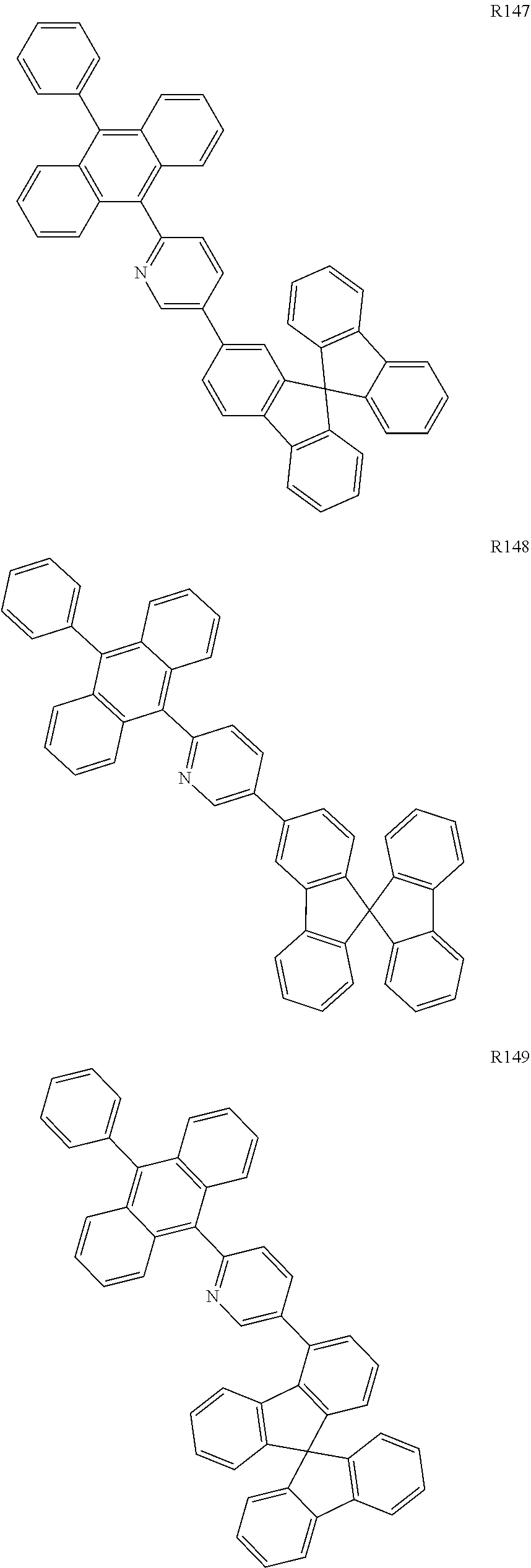

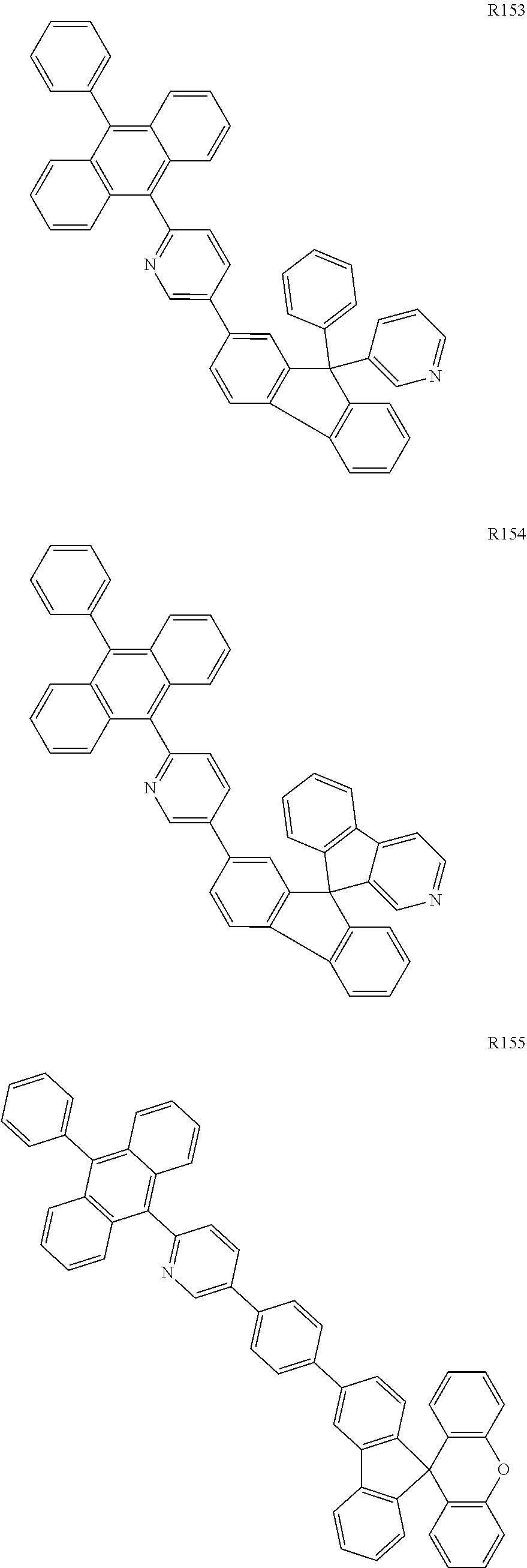


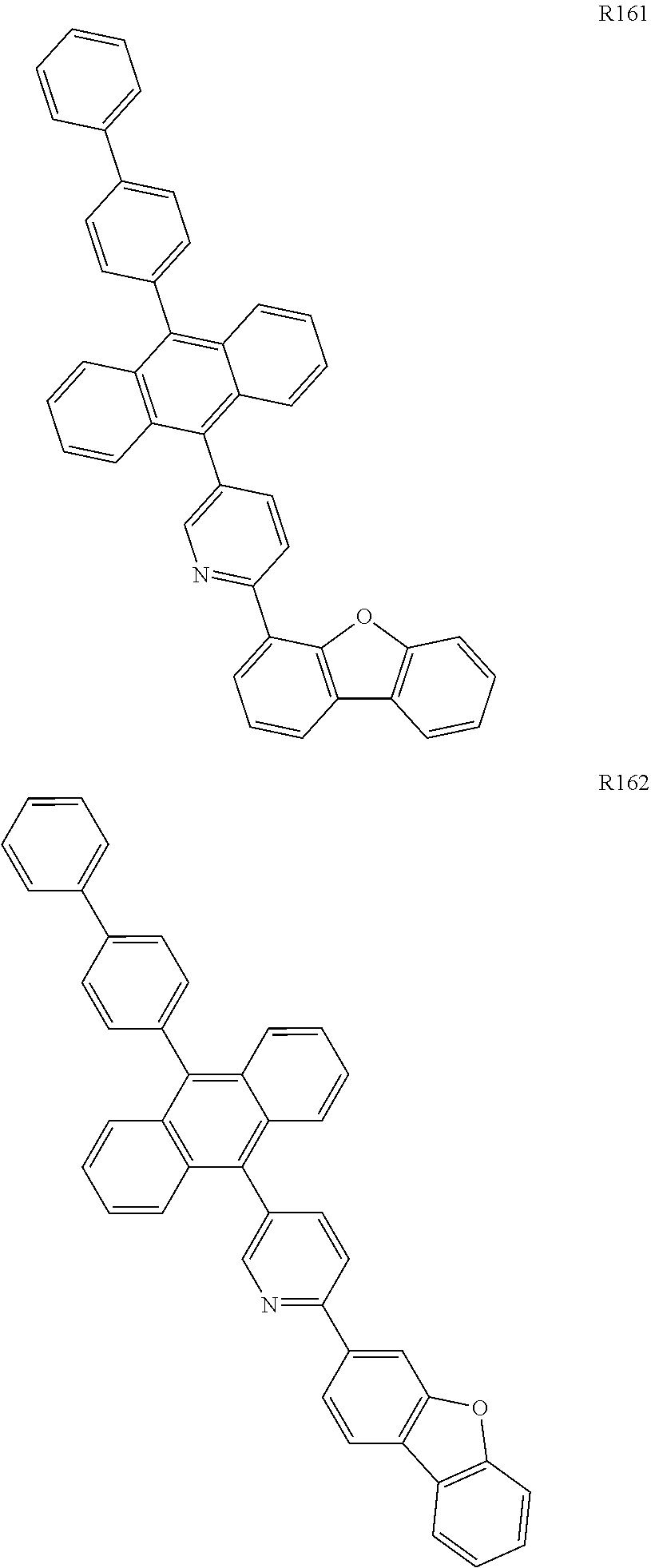


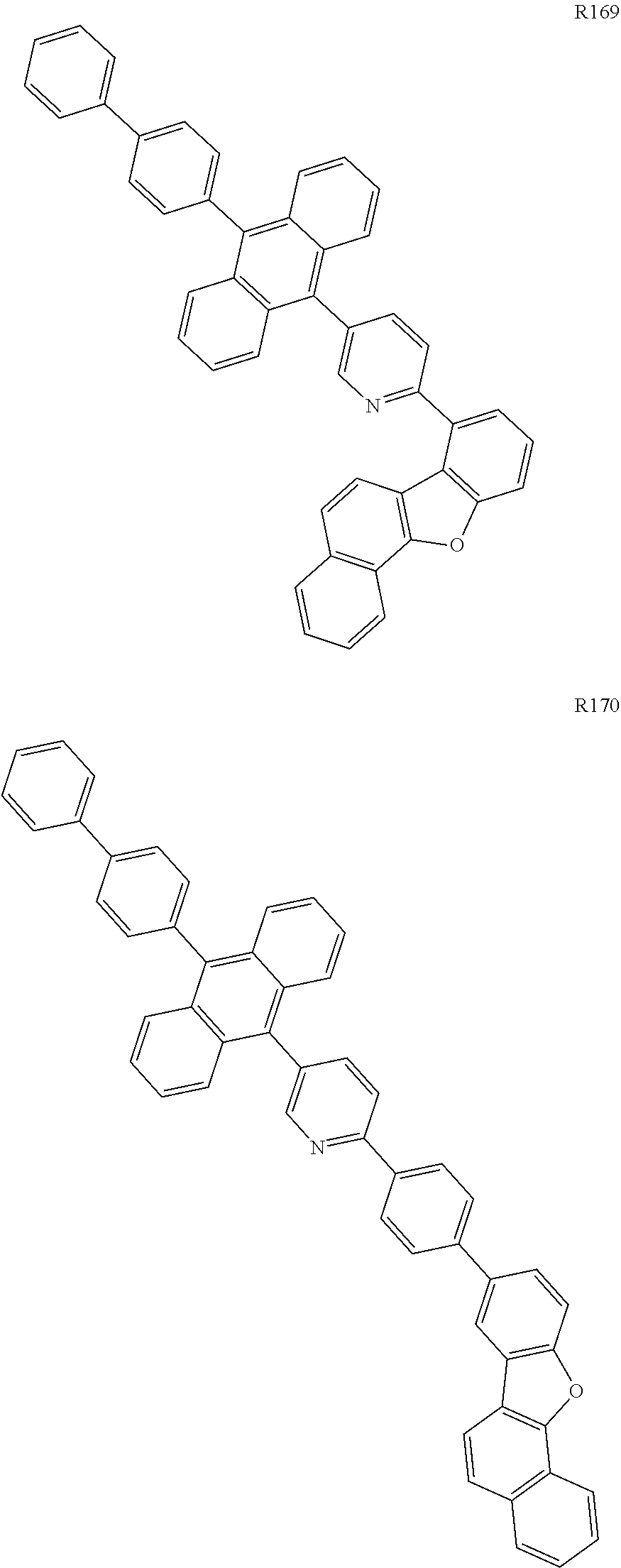







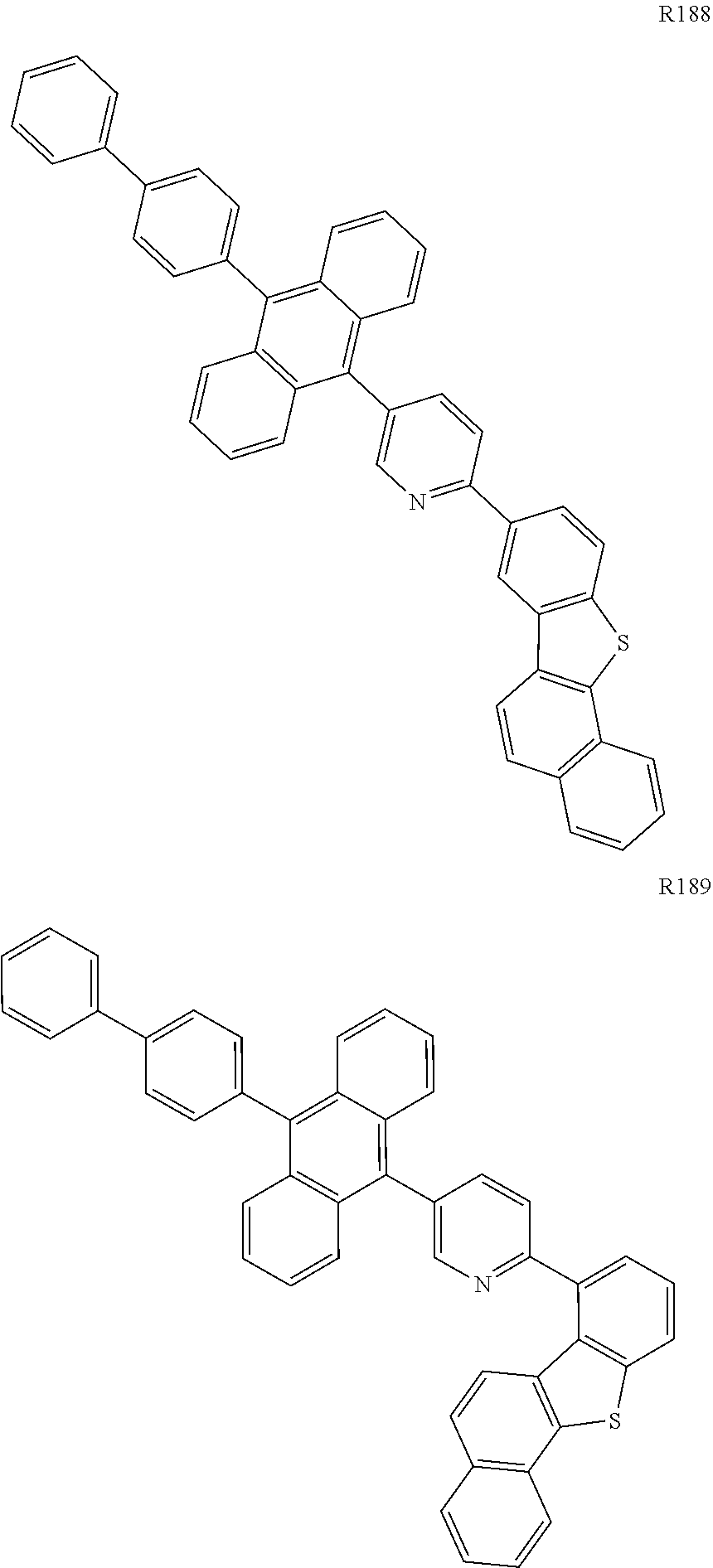




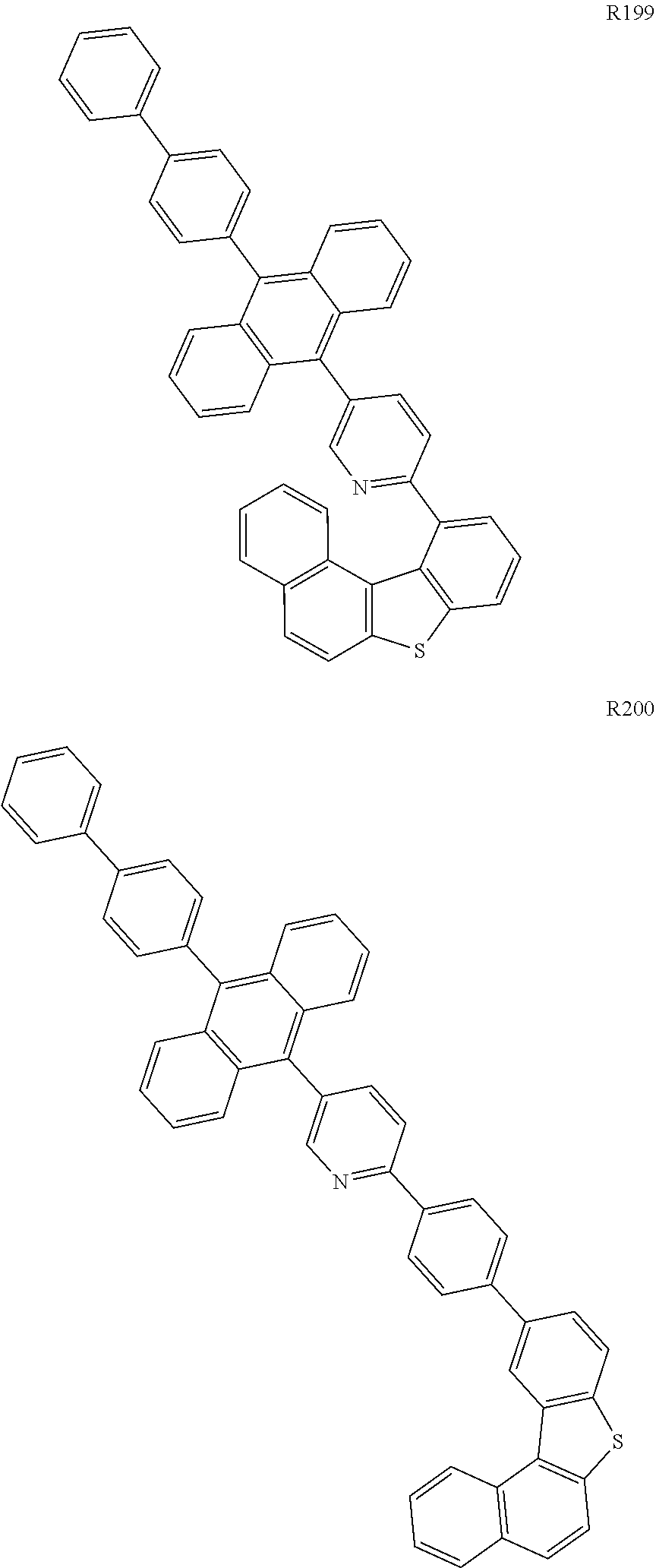






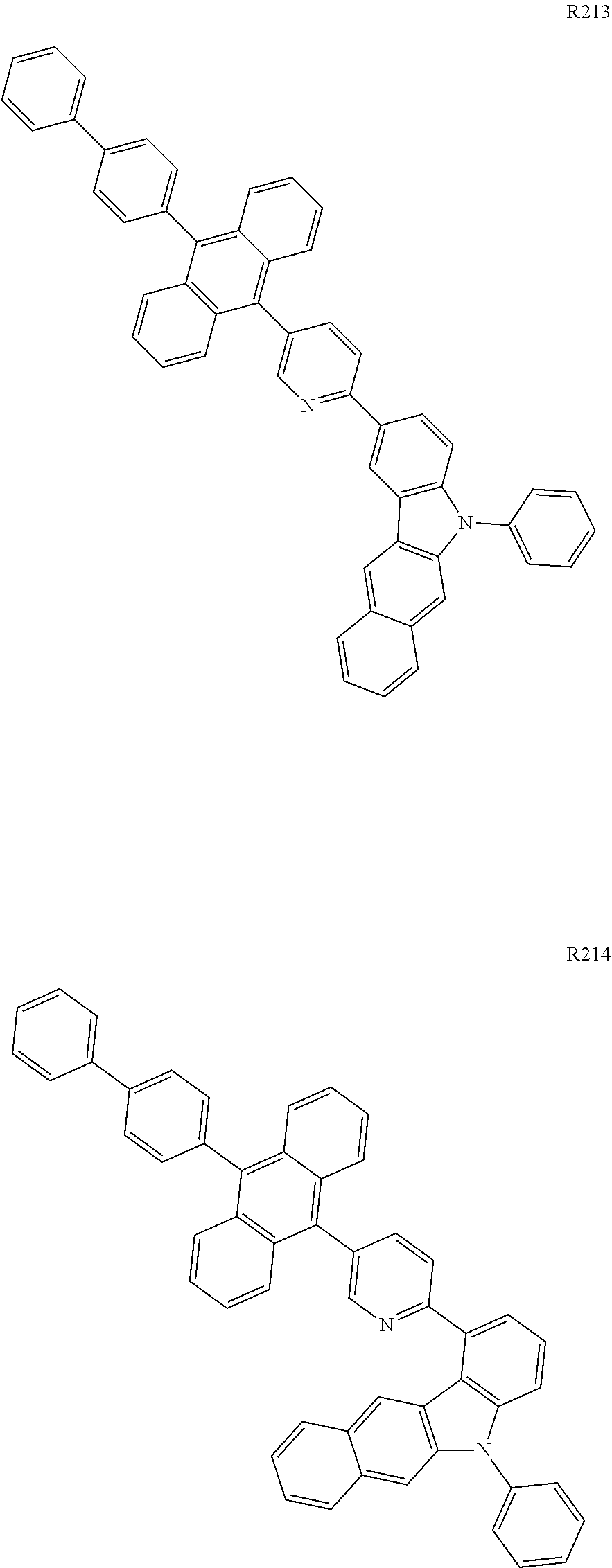


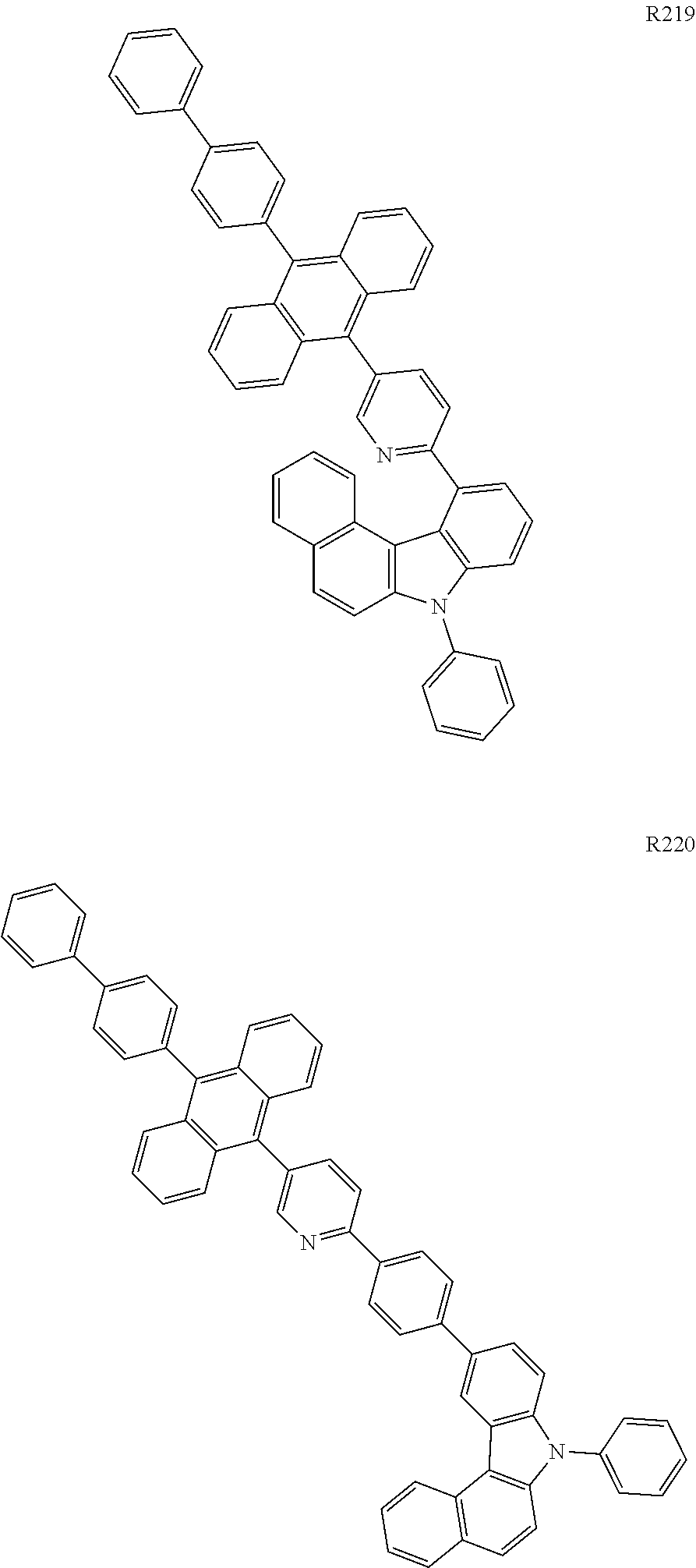





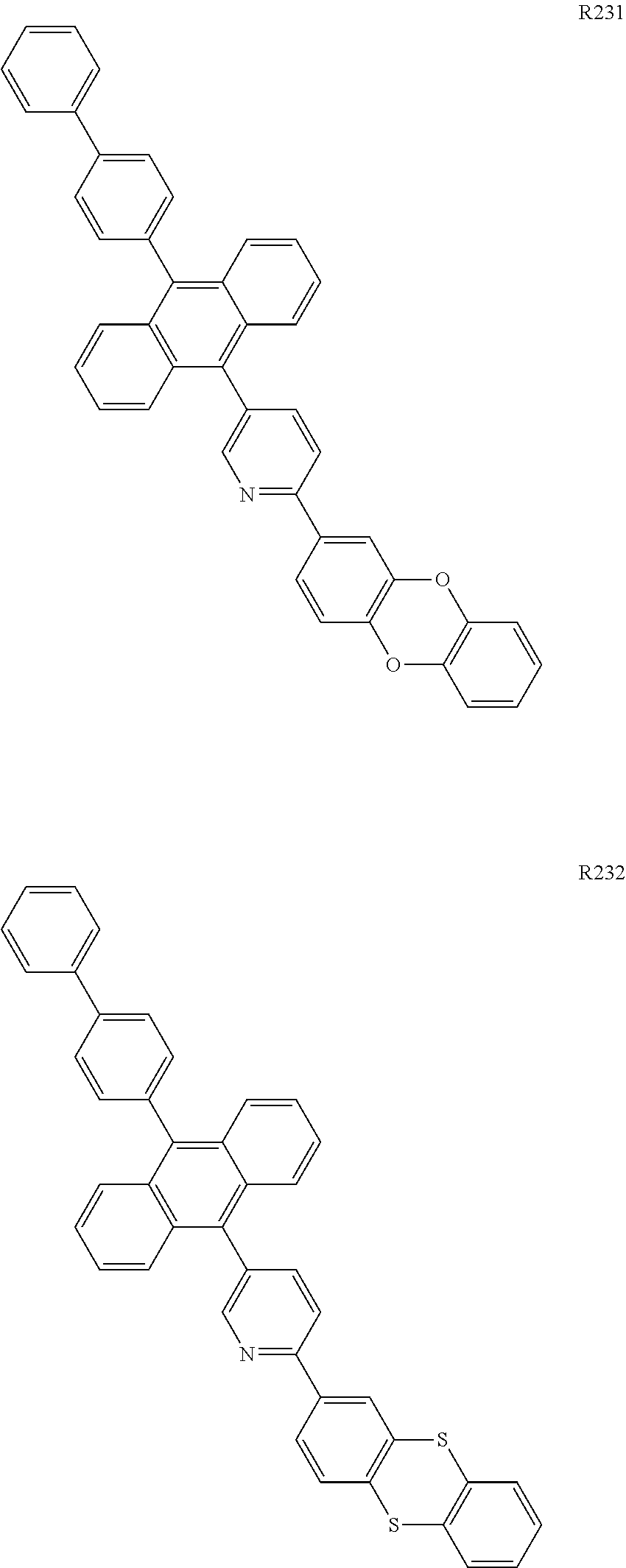
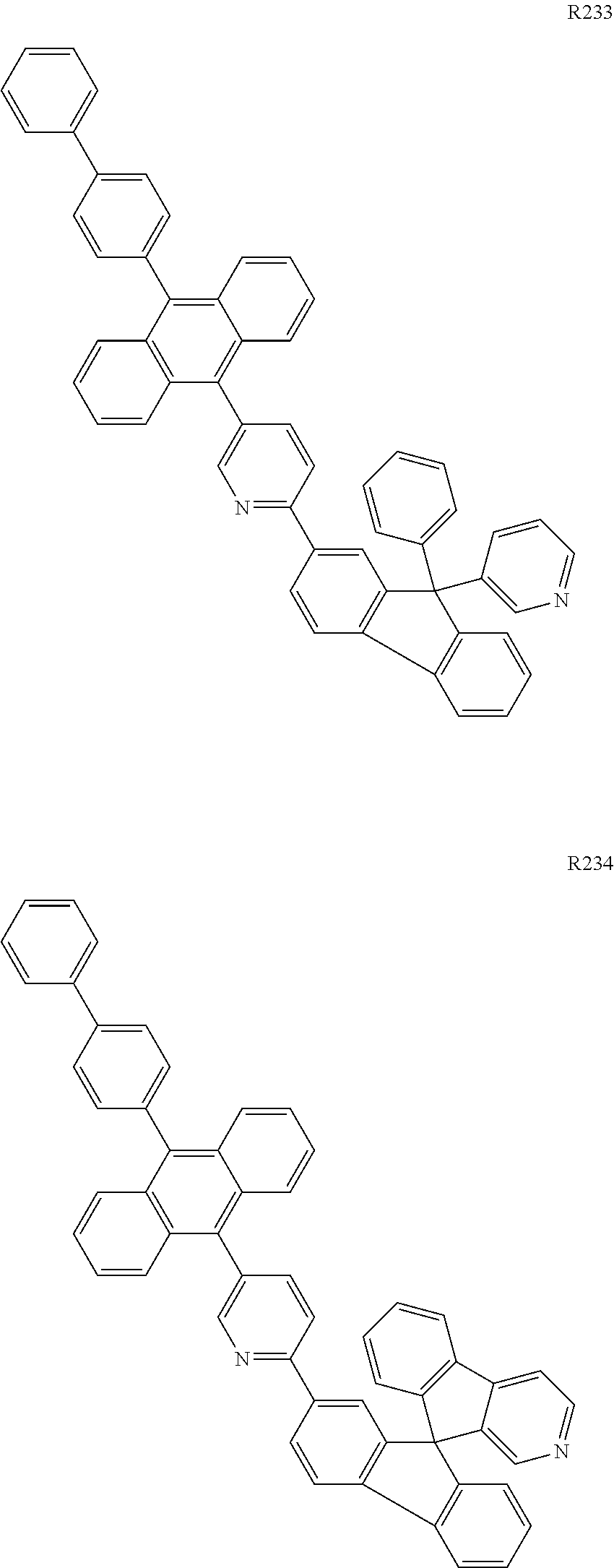

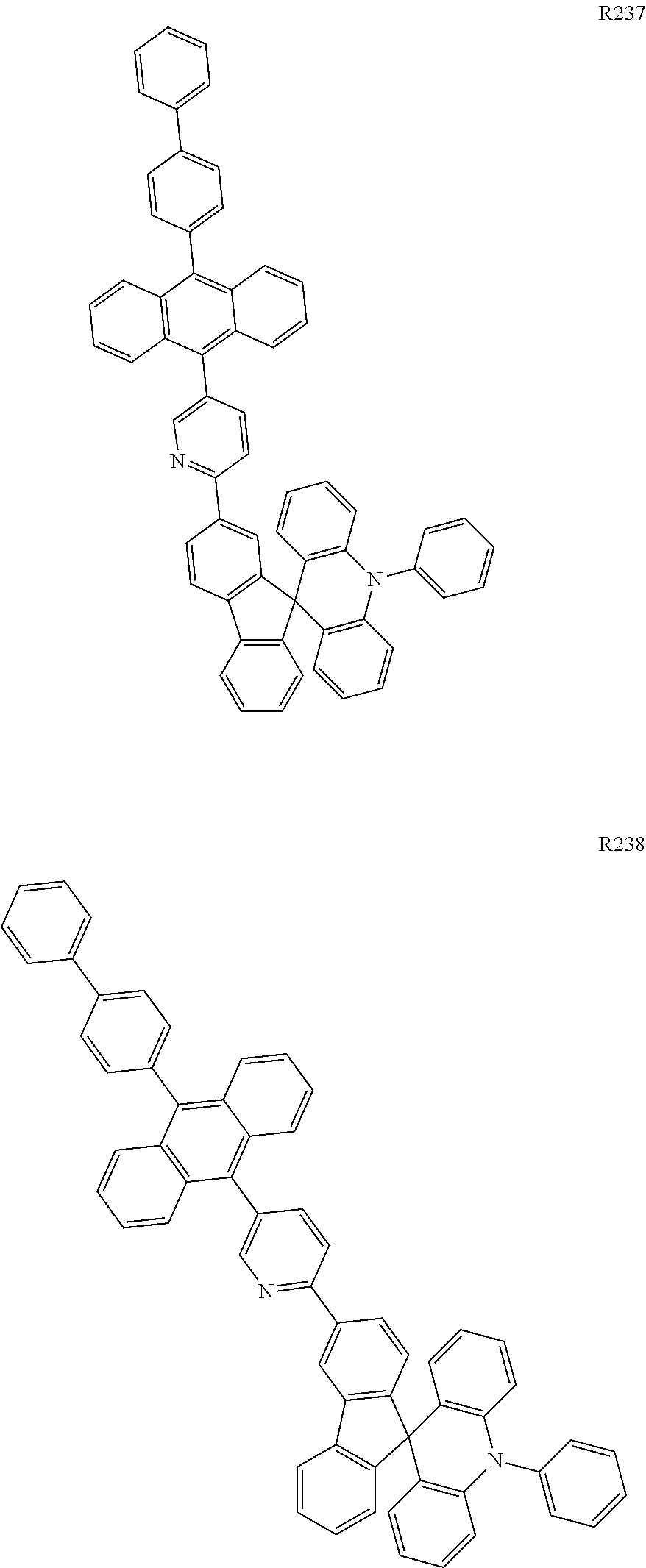

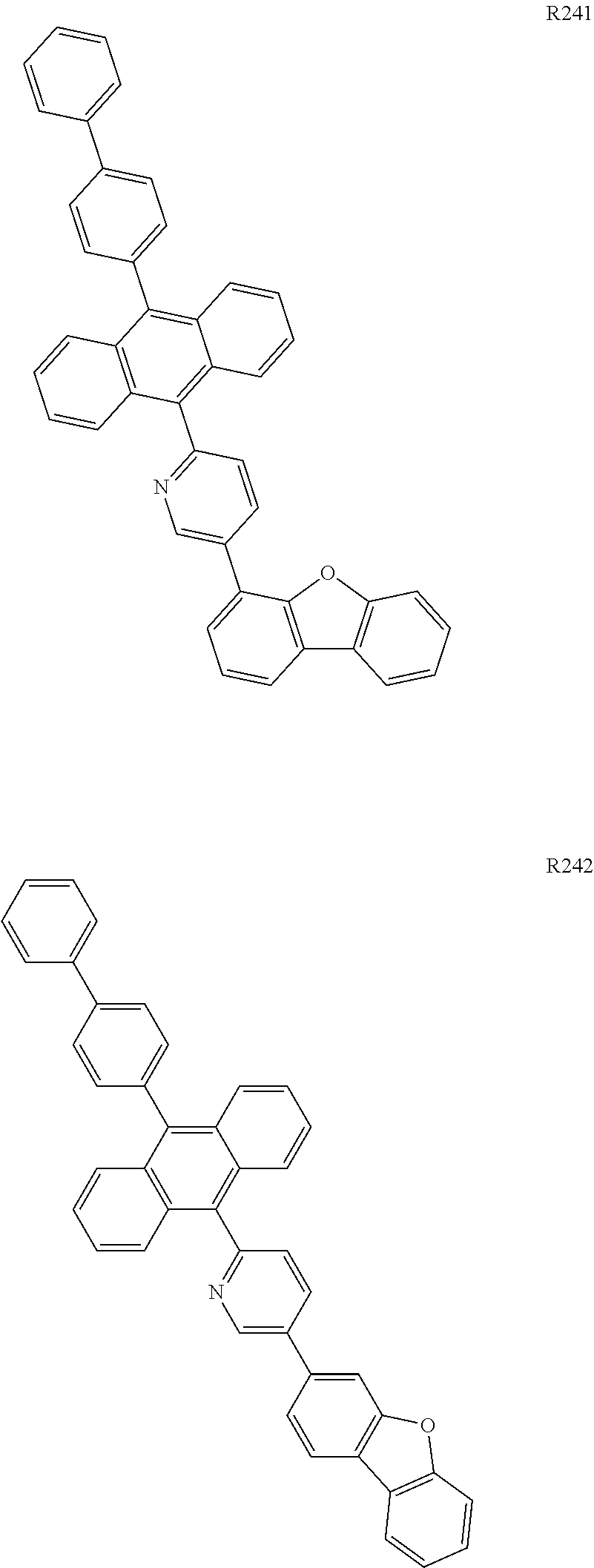



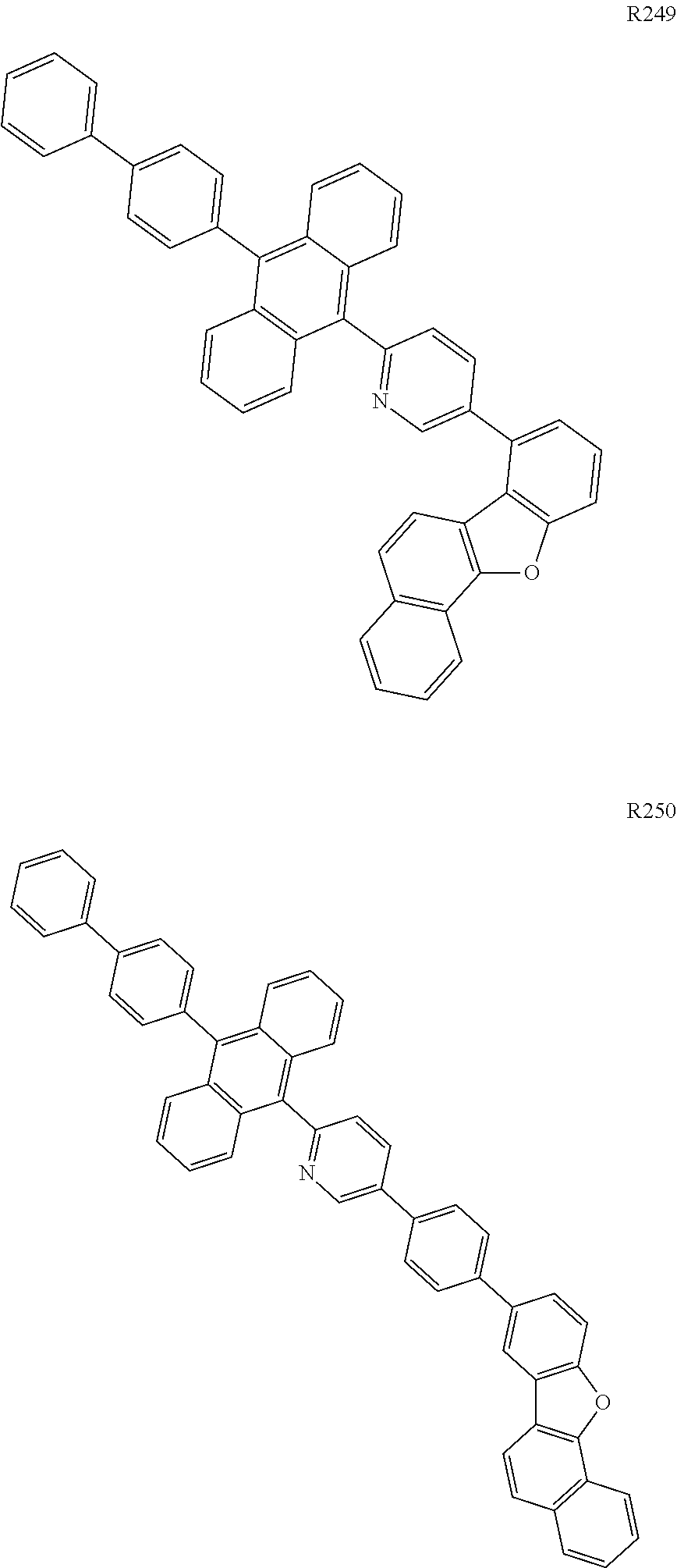
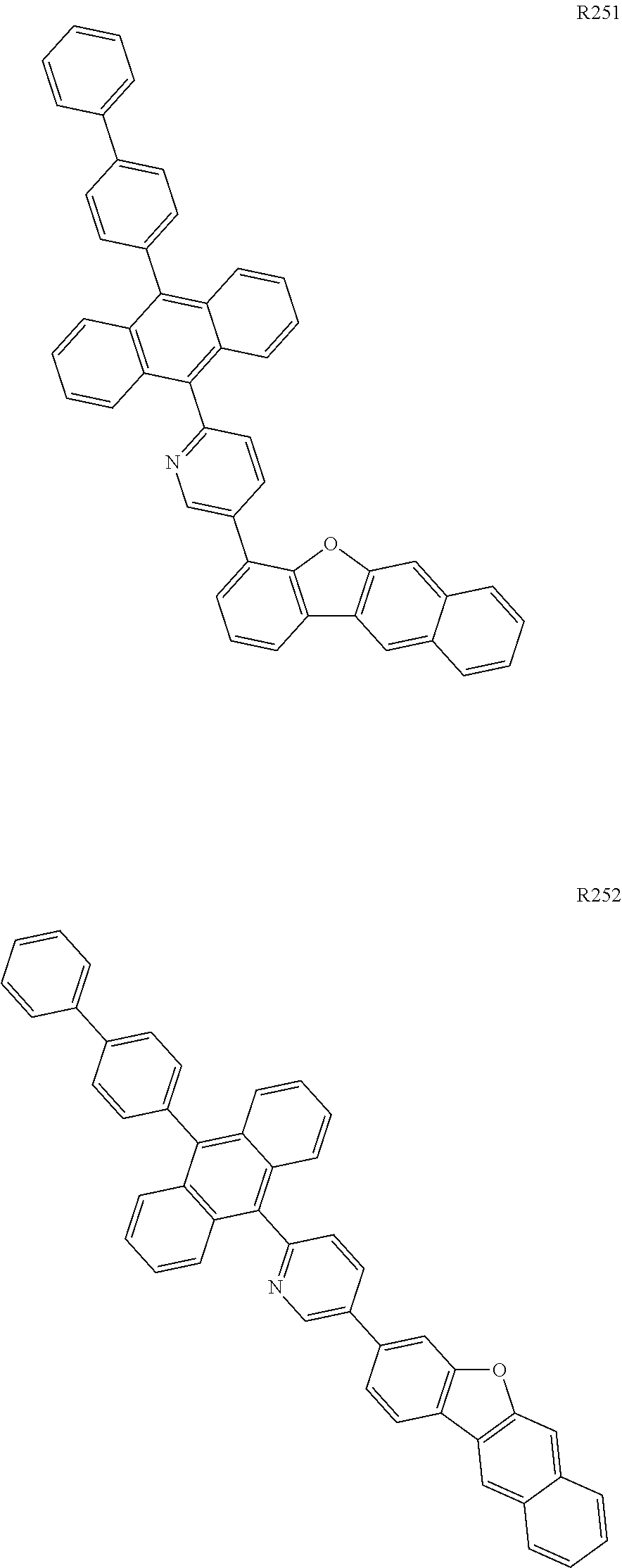



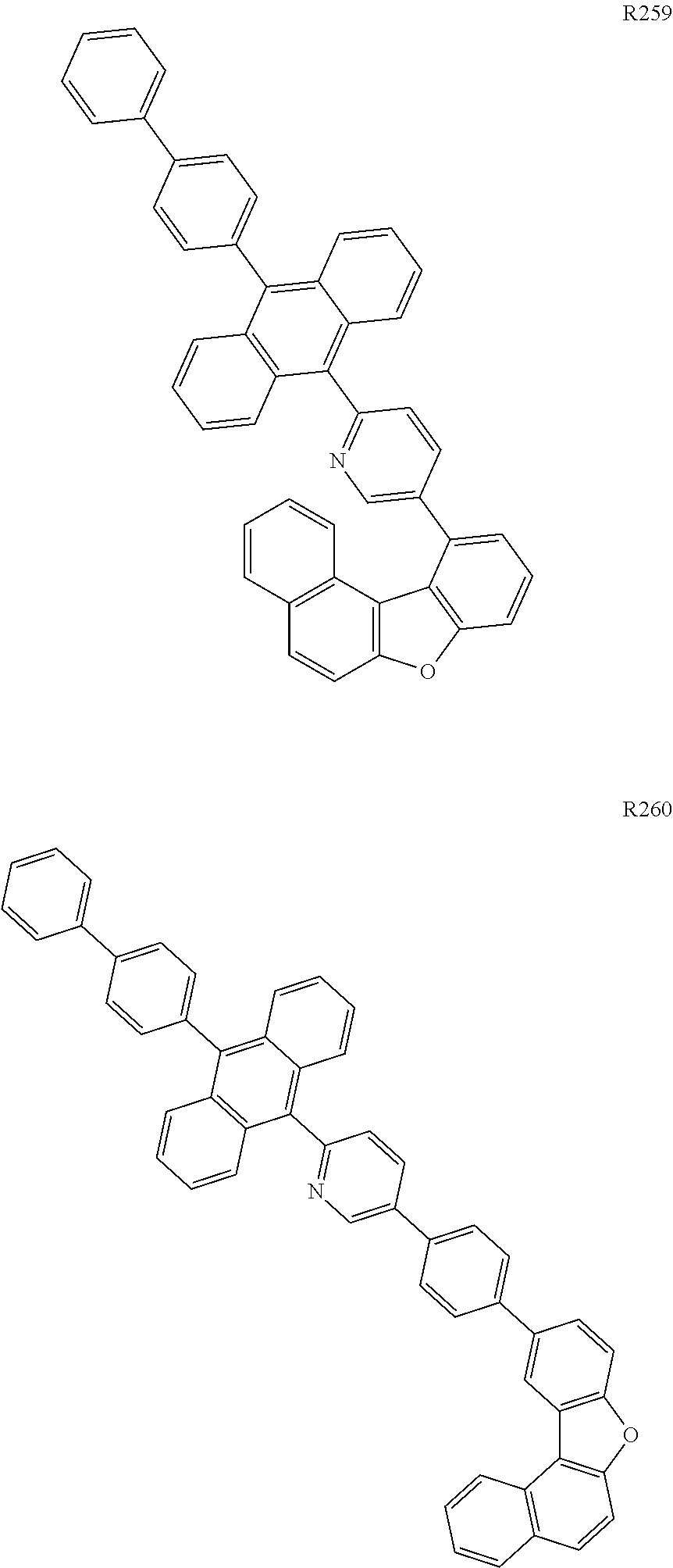








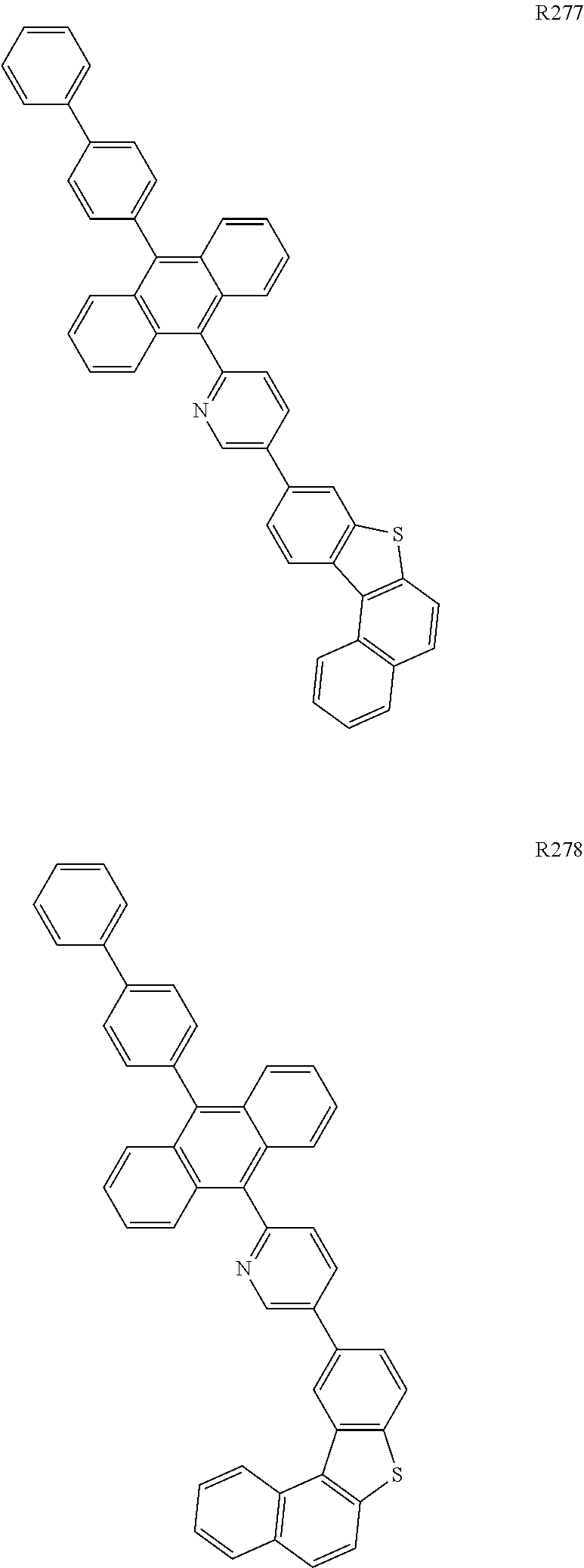
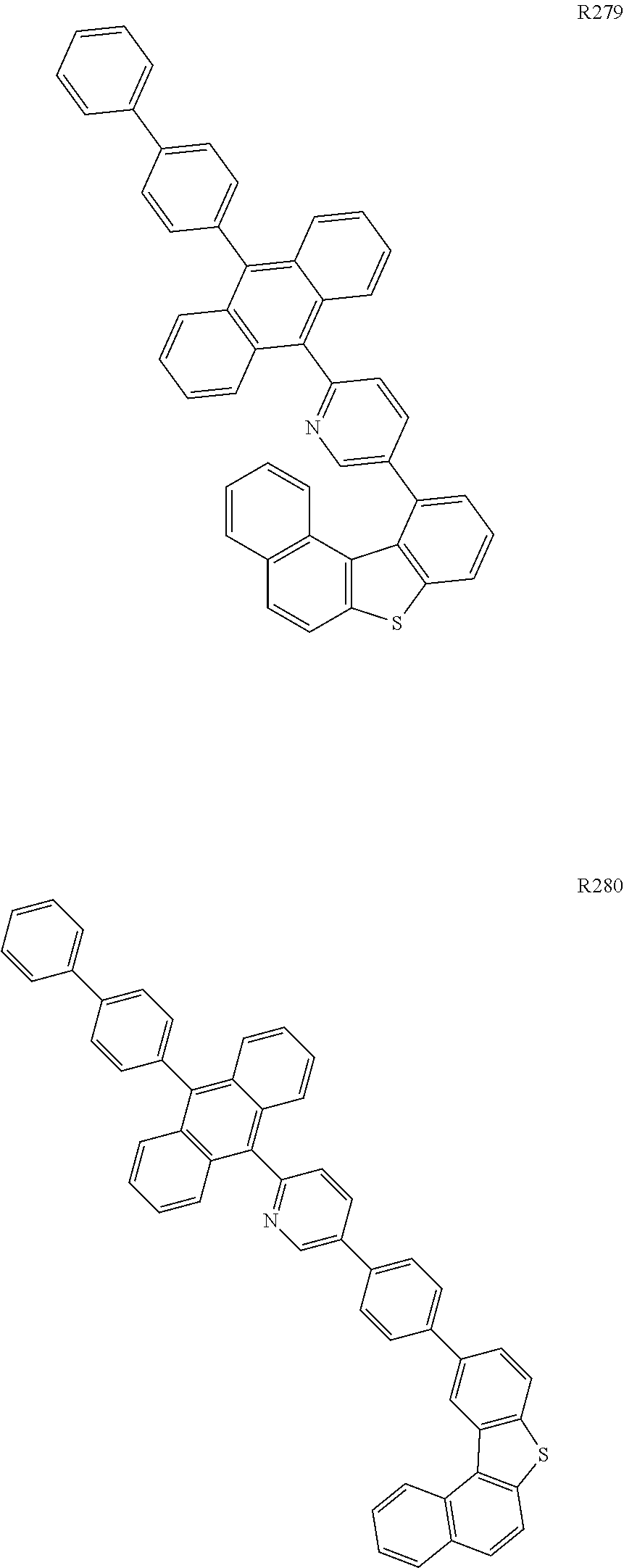


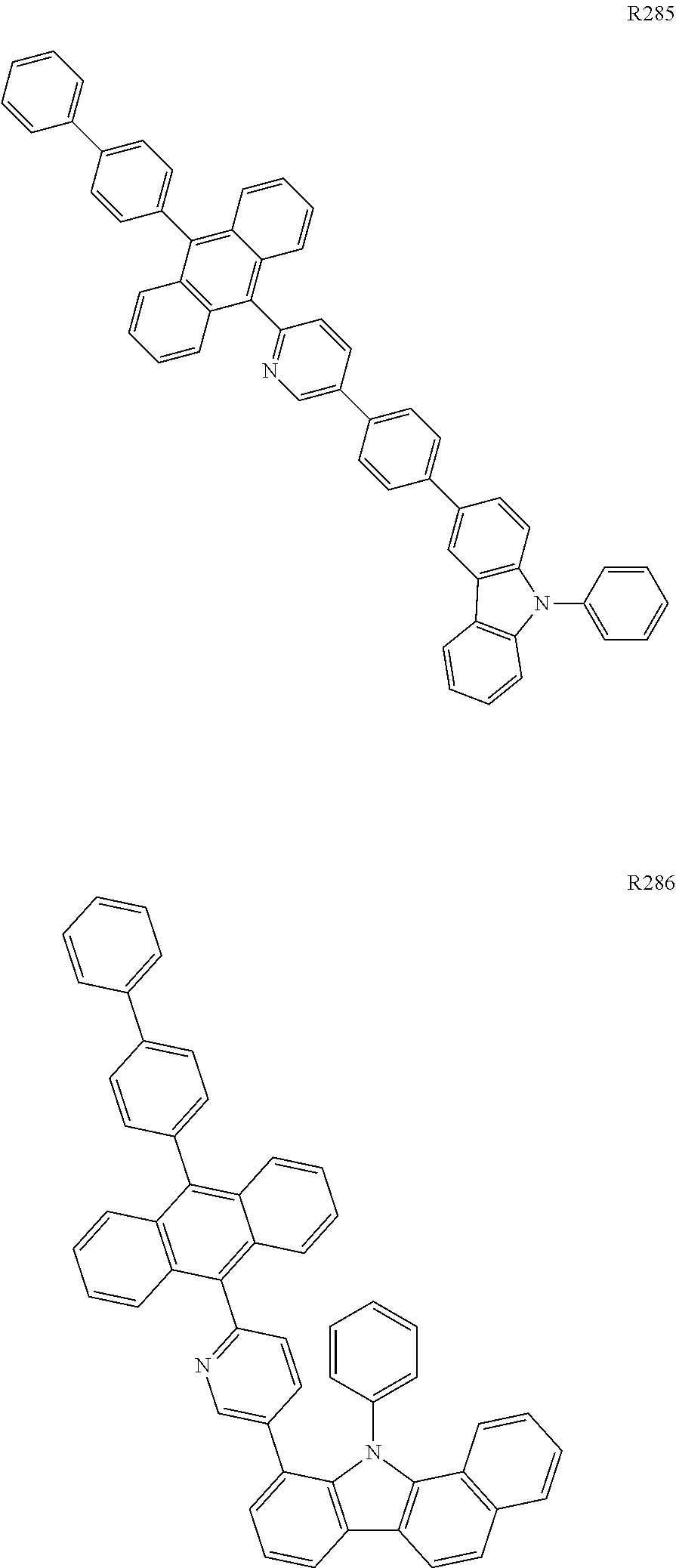






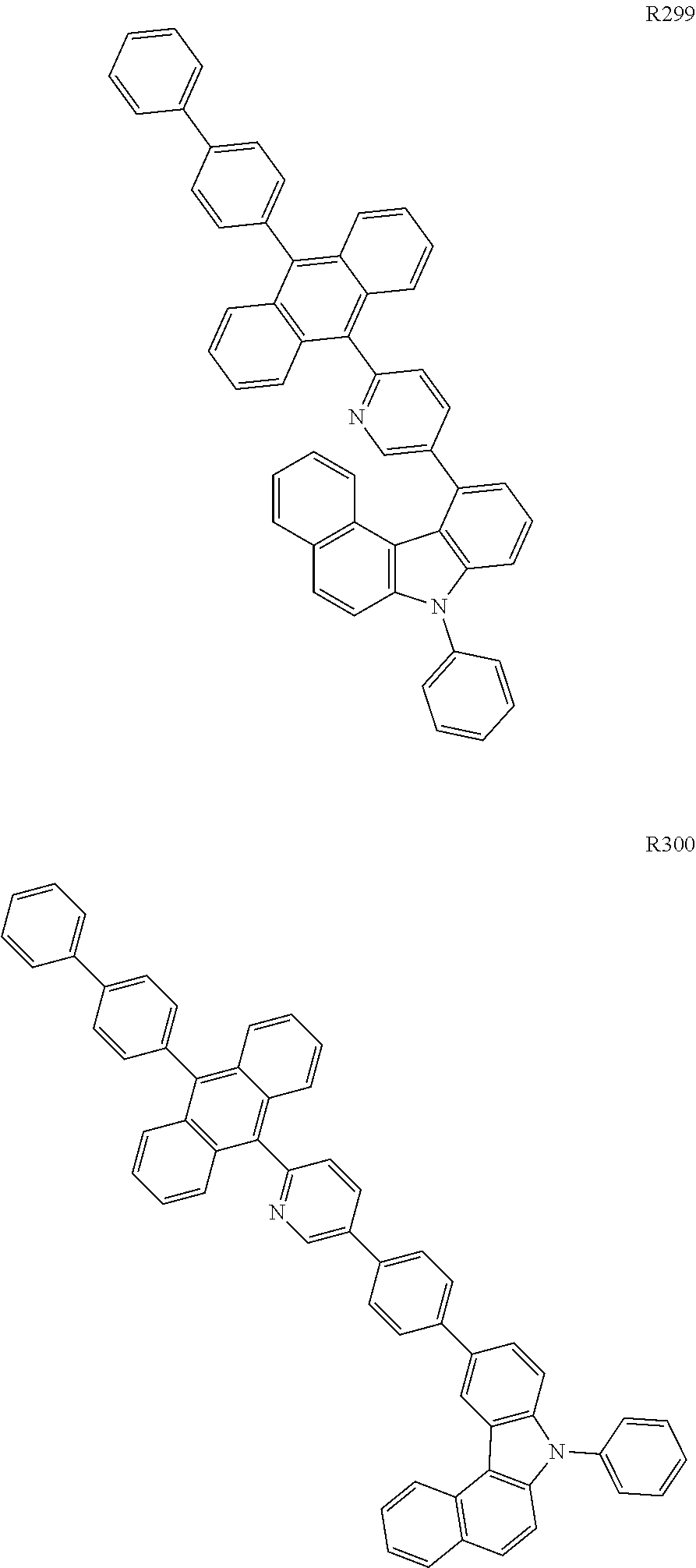




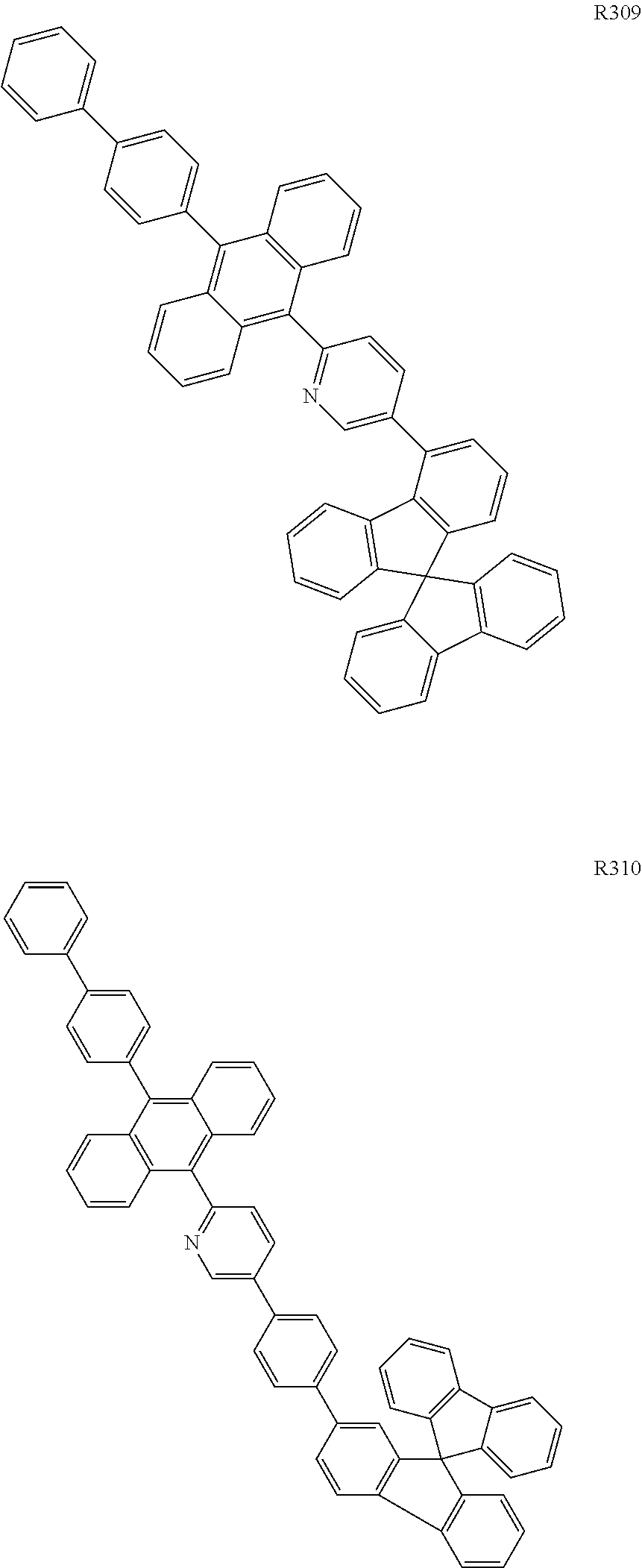


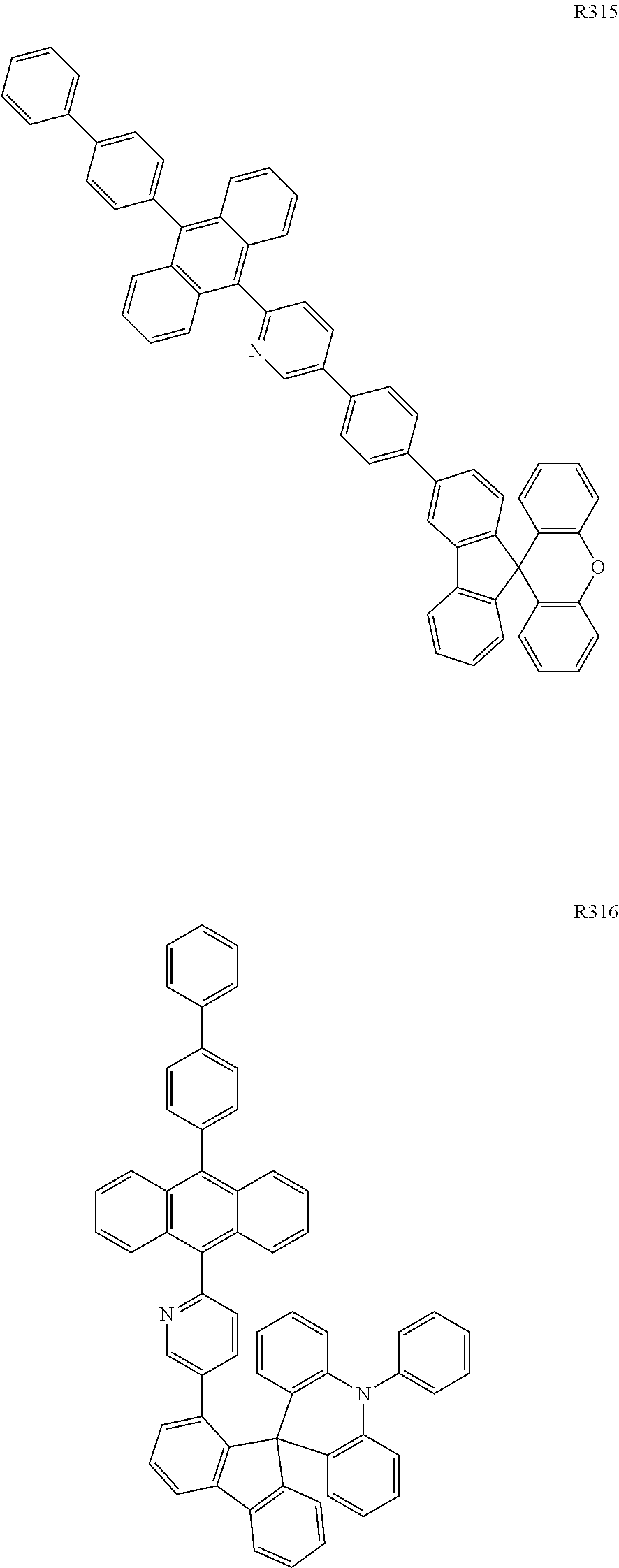




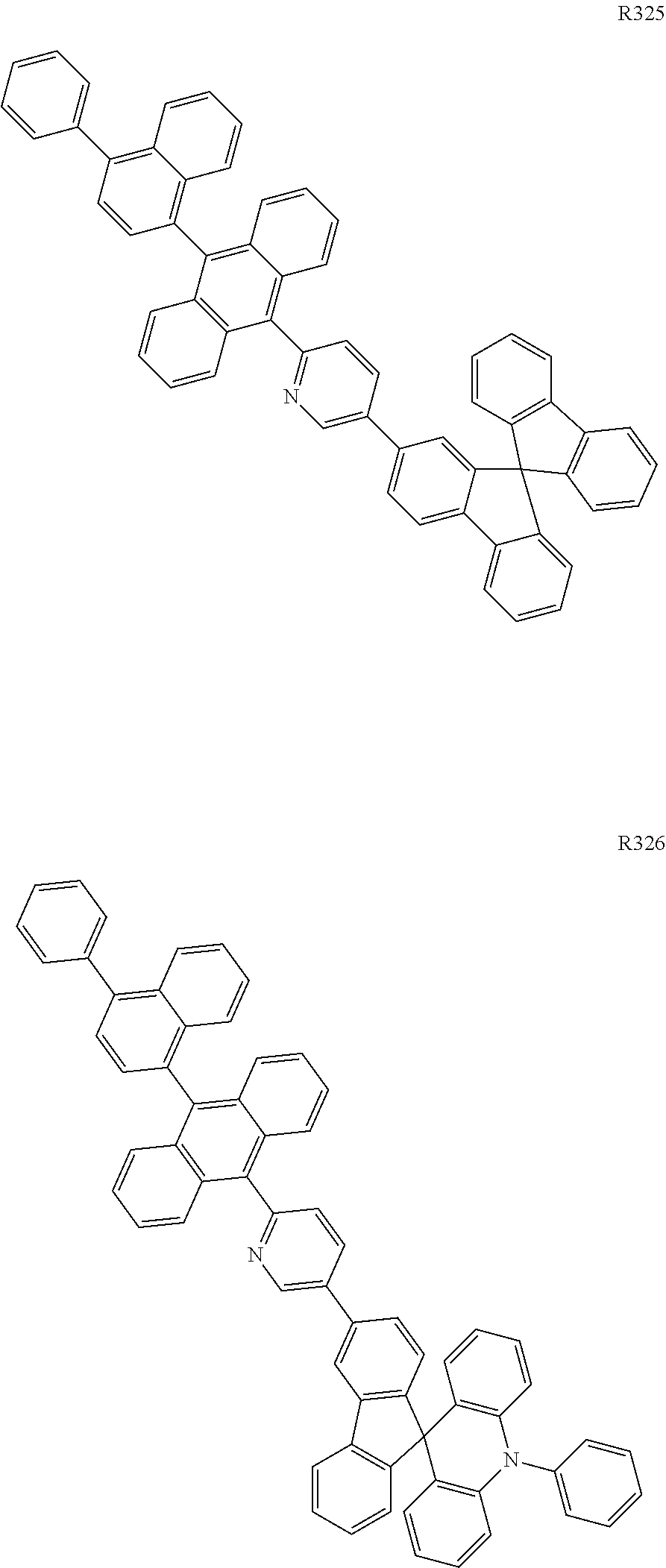

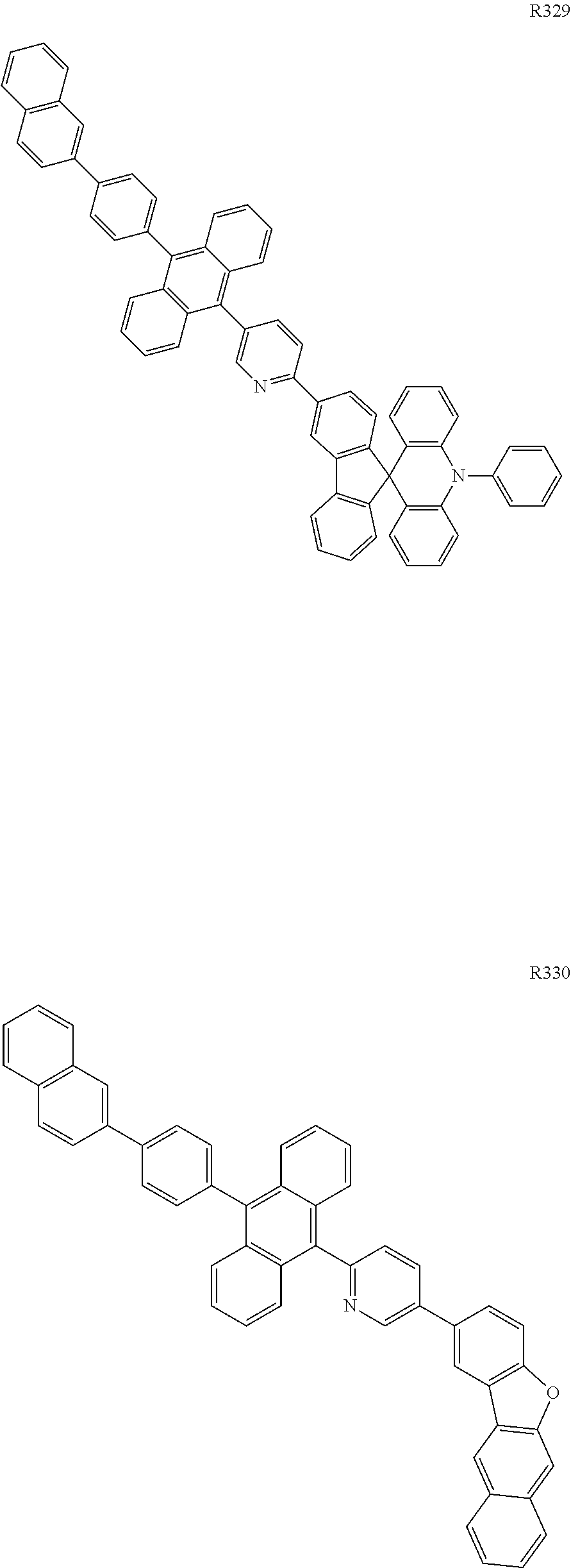
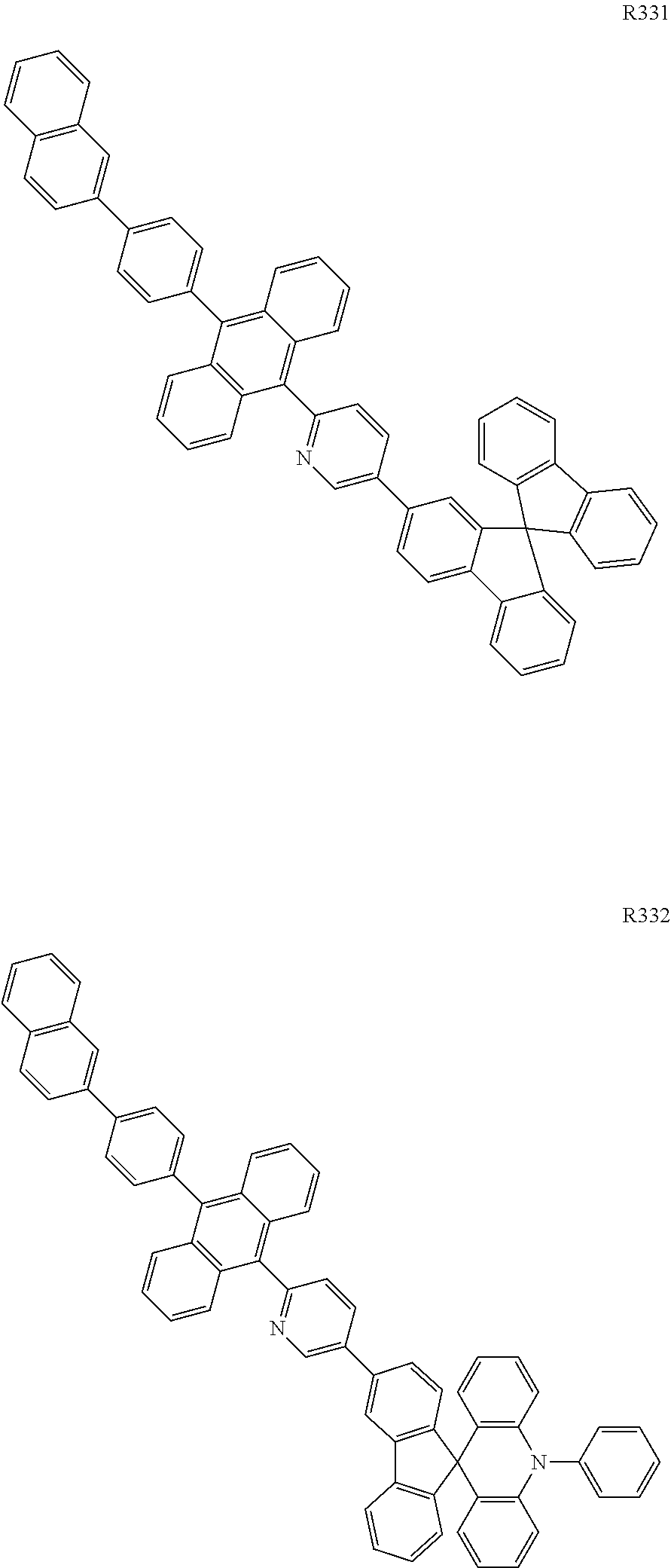


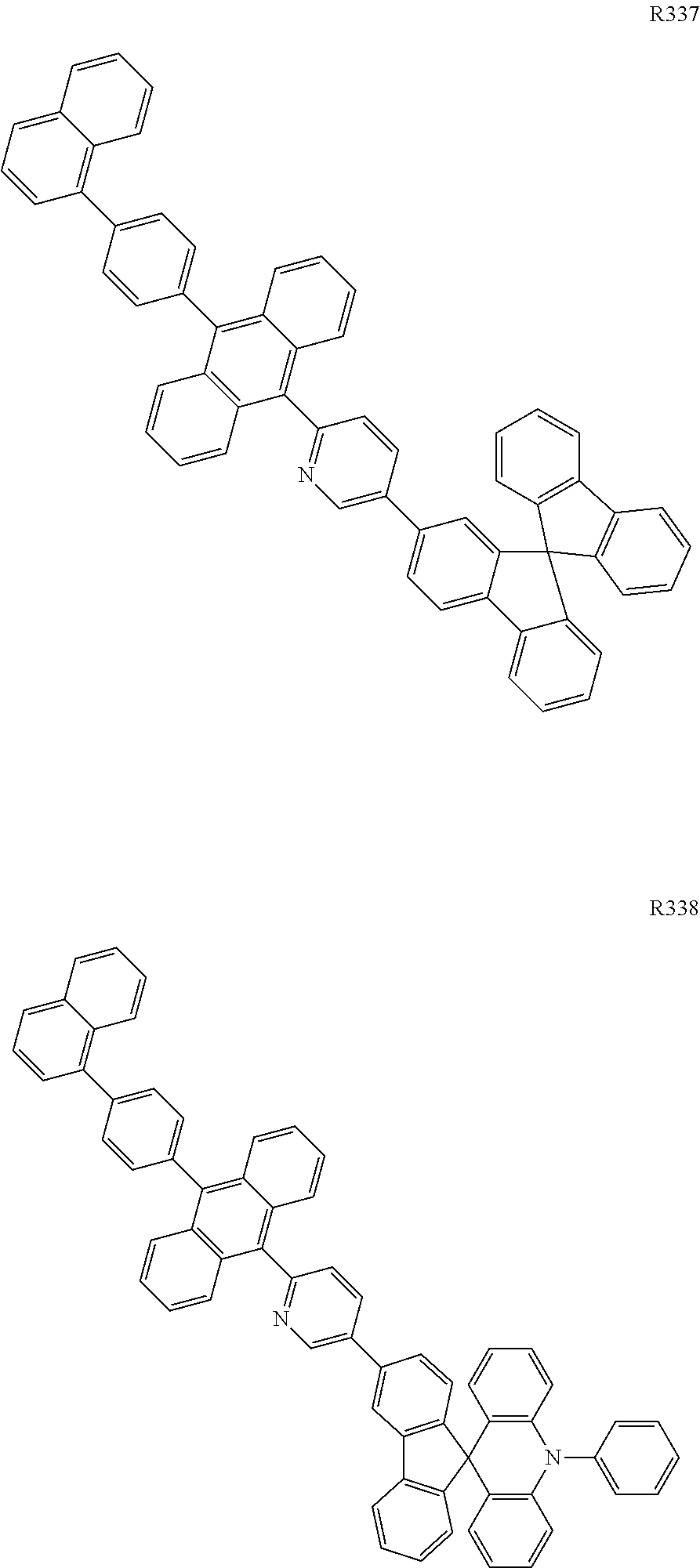


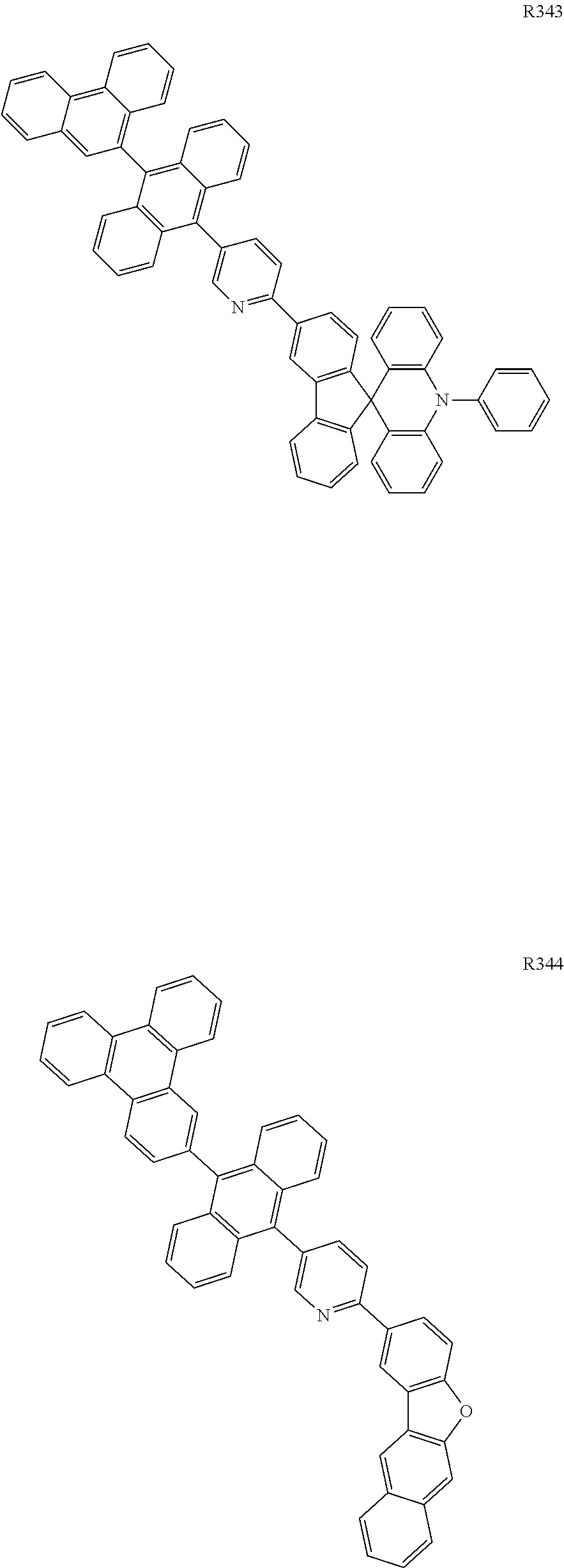
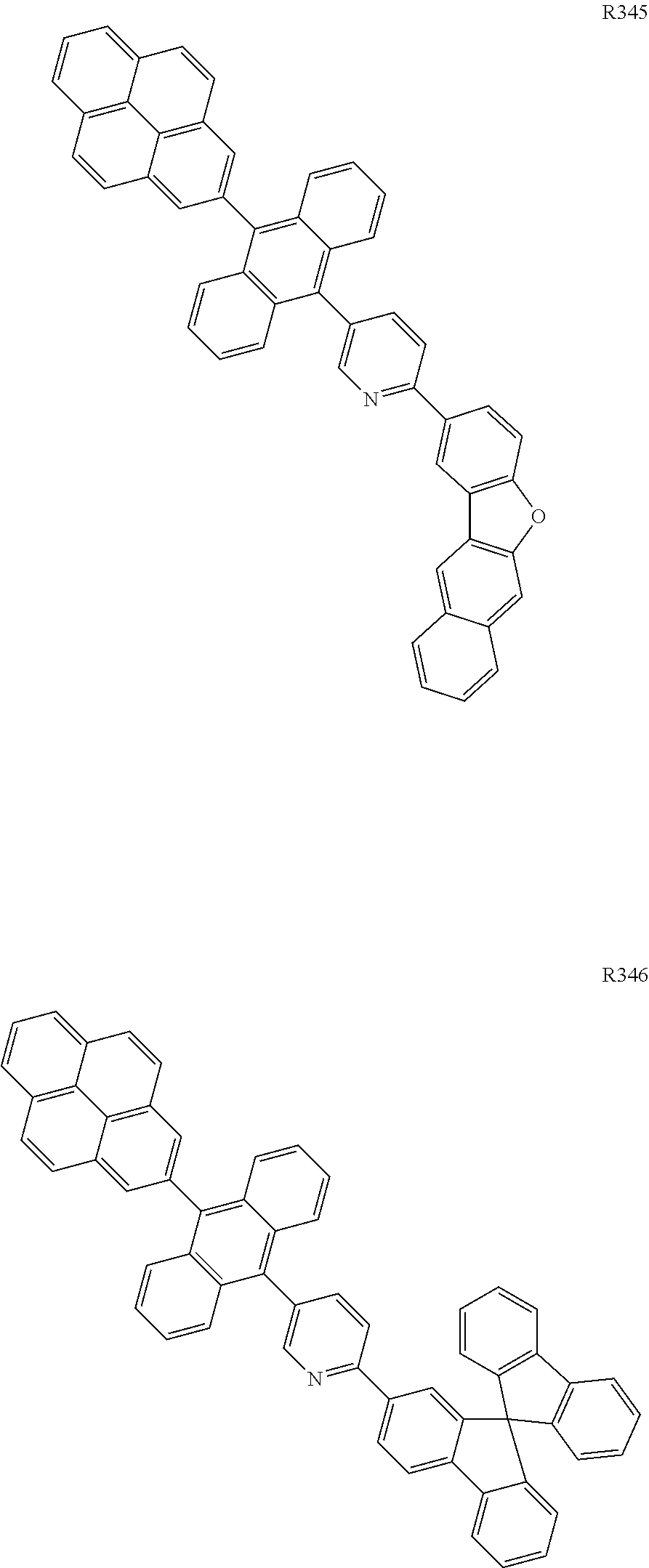










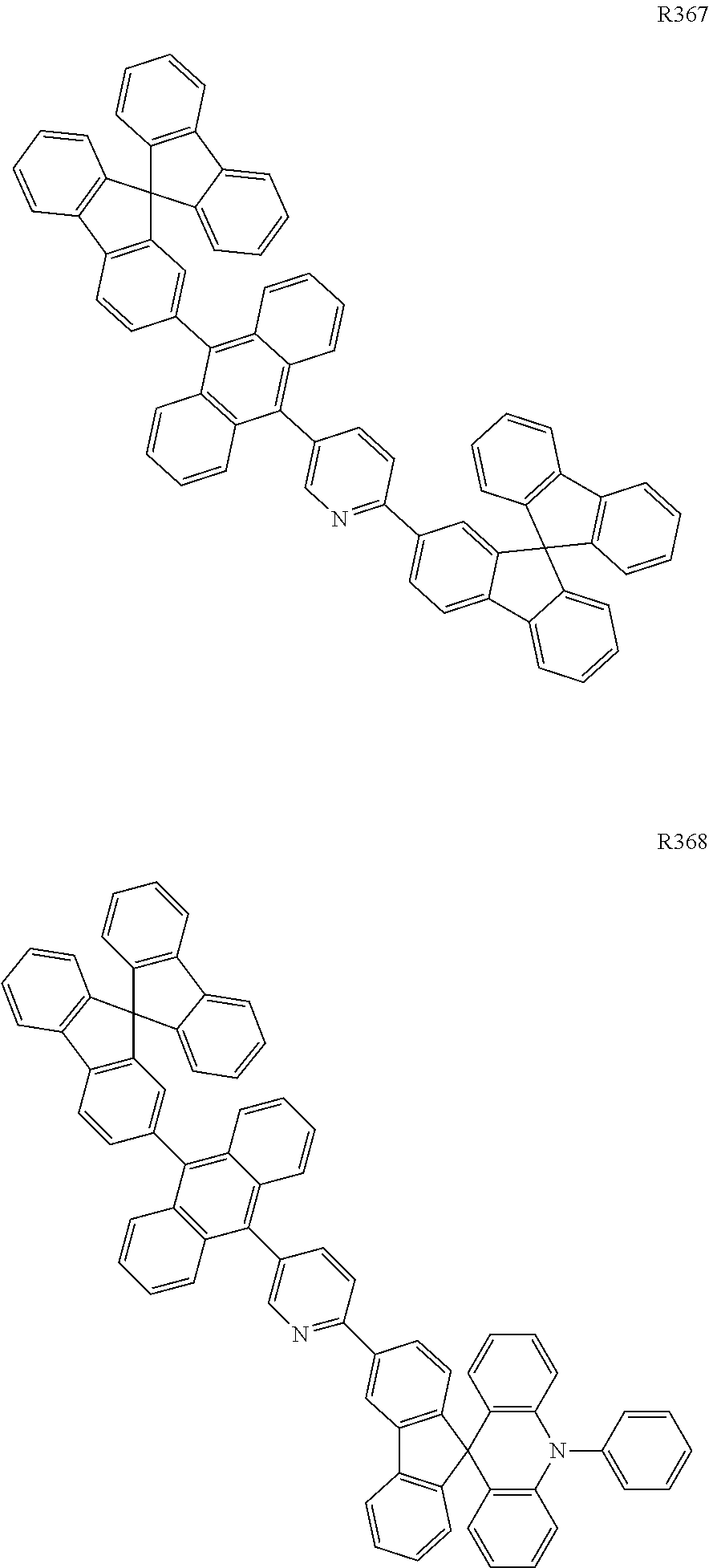
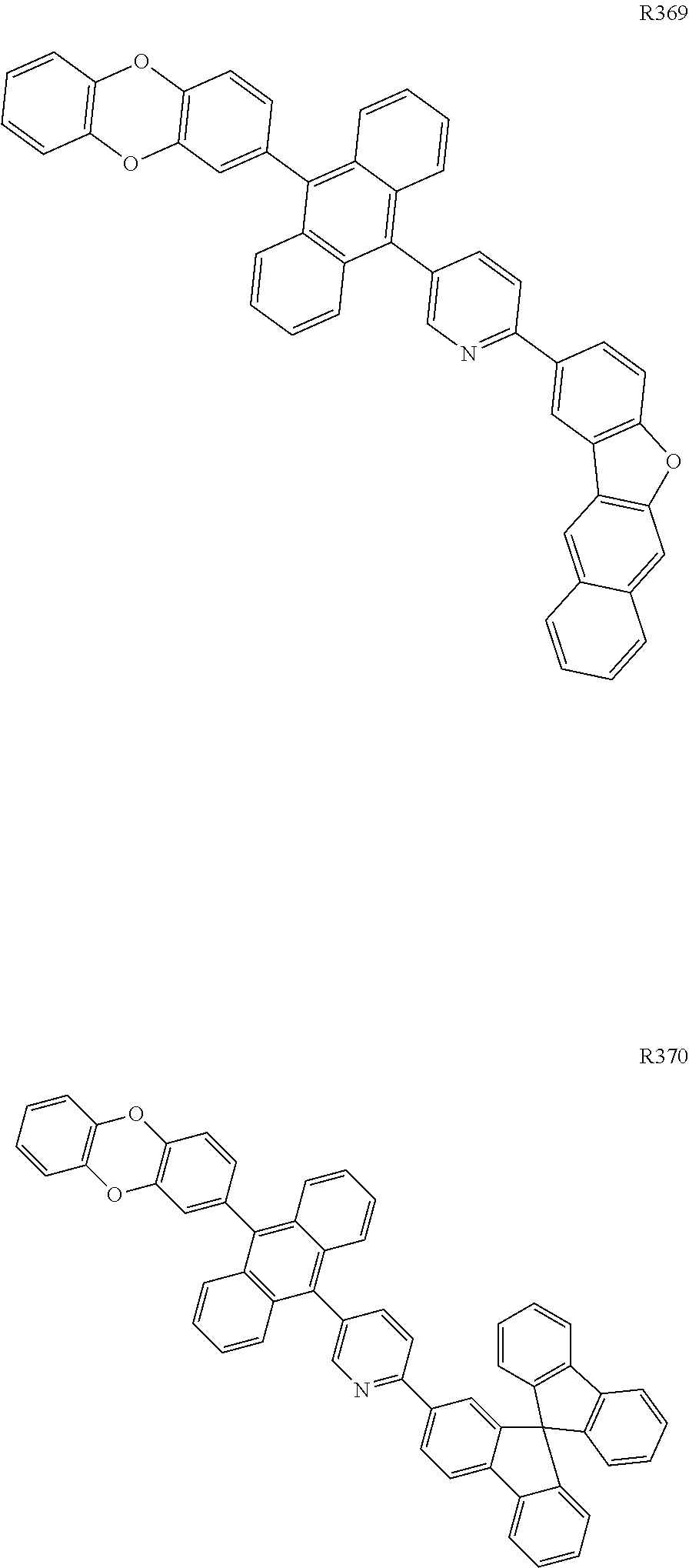


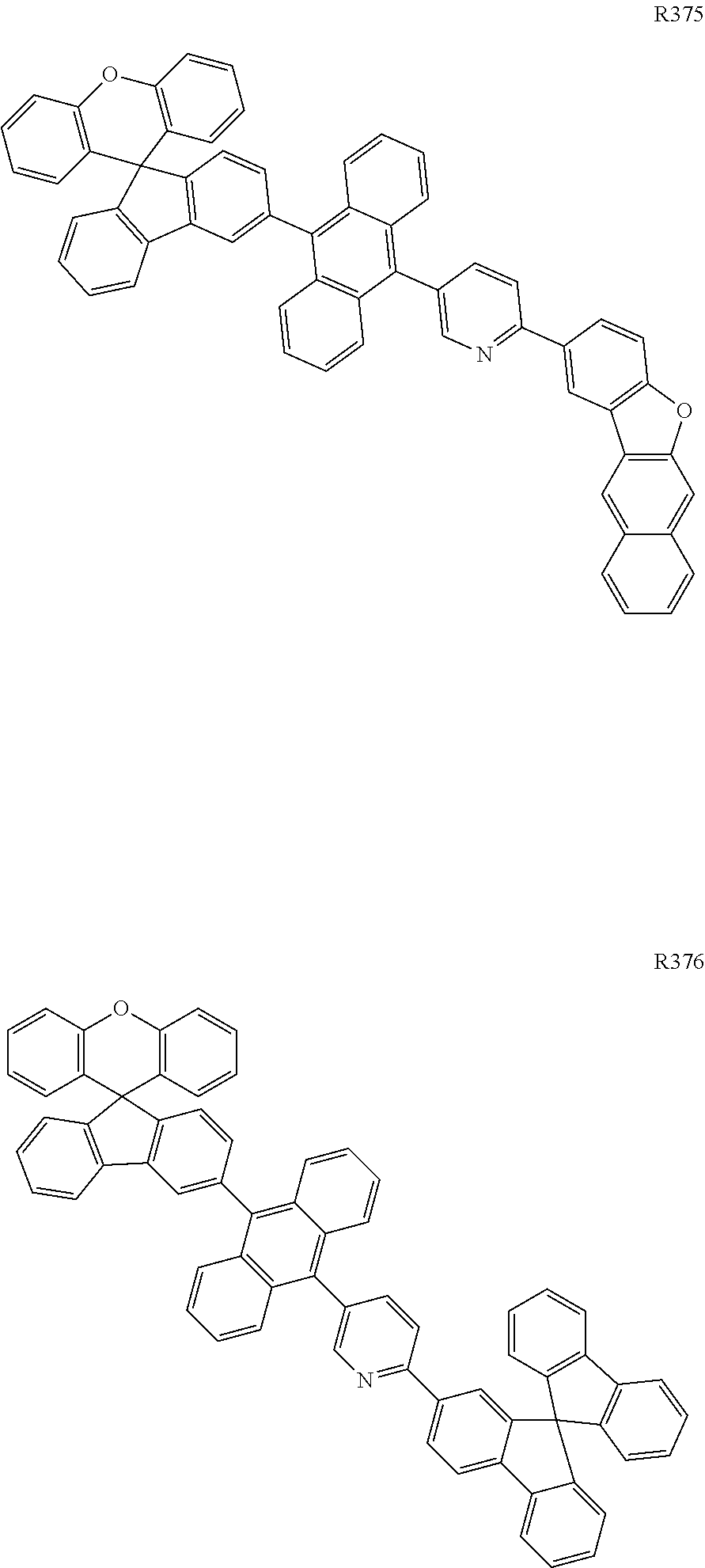



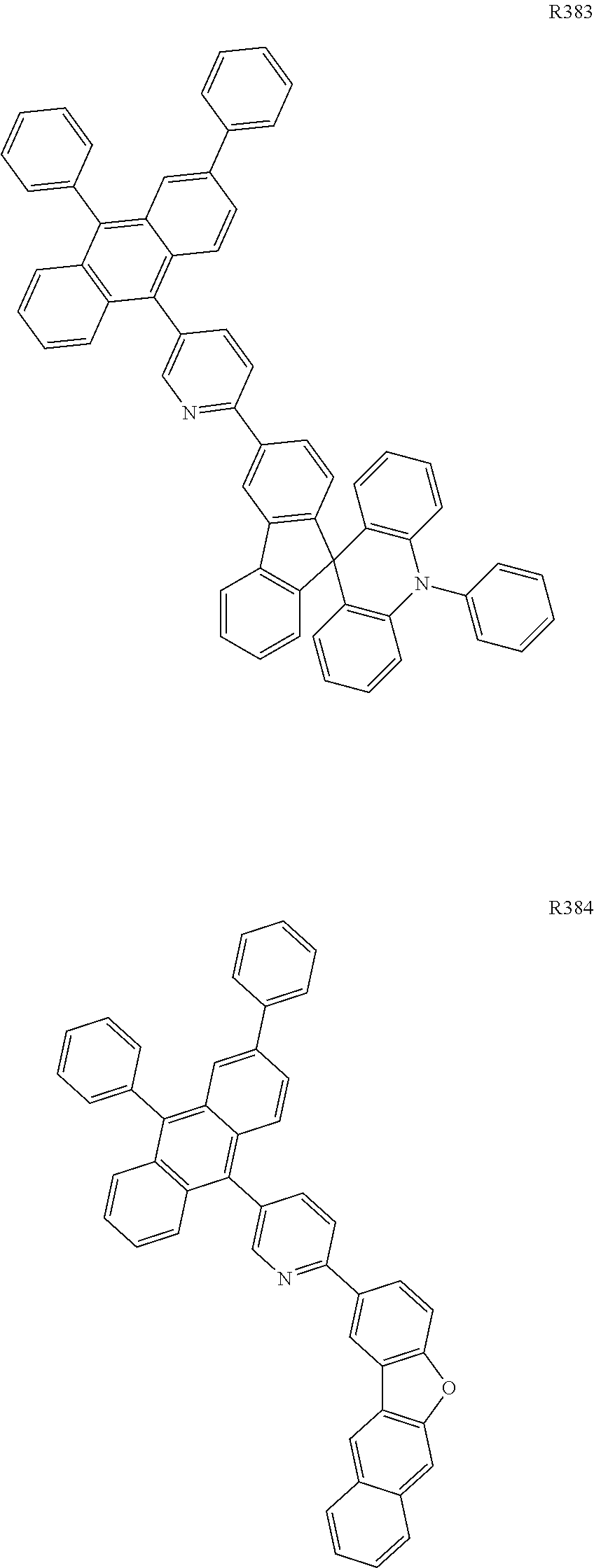






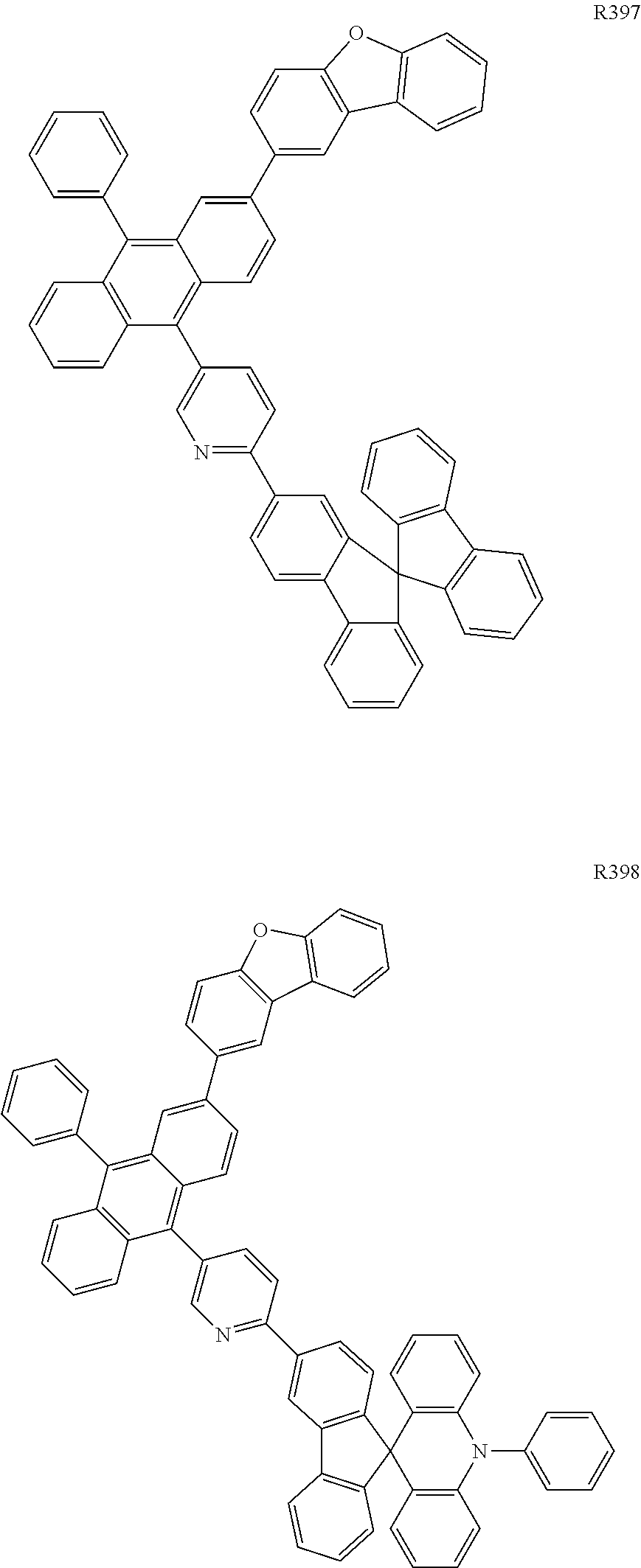

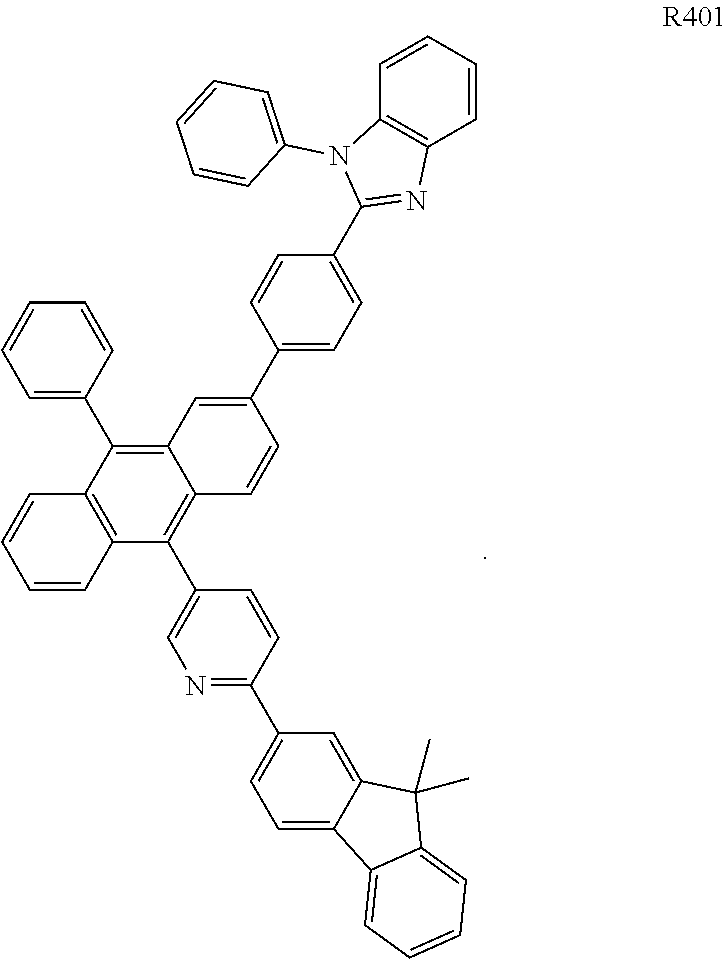


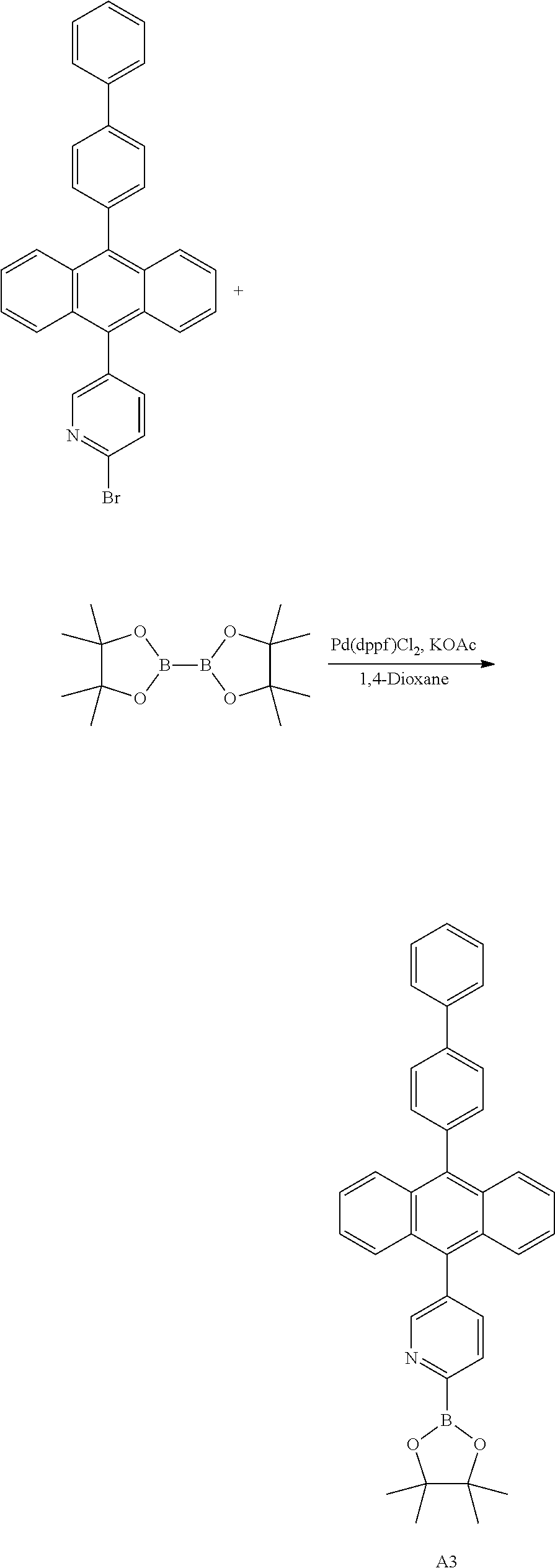









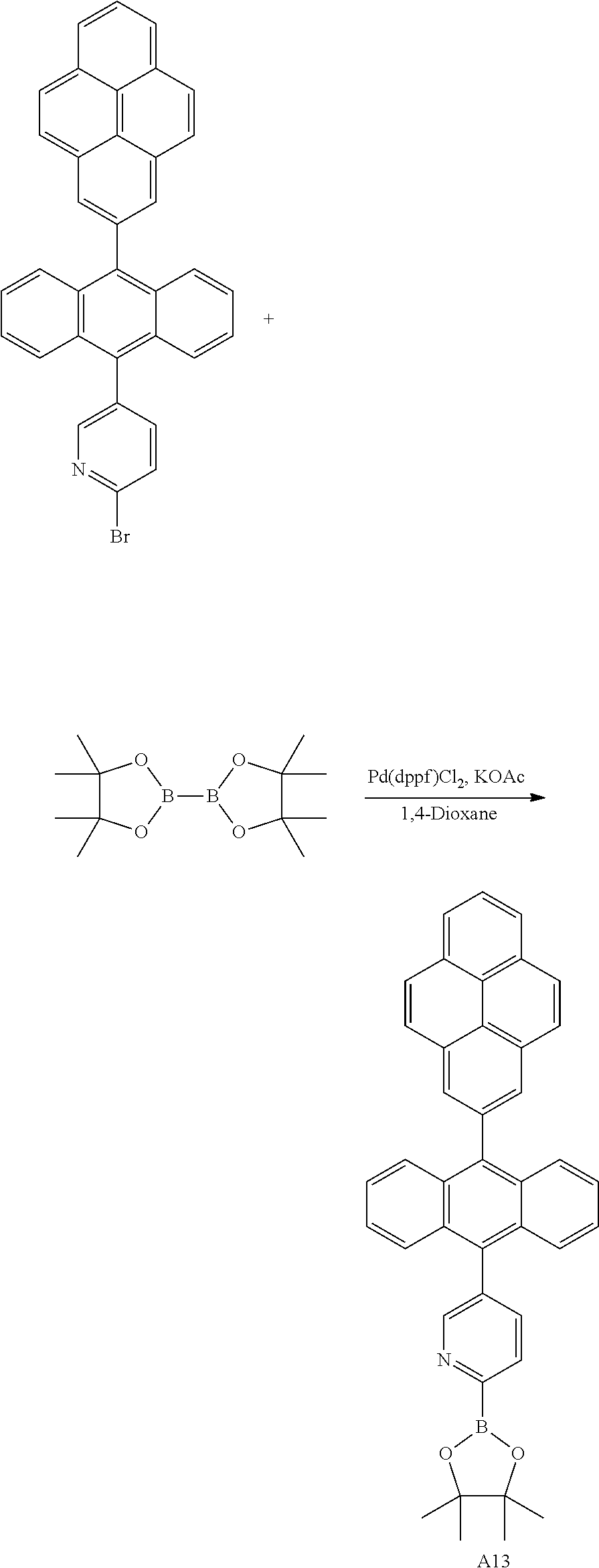

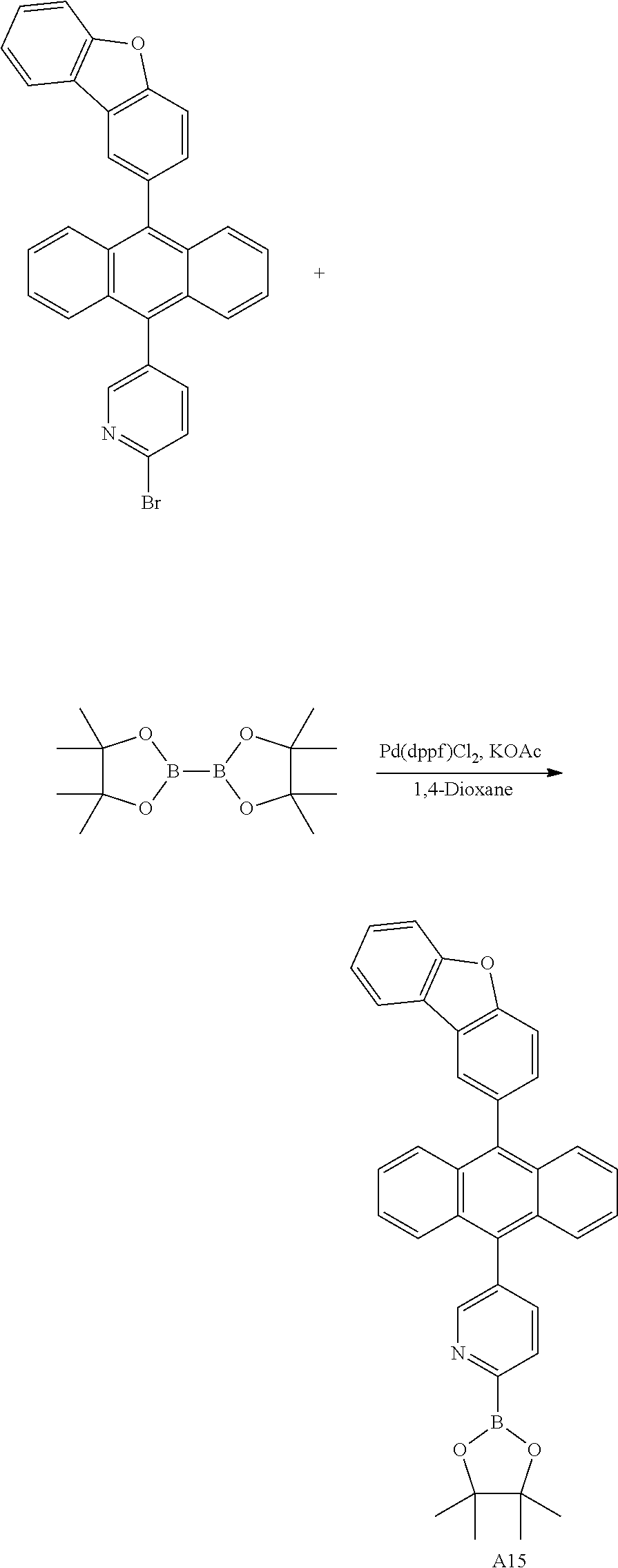
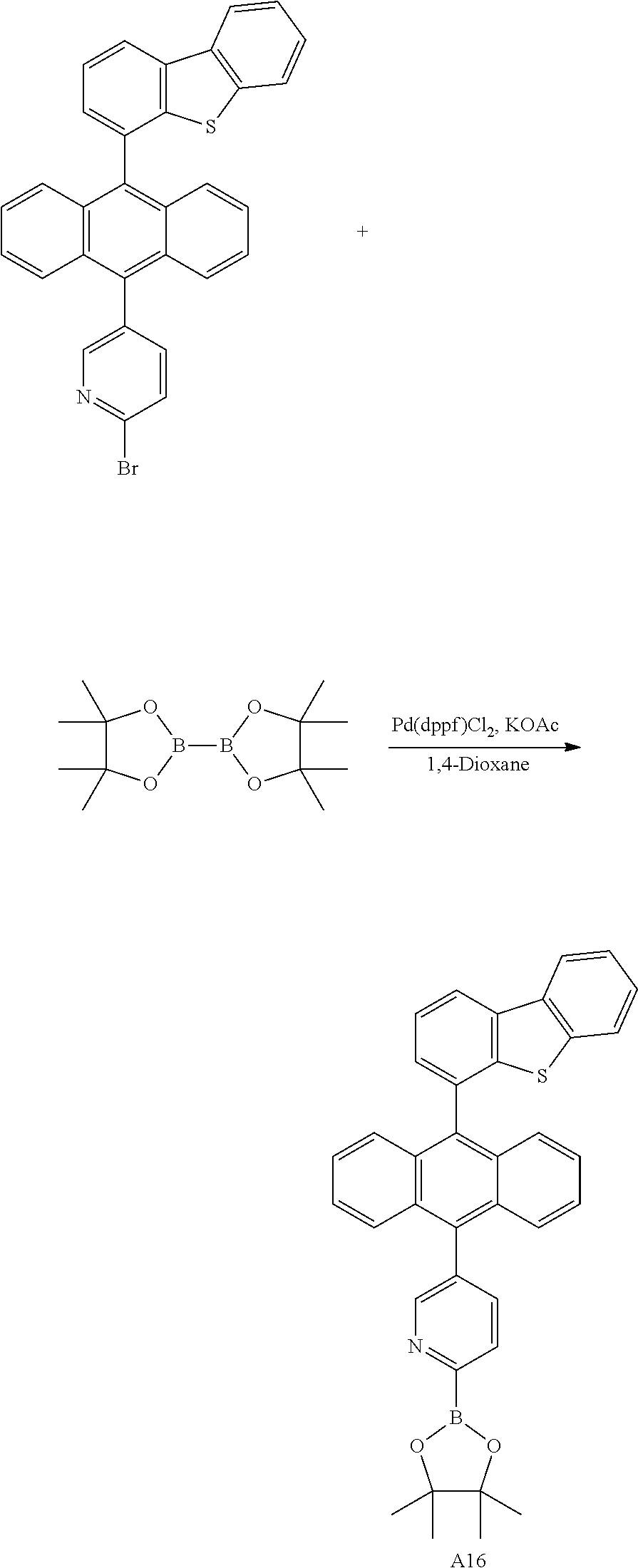
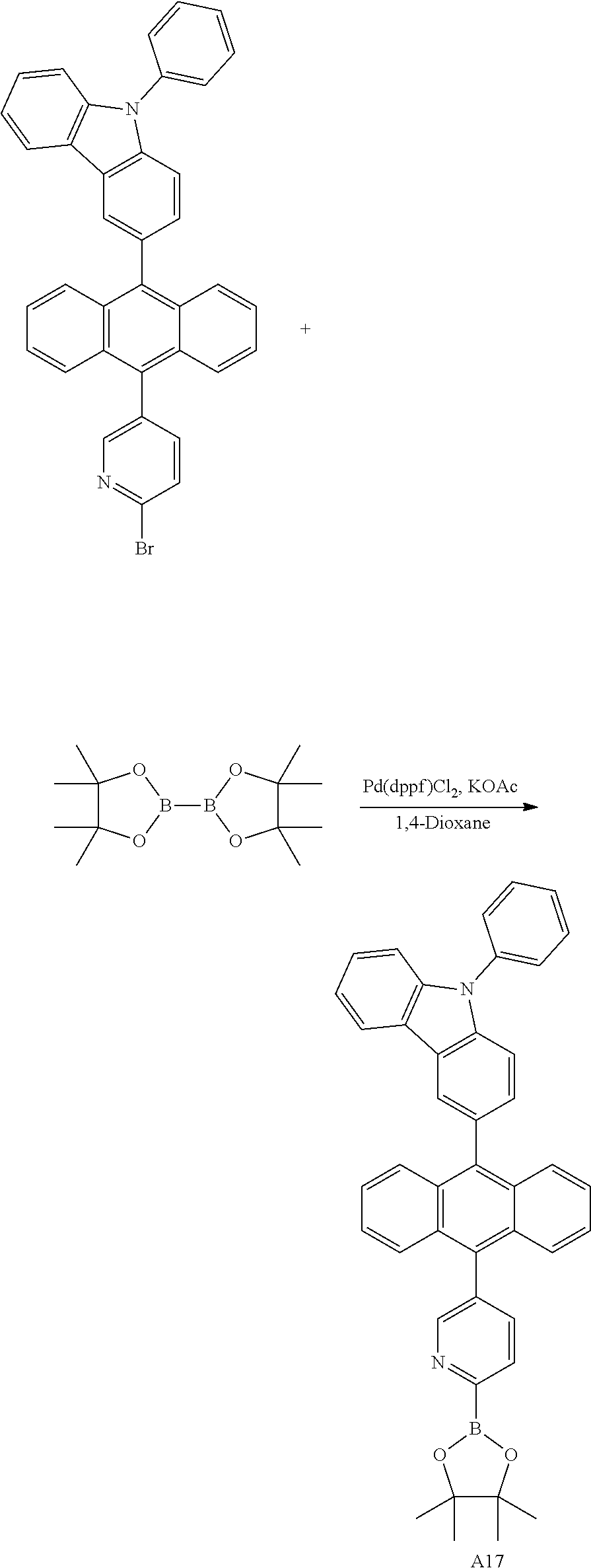

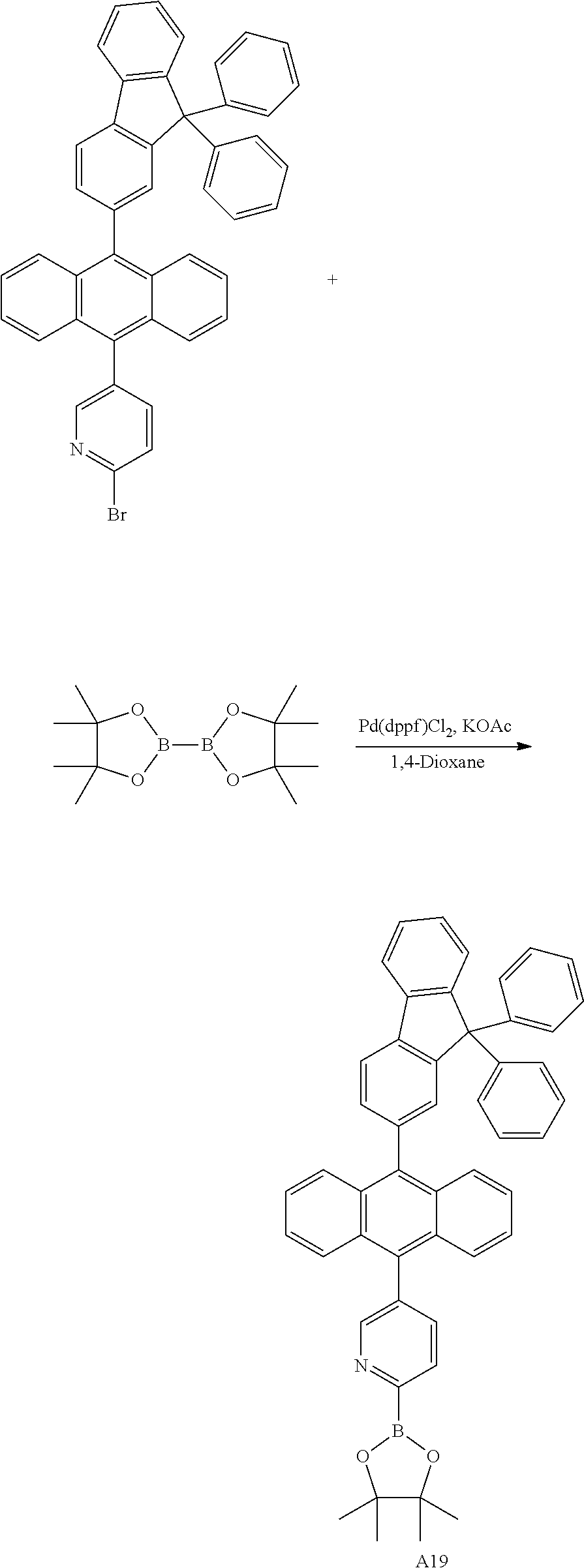

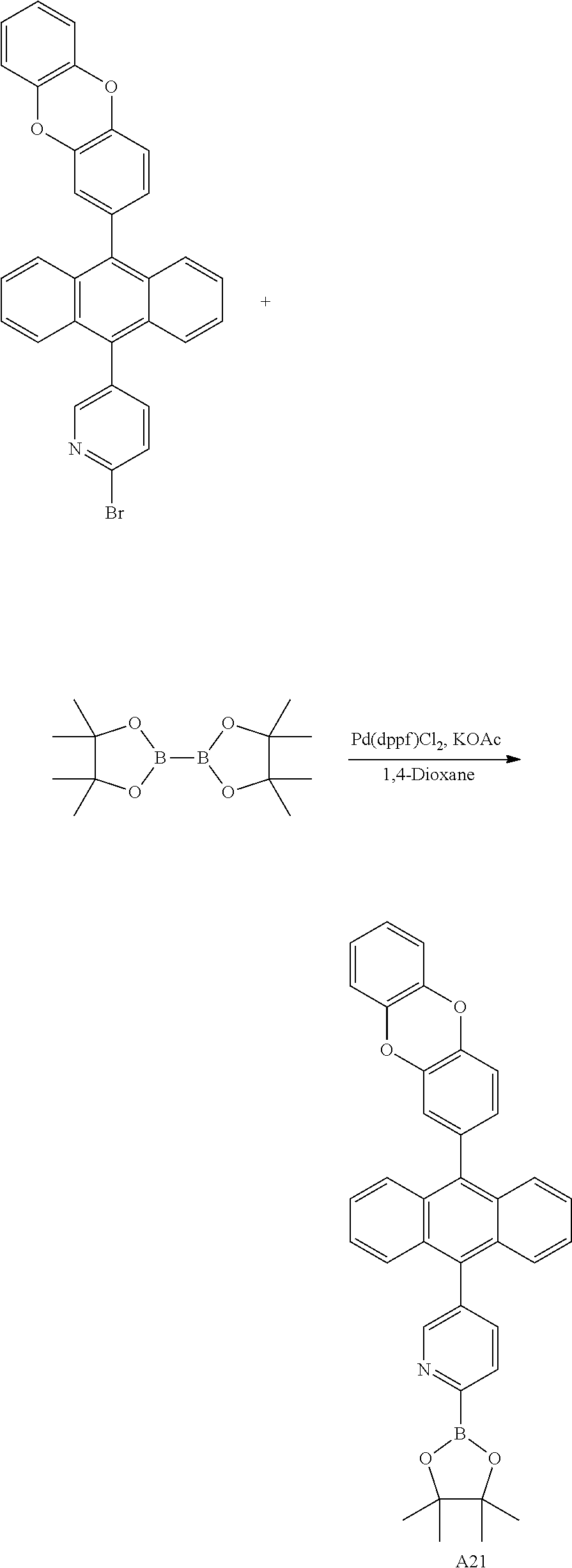





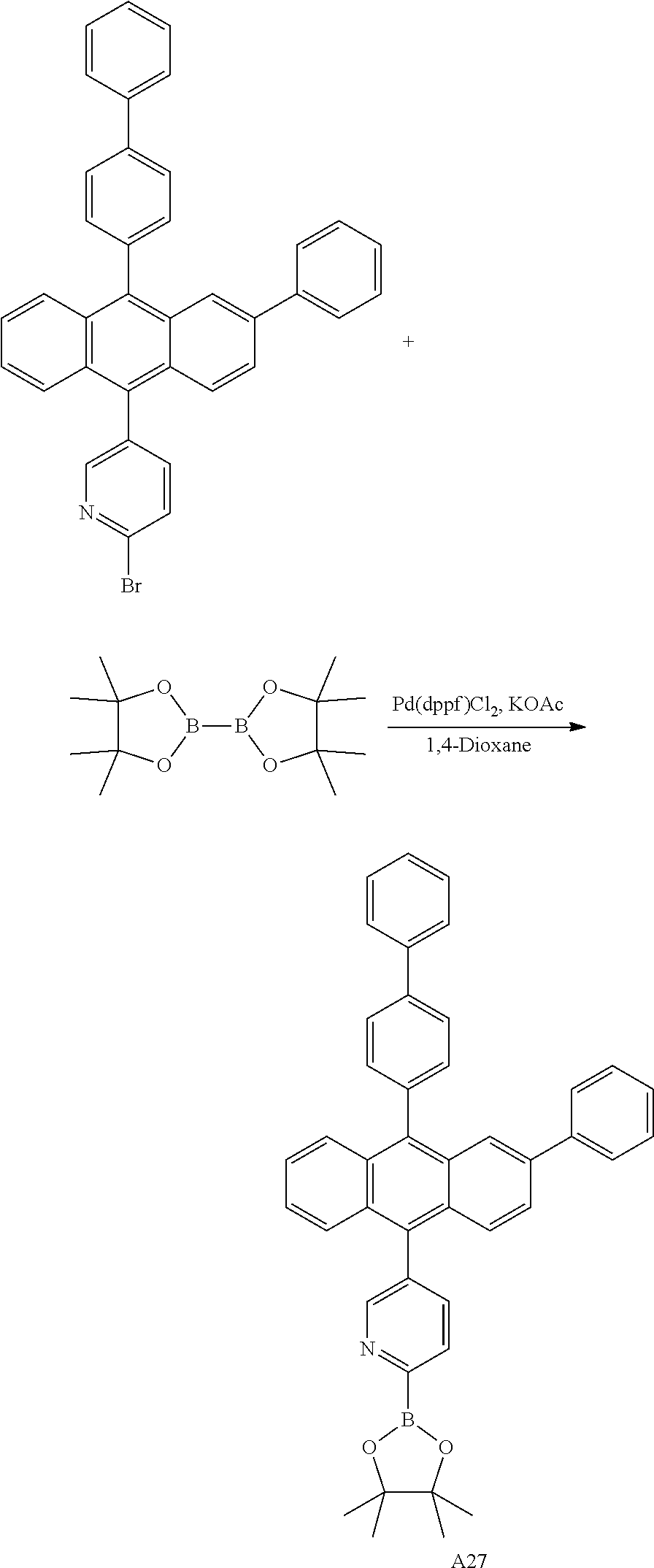

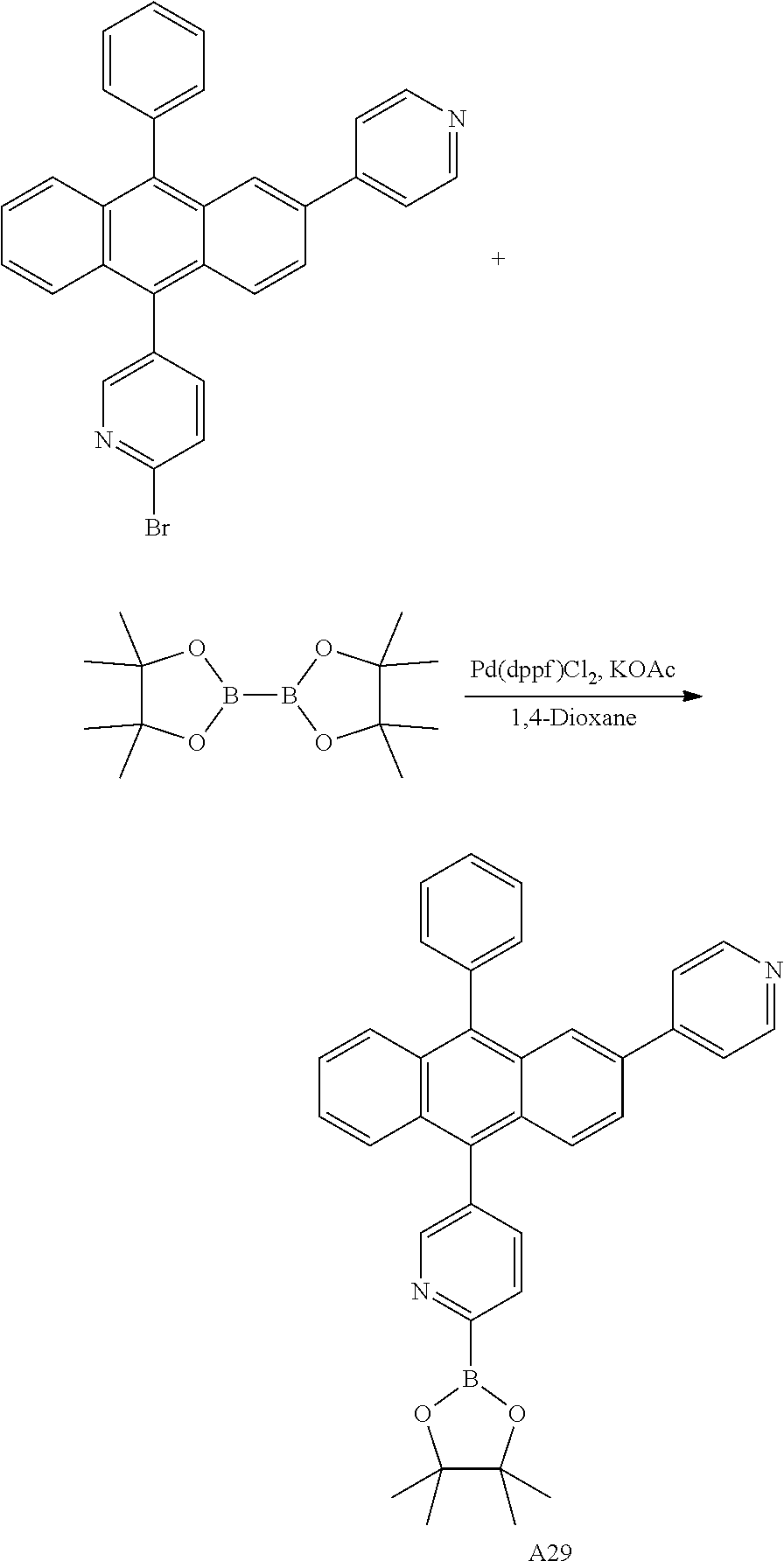





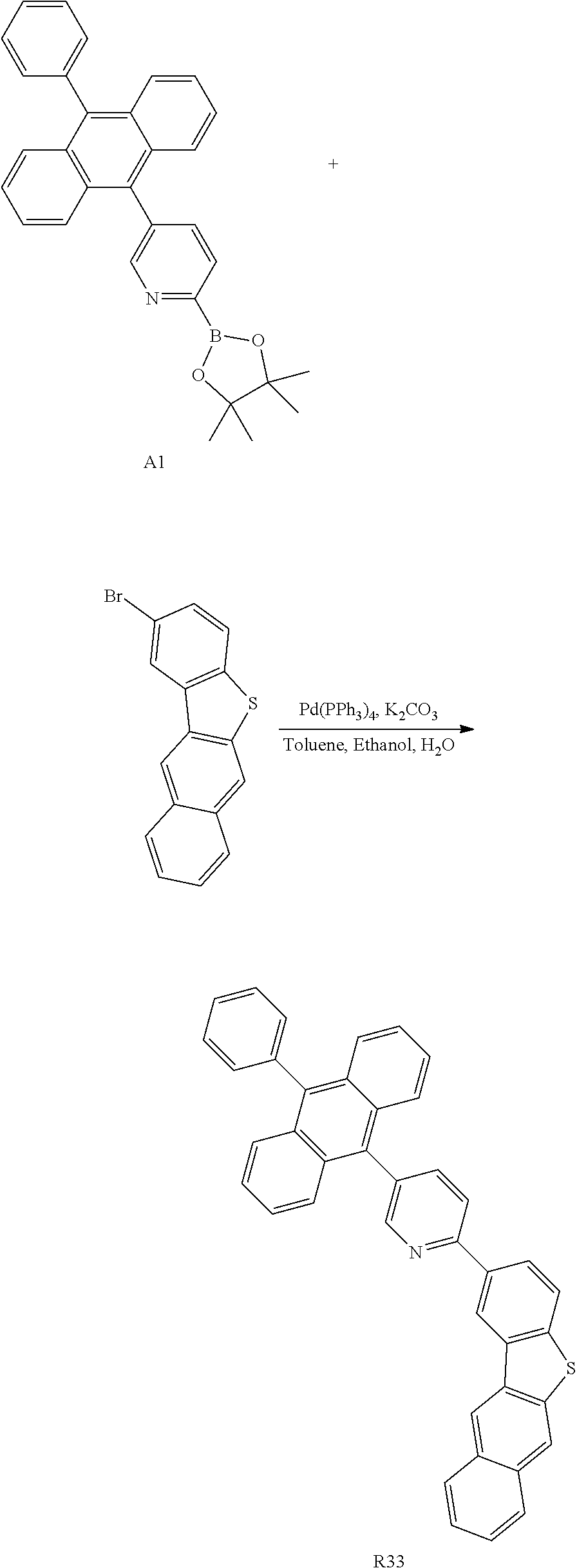
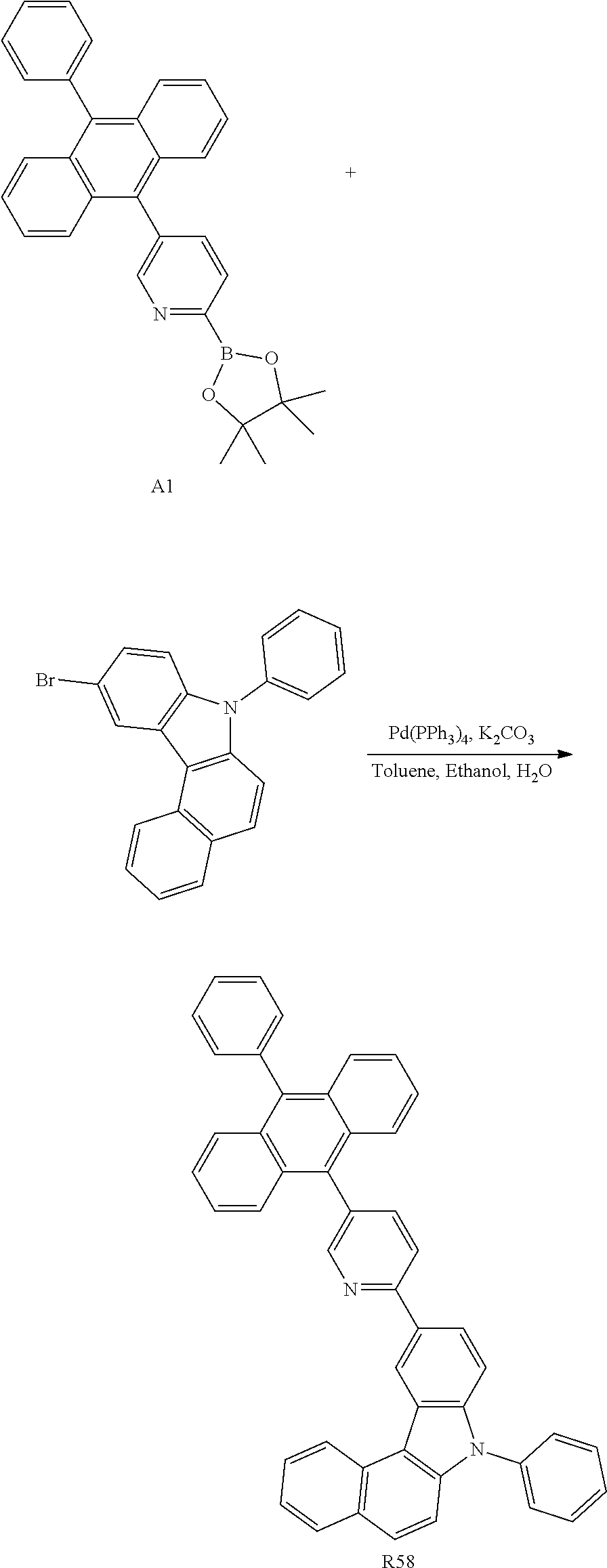
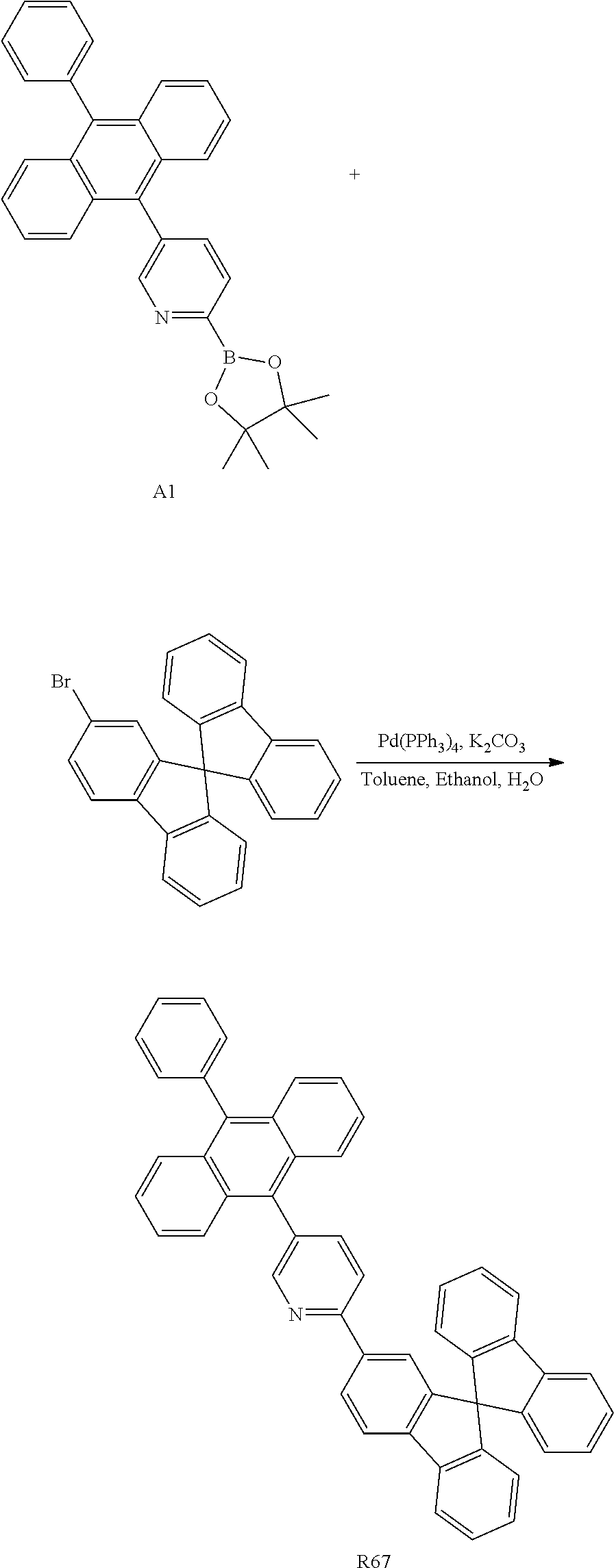
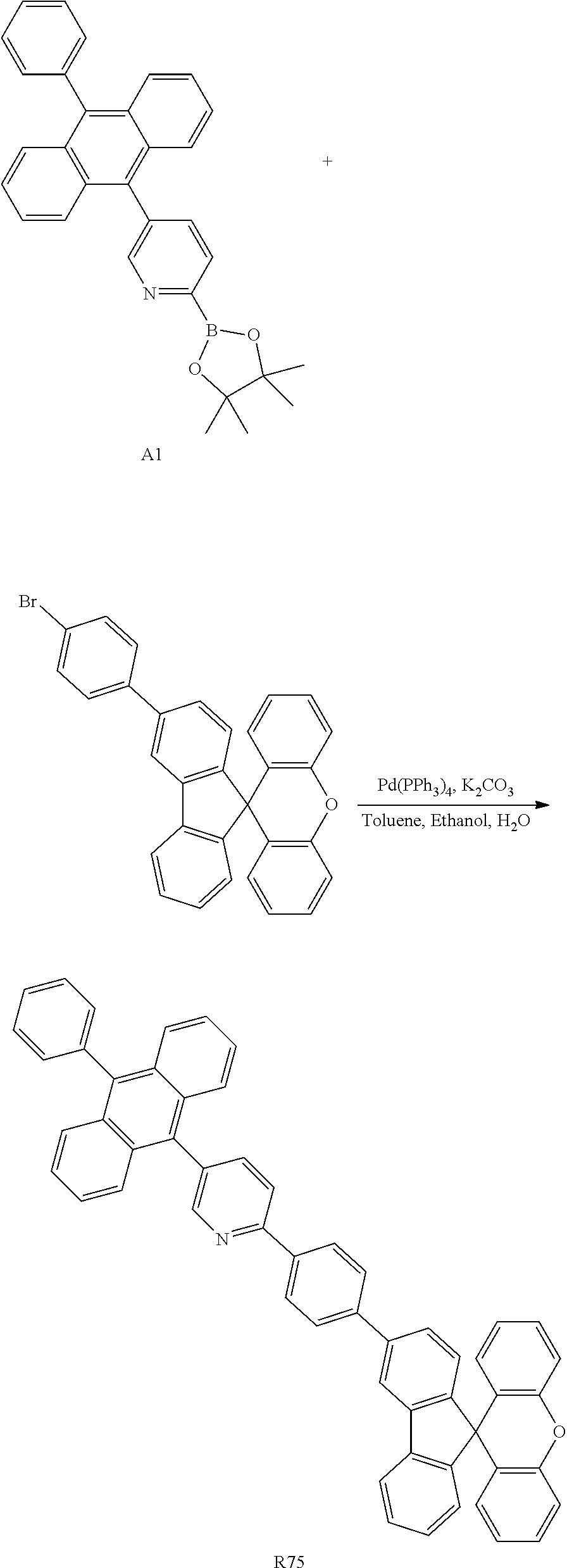














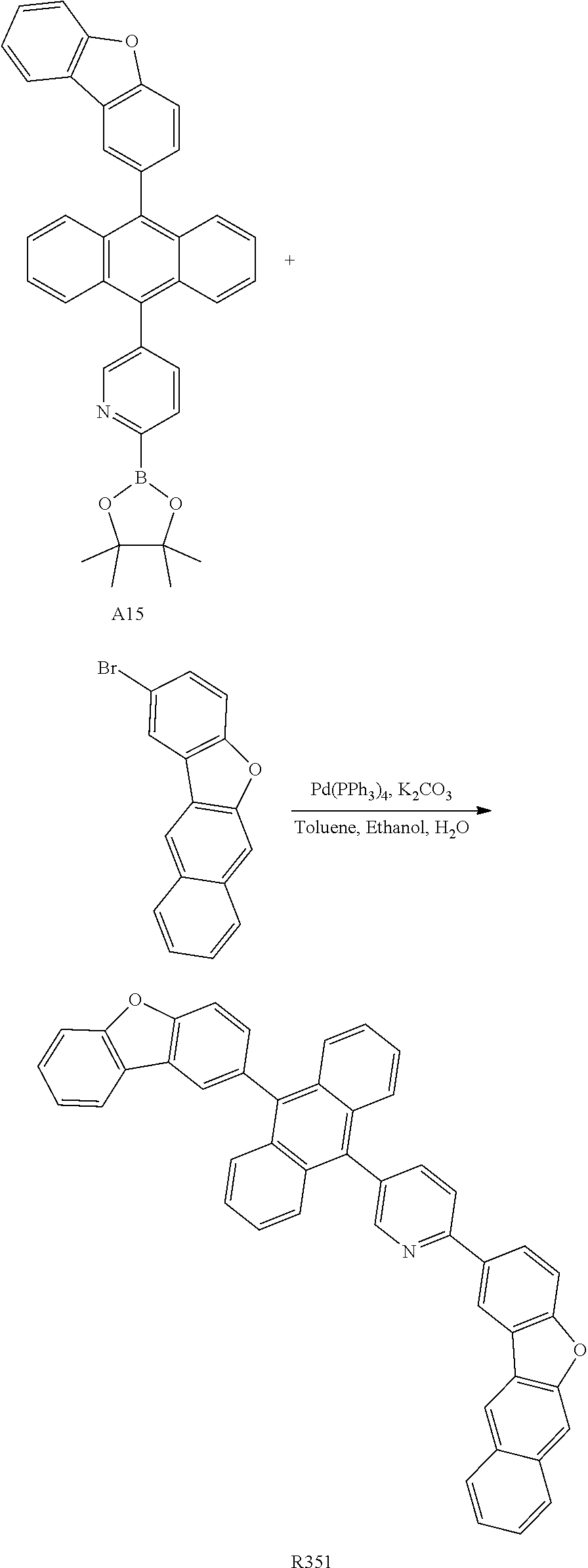
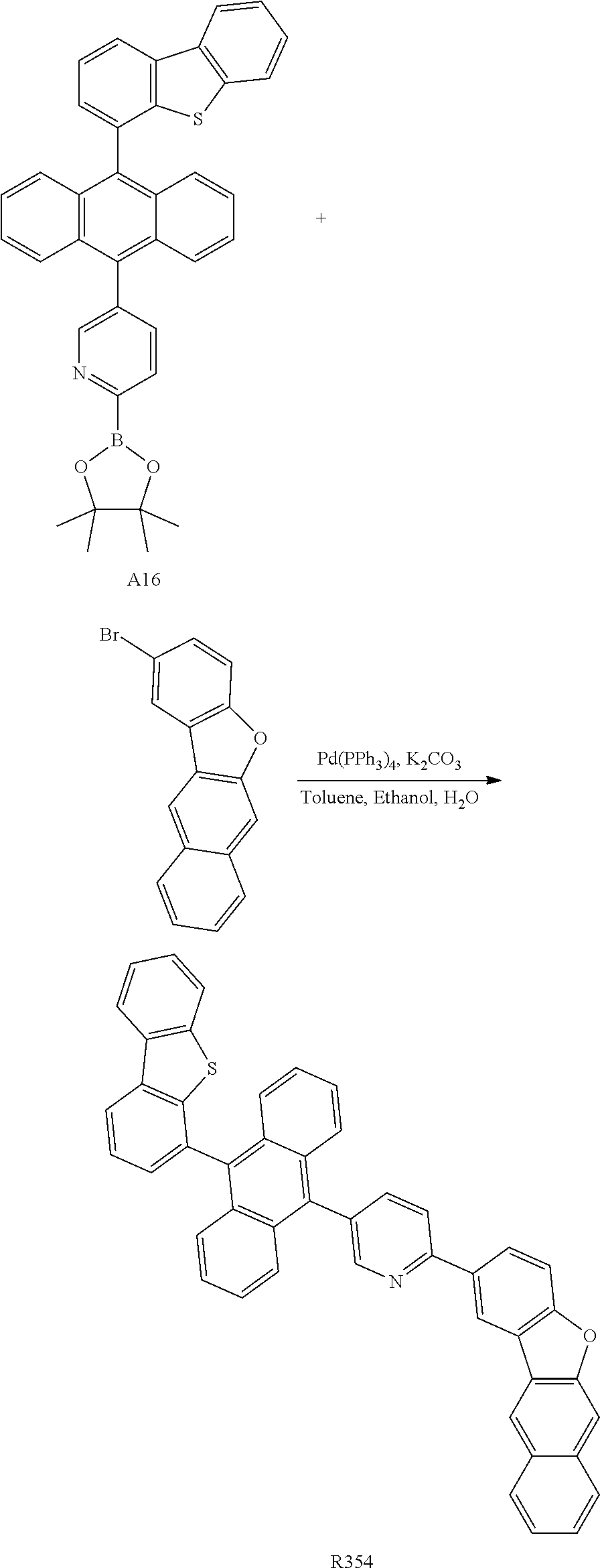


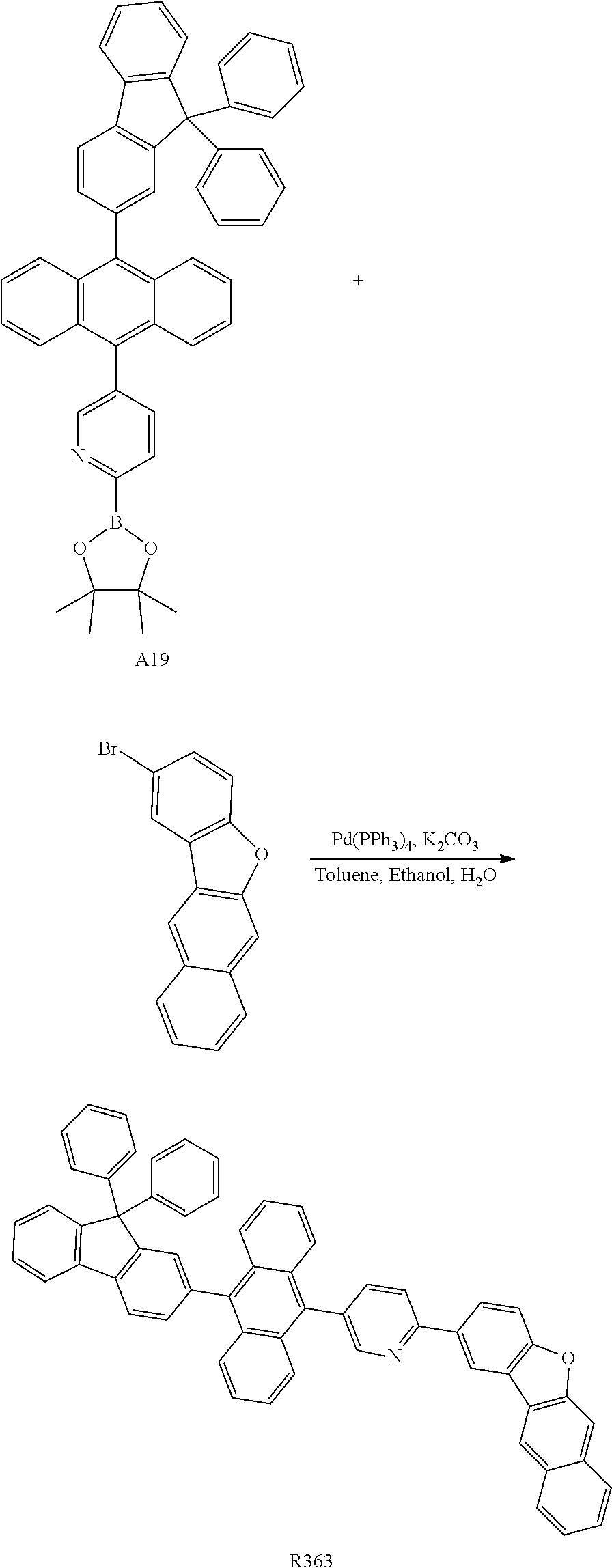



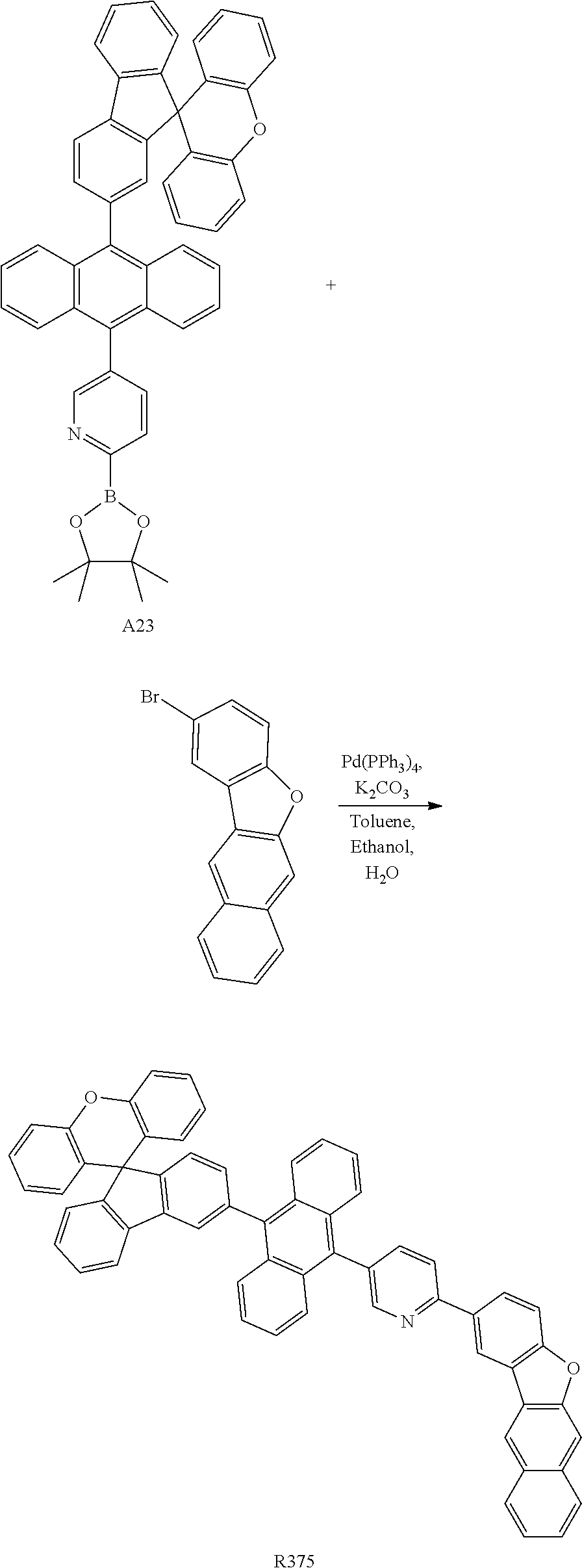
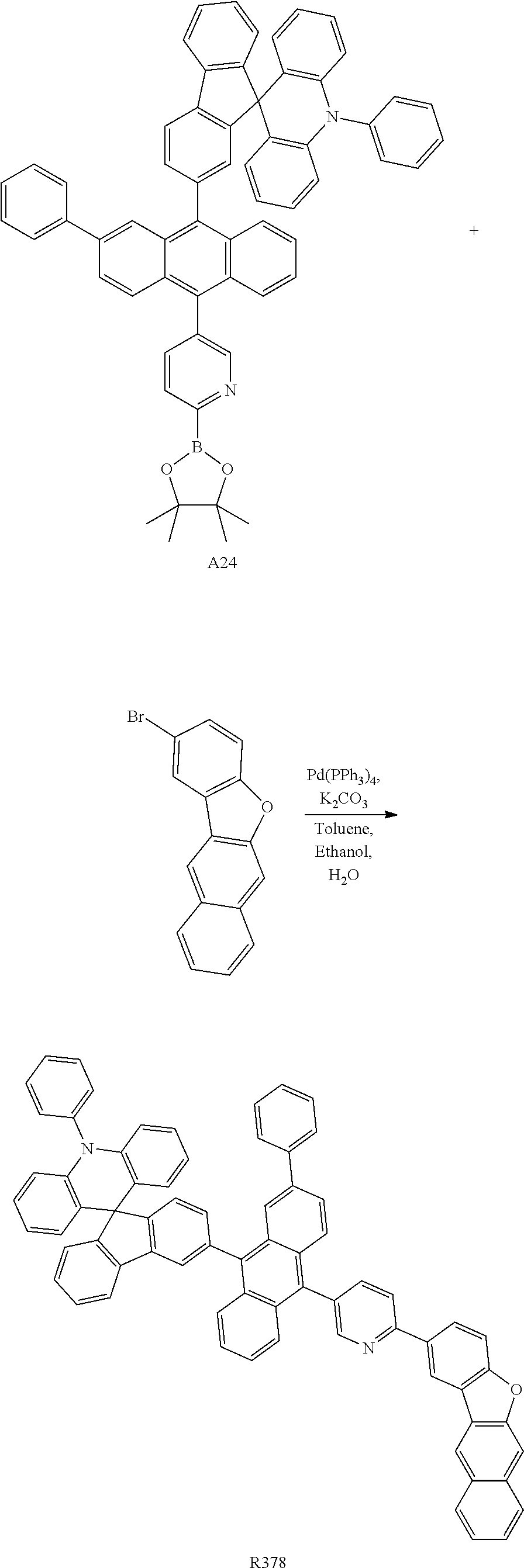



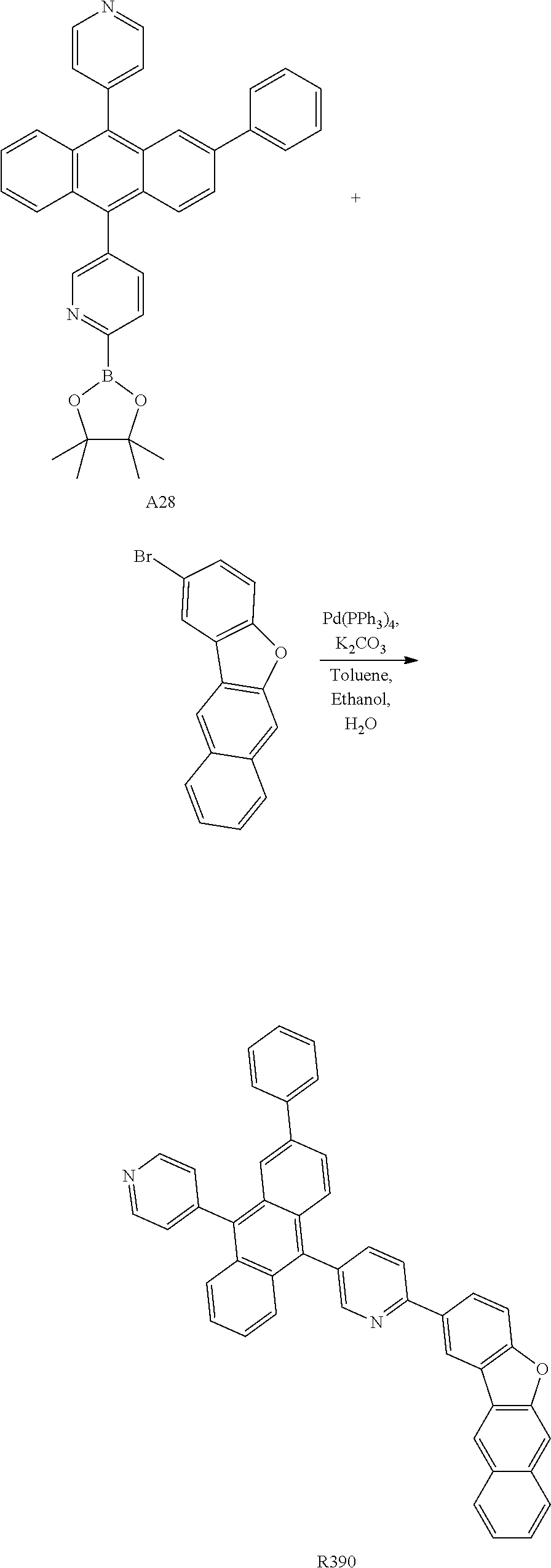

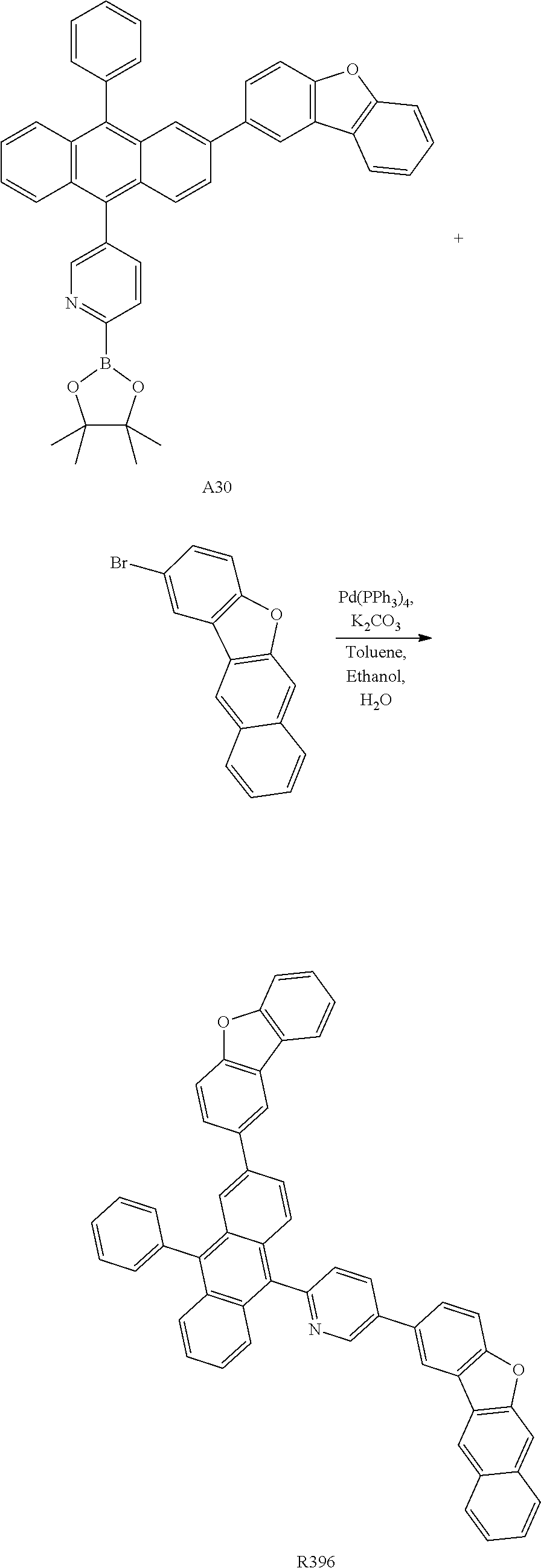
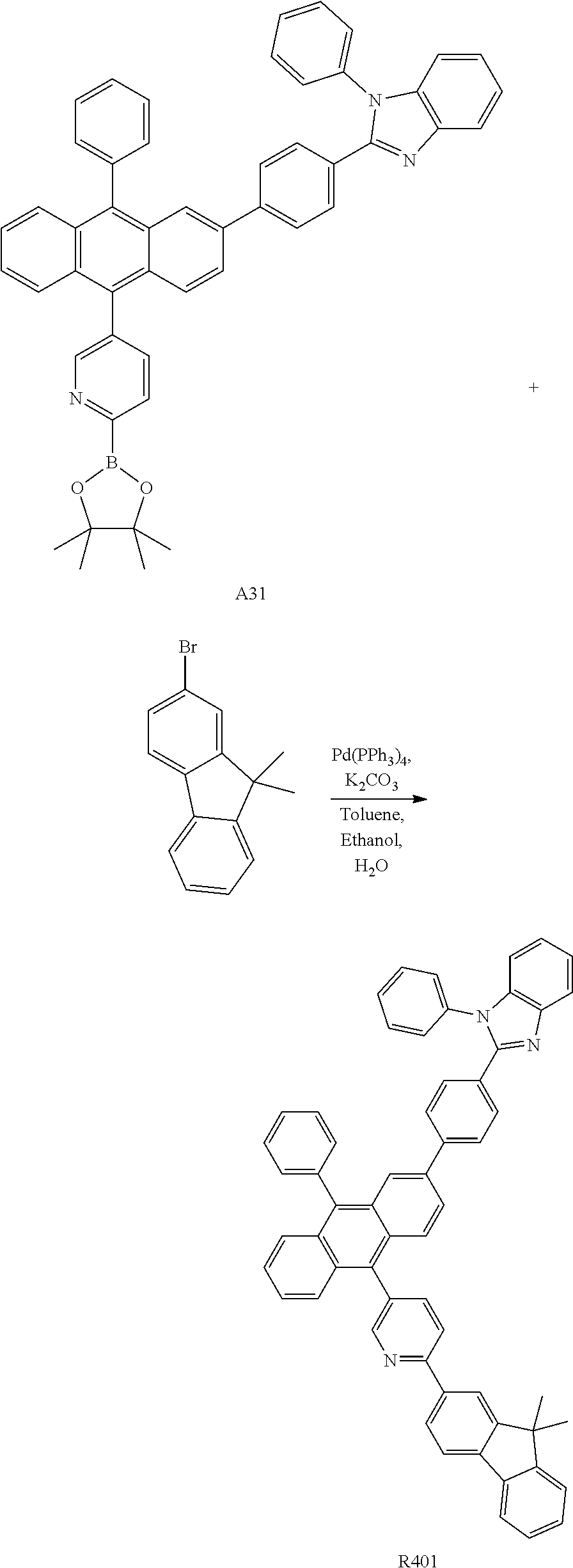
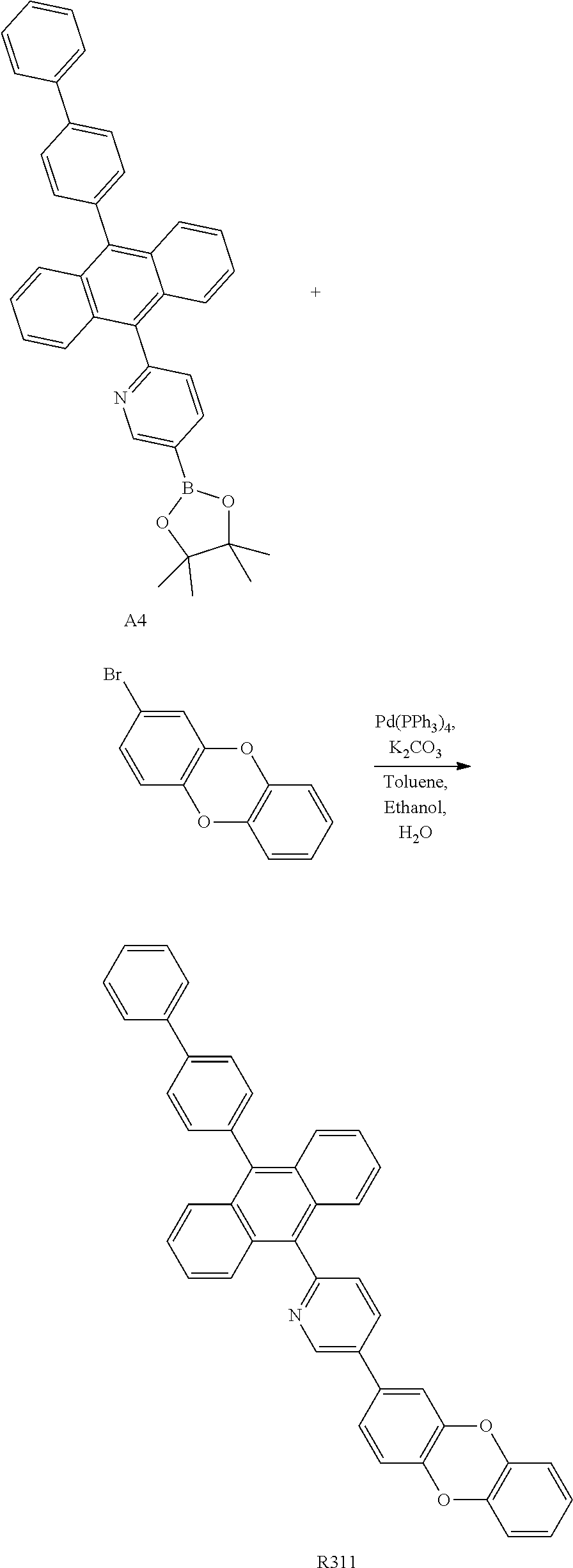










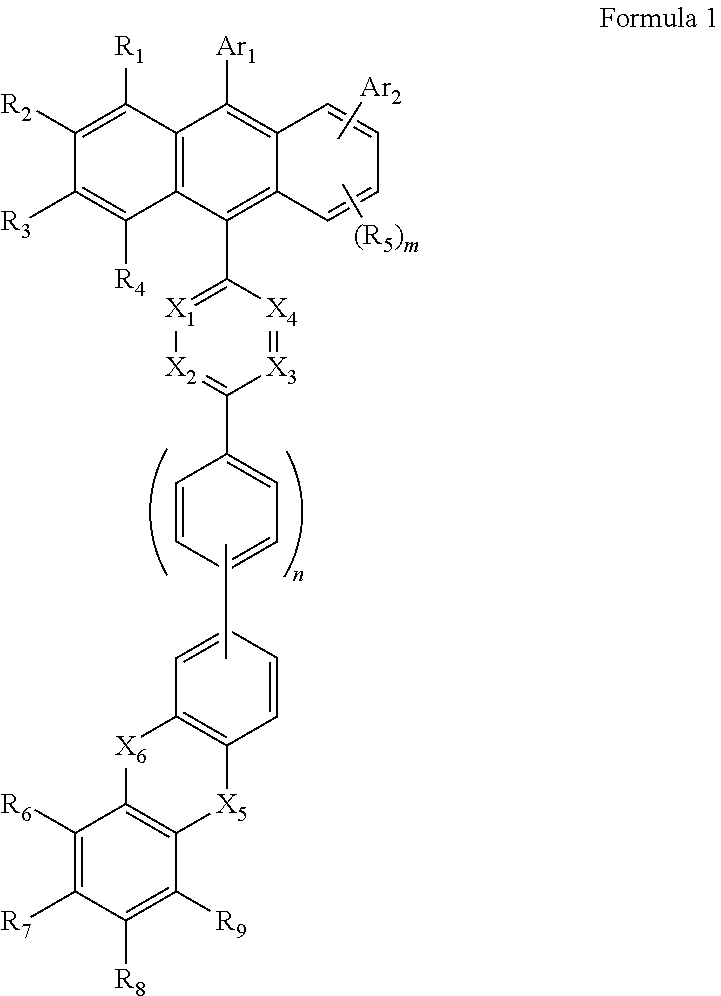



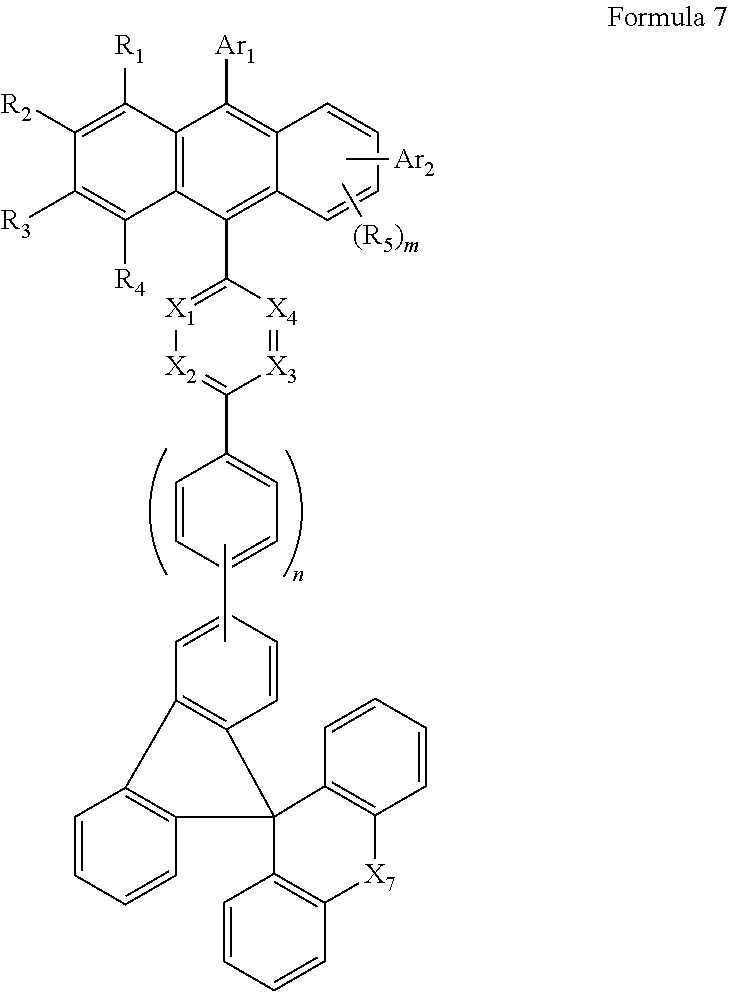
D00000

D00001

XML
uspto.report is an independent third-party trademark research tool that is not affiliated, endorsed, or sponsored by the United States Patent and Trademark Office (USPTO) or any other governmental organization. The information provided by uspto.report is based on publicly available data at the time of writing and is intended for informational purposes only.
While we strive to provide accurate and up-to-date information, we do not guarantee the accuracy, completeness, reliability, or suitability of the information displayed on this site. The use of this site is at your own risk. Any reliance you place on such information is therefore strictly at your own risk.
All official trademark data, including owner information, should be verified by visiting the official USPTO website at www.uspto.gov. This site is not intended to replace professional legal advice and should not be used as a substitute for consulting with a legal professional who is knowledgeable about trademark law.